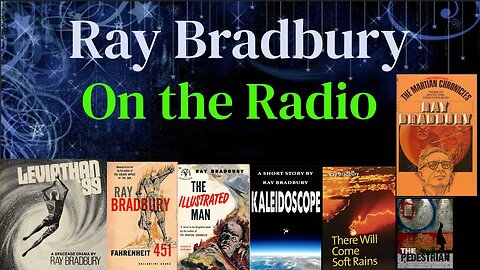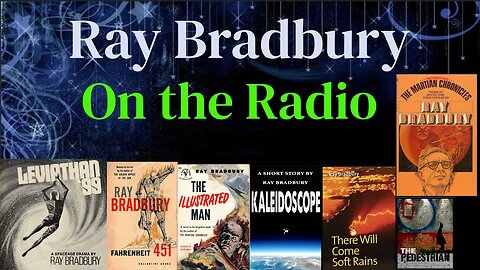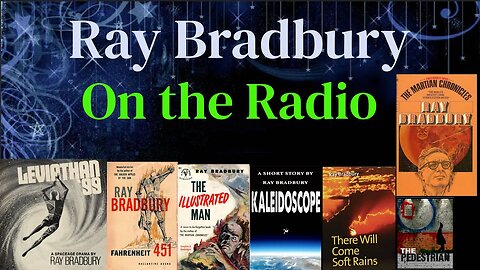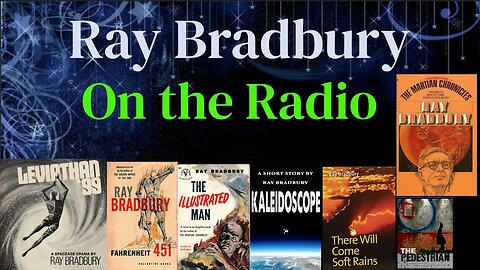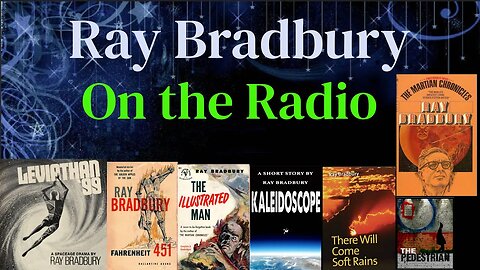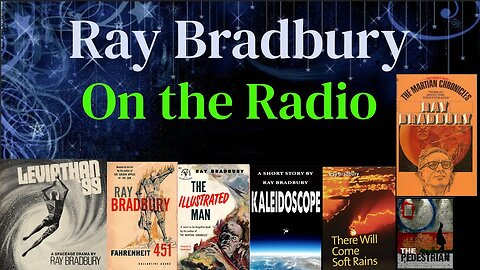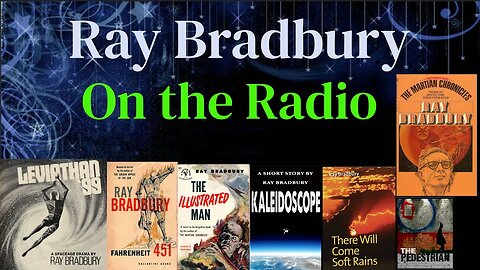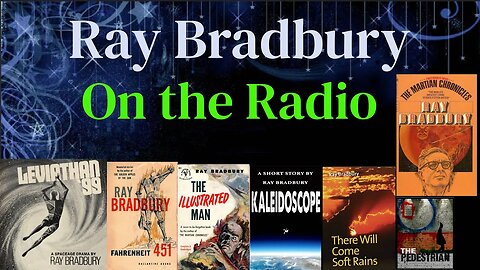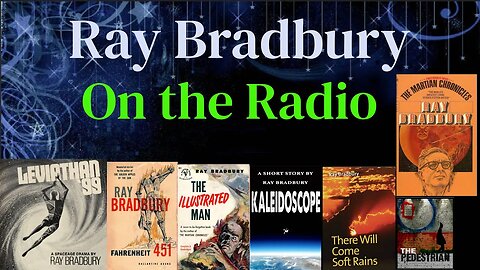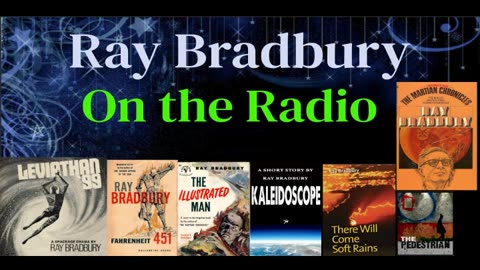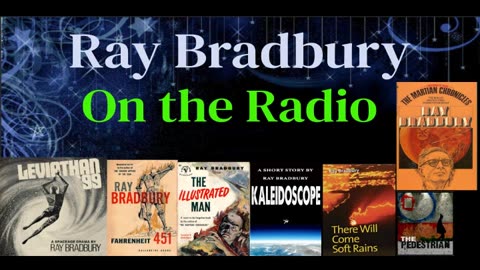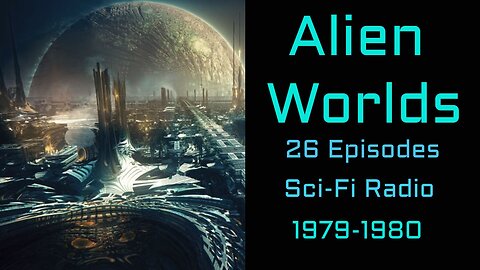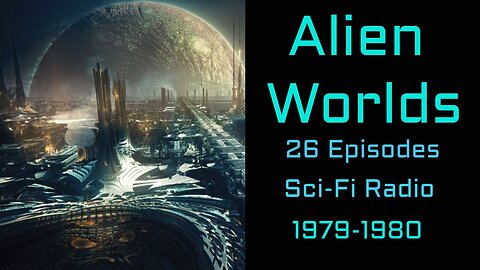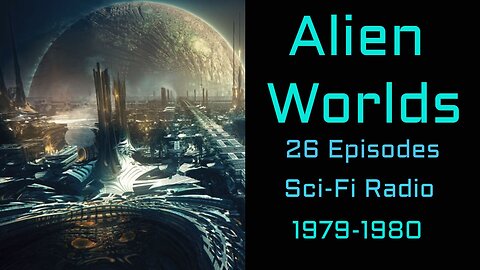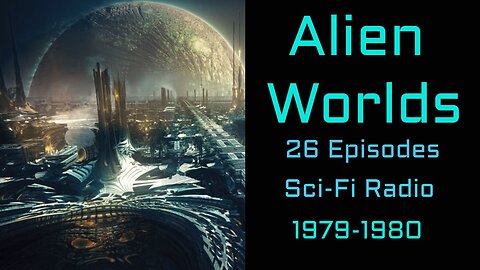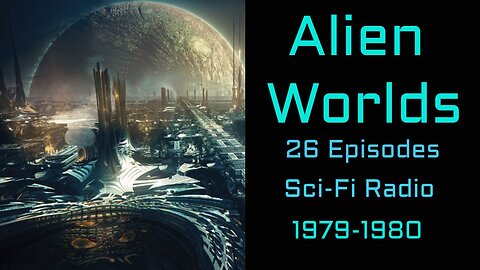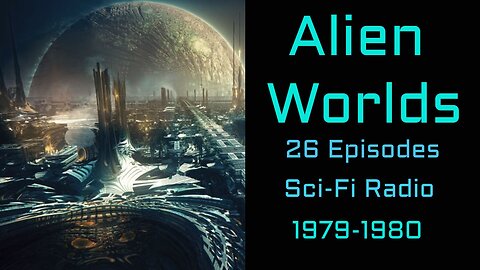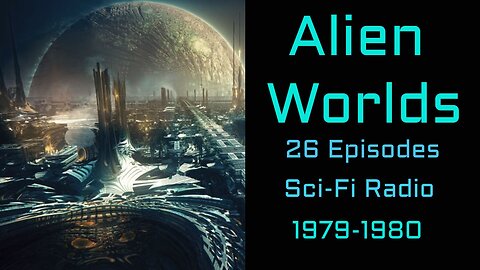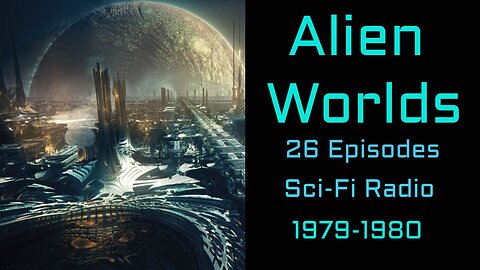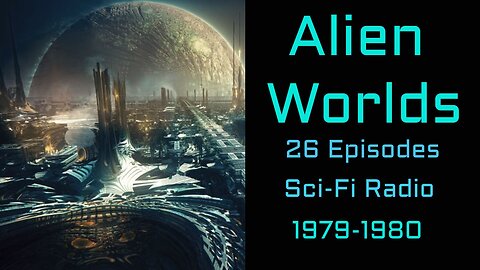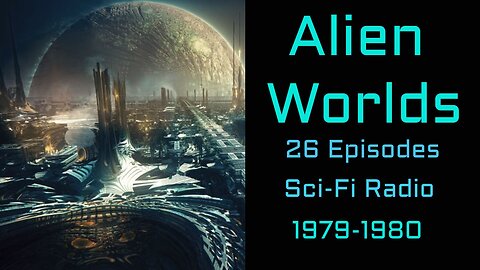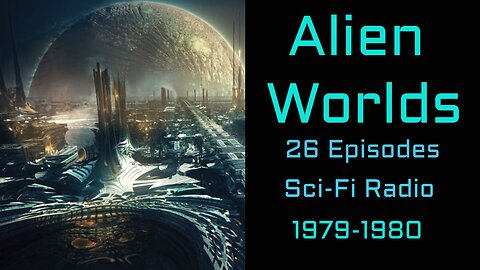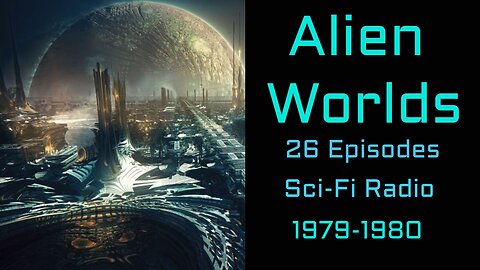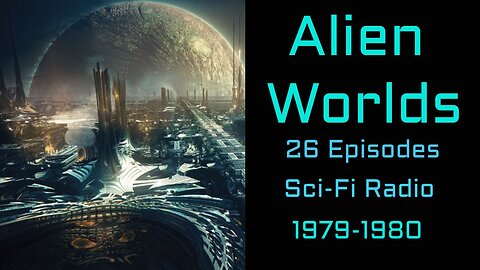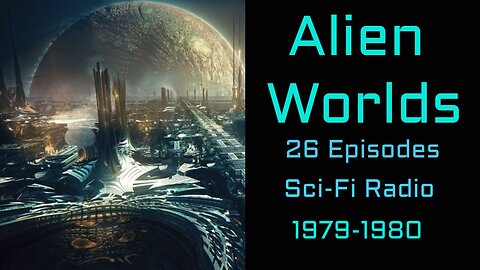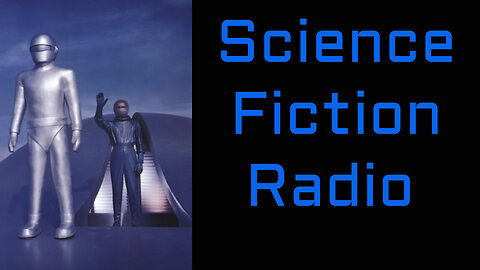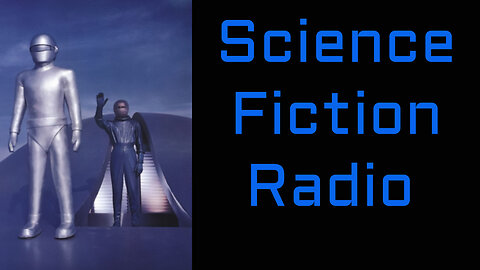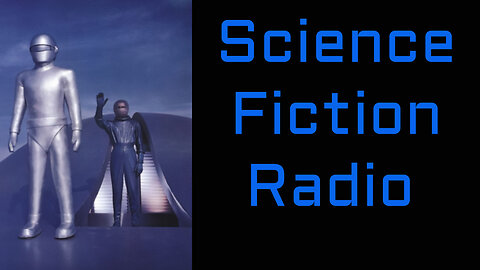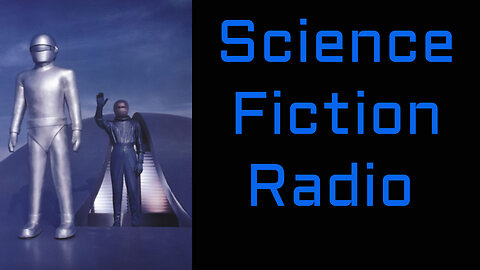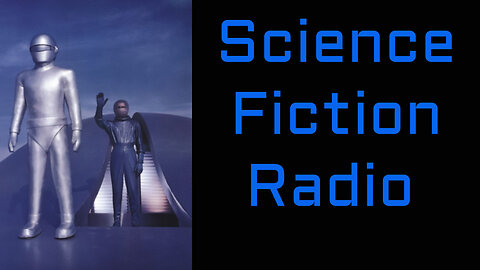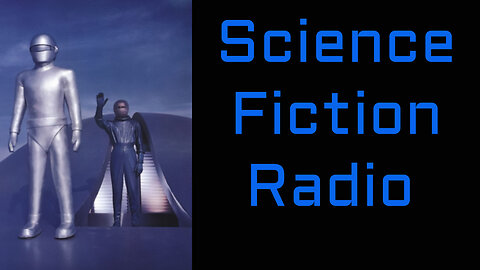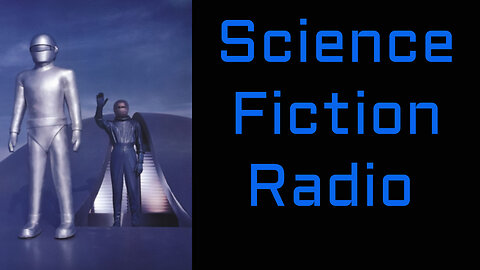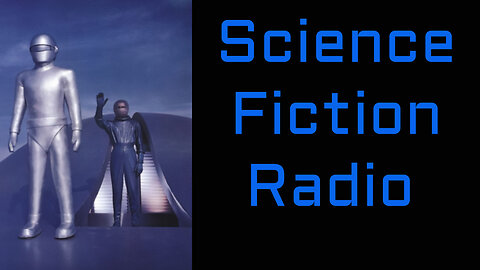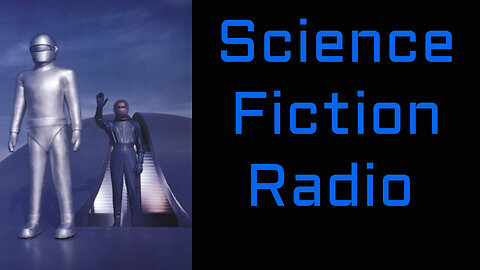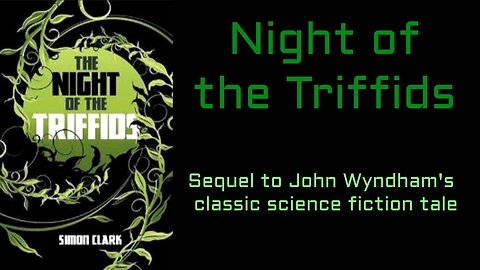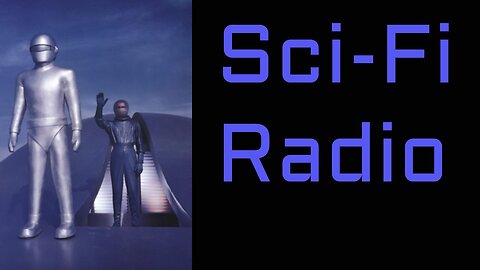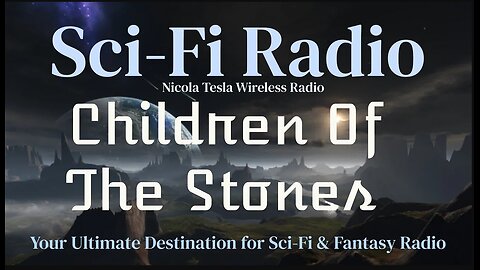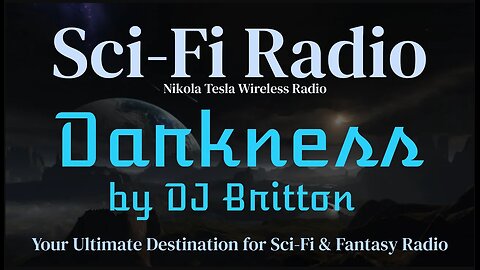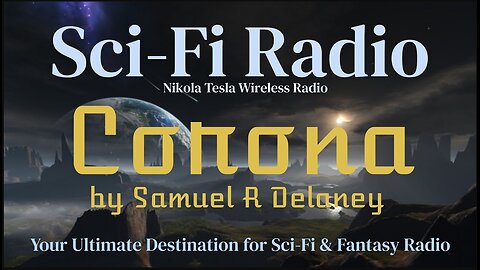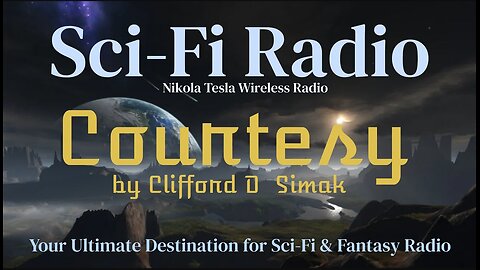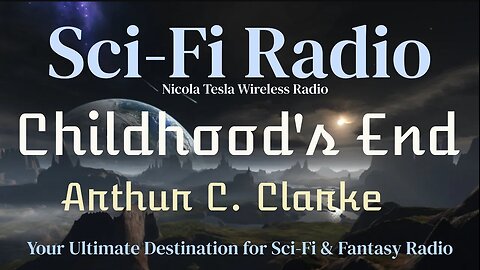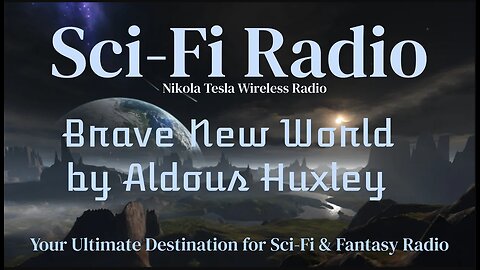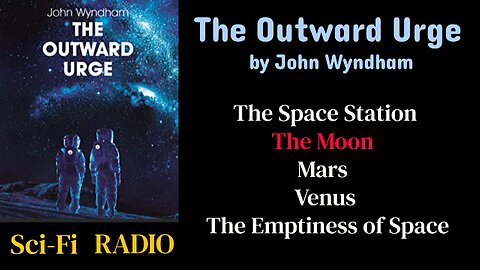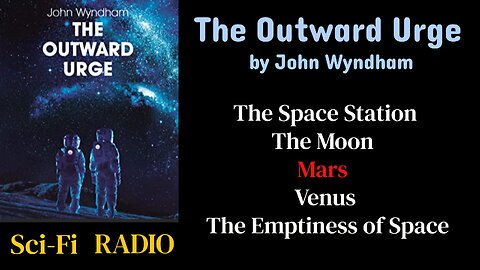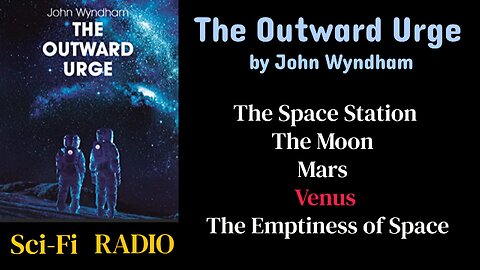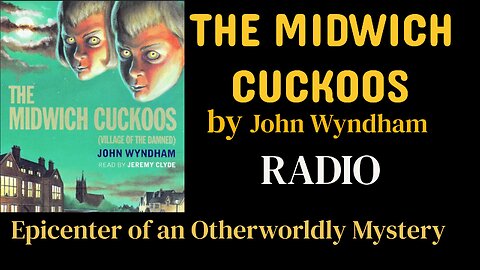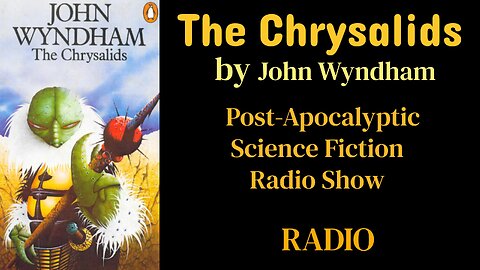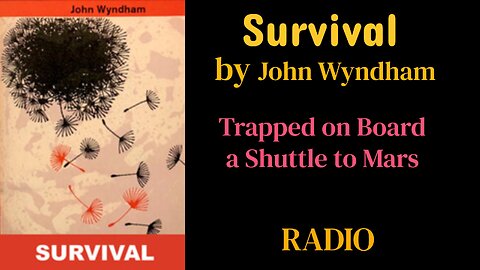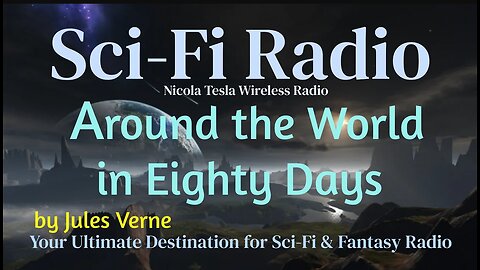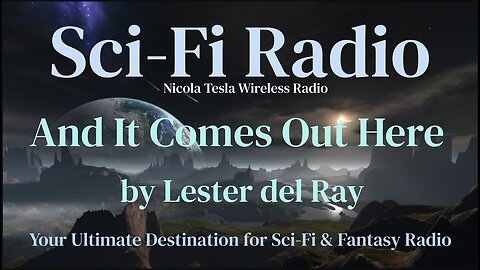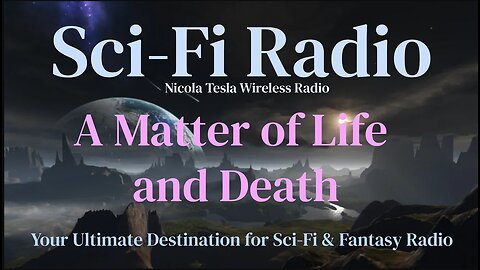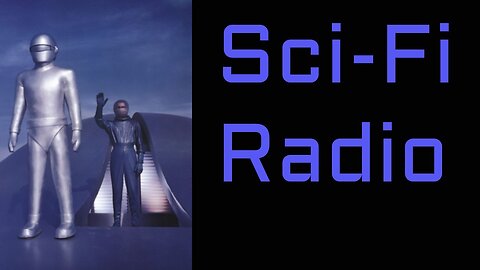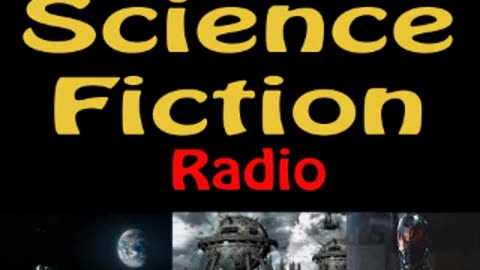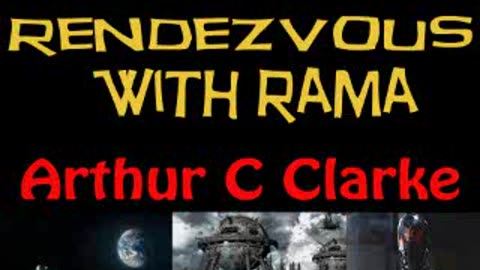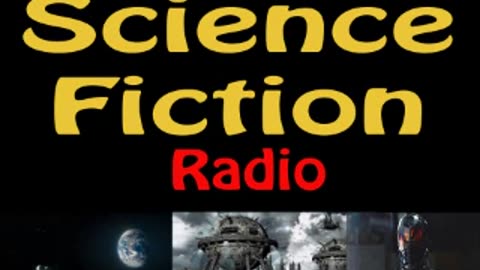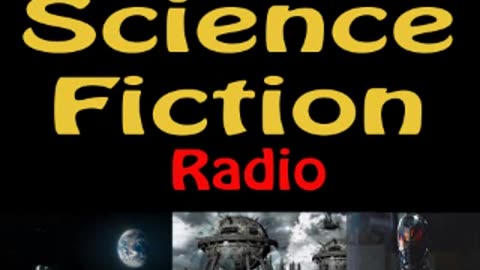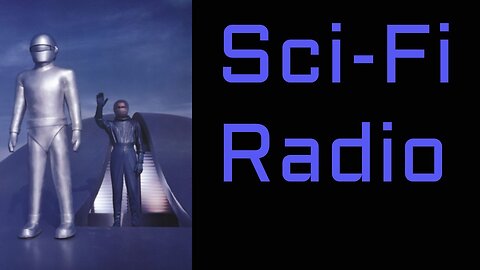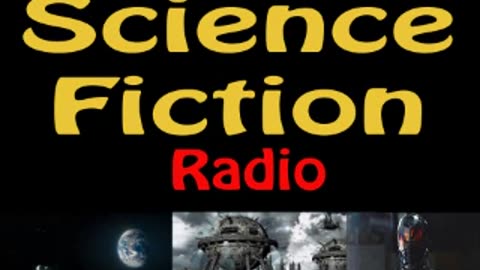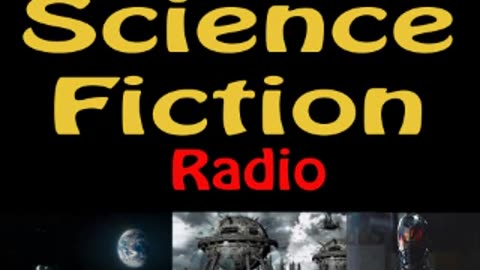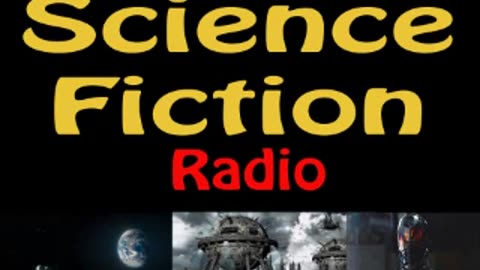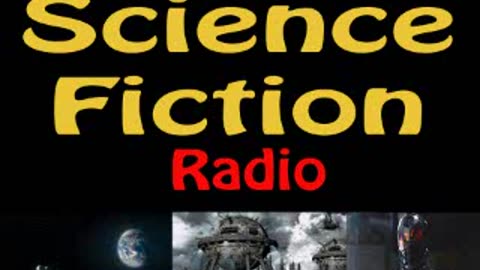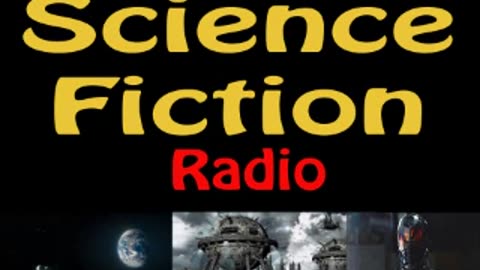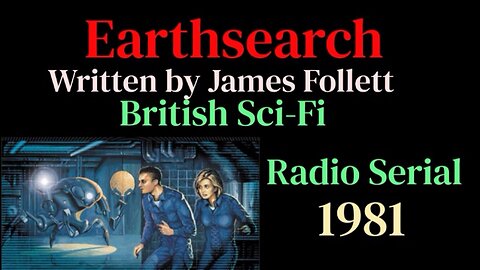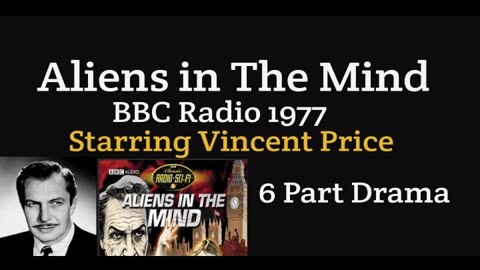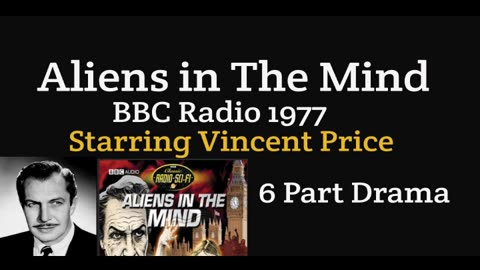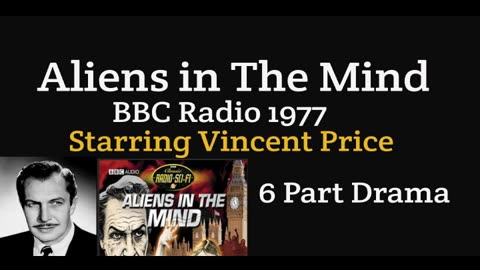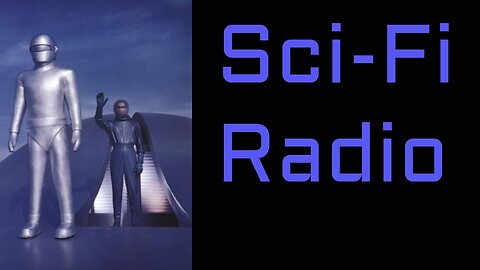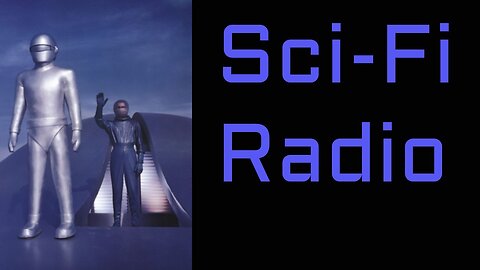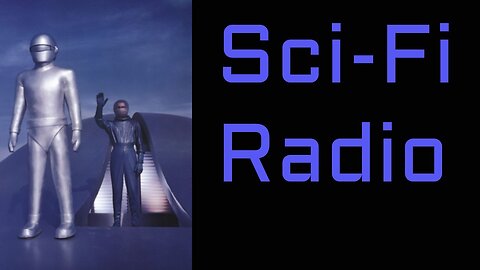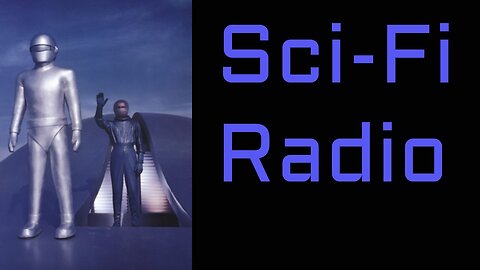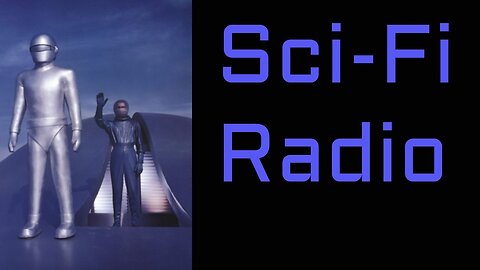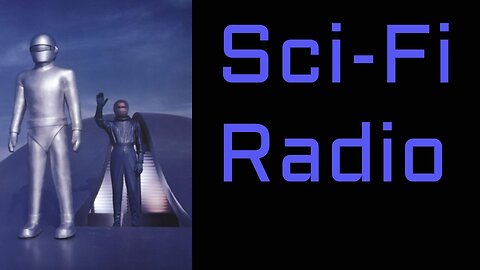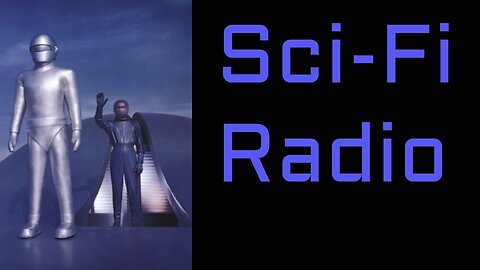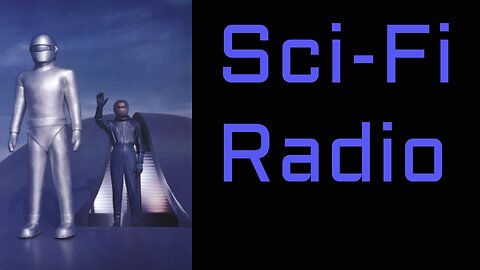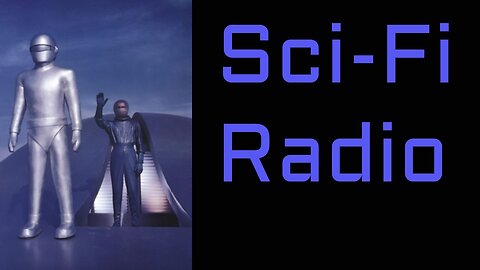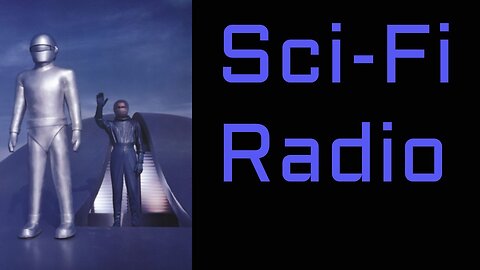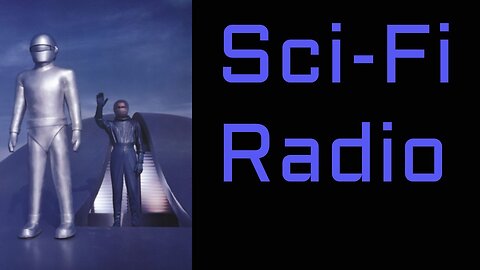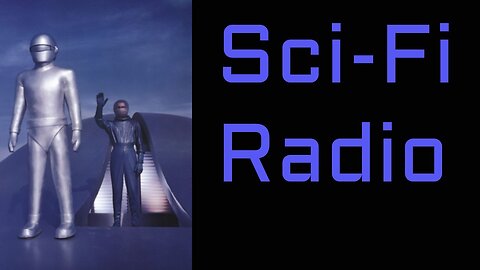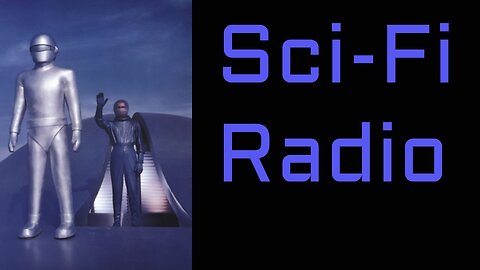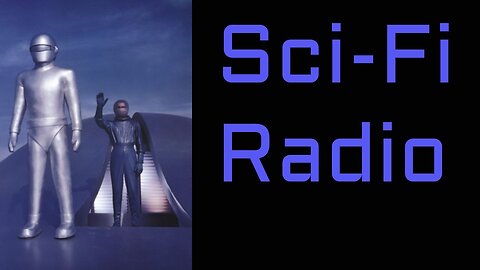Premium Only Content
This video is only available to Rumble Premium subscribers. Subscribe to
enjoy exclusive content and ad-free viewing.

Sci-Fi Radio*
TeslaWirelessRadio
- 4 / 172
1
Ray Bradbury 2014 The Martian Chronicles (Derek Jacobi)
TeslaWirelessRadio
The Martian Chronicles is a science fiction fix-up novel, published in 1950, by American writer Ray Bradbury that chronicles the exploration and settlement of Mars, the home of indigenous Martians, by Americans leaving a troubled Earth that is eventually devastated by nuclear war.
Synopsis
The book projects American society immediately after World War II into a technologically advanced future where the amplification of humanity's potentials to create and destroy have both miraculous and devastating consequences.
Events in the chronicle include the apocalyptic destruction of both Martian and human civilizations, both instigated by humans, though there are no stories with settings at the catastrophes. The outcomes of many stories raise concerns about the values and direction of America of the time by addressing militarism, science, technology, and war time prosperity that could result in a global nuclear war.
2
comments
2
The Kraken Wakes by John Wyndham (Apocalyptic Sci-fi Show)
TeslaWirelessRadio
The Kraken Wakes is an apocalyptic science fiction novel by John Wyndham, originally published by Michael Joseph in the United Kingdom in 1953, and first published in the United States in the same year by Ballantine Books under the title Out of the Deeps as a mass market paperback.
The novel is structured as a book within a book. After a short scene-setting introduction, the novel is the book written by the protagonist, radio reporter Mike Watson, chronicling the events that took place when creatures from the deeps of the ocean attack humanity.
Mike and his wife Phyllis work for the English Broadcasting Company (EBC) so are privy to decisions by government and scientific authorities who alternatively try to counter the alien's moves or stifle or massage news to prevent panic. The aliens are never seen, and their origin and level of intelligence, if any, are never discerned. They are only known by their acts of violence against humanity, and their weapons of choice are not of the sort envisioned by humanity.
The title is a reference to Alfred Tennyson's sonnet The Kraken.
Plot
The novel describes the course of an attack on humanity by creatures from the ocean depths, as told through the eyes of Mike Watson, who works for the English Broadcasting Company (EBC) with his wife and co-reporter Phyllis. A major role is also played by Professor Alastair Bocker – more clear-minded and far-sighted about the developing crisis than everybody else but often alienating people by telling brutally unvarnished and unwanted truths.
Mike and Phyllis are witness to several events of the invasion, which proceeds in drawn-out phases; it takes years before the bulk of humanity even realizes that the world has been invaded. In the first phase, objects from outer space land in the oceans. Mike and Phyllis happen to see five of the "fireballs" falling into the sea, from the ship where they are sailing on their honeymoon. Eventually the distribution of the objects' landing points – always at ocean depths, never on land – implies intelligence.
3
Do Androids Dream of Electric Sheep by Philip K Dick
TeslaWirelessRadio
Do Androids Dream of Electric Sheep? (retrospectively titled Blade Runner: Do Androids Dream of Electric Sheep? in some later printings) is a 1968 dystopian science fiction novel by American writer Philip K. Dick. It is set in a post-apocalyptic San Francisco, where Earth's life has been greatly damaged by a nuclear global war, leaving most animal species endangered or extinct.
The main plot follows Rick Deckard, a bounty hunter who has to "retire" (i.e. kill) six escaped Nexus-6 model androids, while a secondary plot follows John Isidore, a man of sub-par IQ who aids the fugitive androids.
The book served as the basis for the 1982 film Blade Runner and, even though some aspects of the novel were changed, many elements and themes from it were used in the film's 2017 sequel Blade Runner 2049.
Plot summary
Rick Deckard, a bounty hunter for the San Francisco Police Department, is assigned to "retire" (kill) six androids of the new Nexus-6 model which have recently escaped from Mars and traveled to Earth.
These androids are made of organic matter so similar to a human's that only a "bone marrow analysis" can prove the difference, making them almost impossible to distinguish from real people. The analysis is painful and lengthy and is in most cases posthumous.
Deckard hopes this mission will earn him enough money to buy a live animal to replace his lone electric sheep to comfort his depressed wife Iran. Deckard visits the Rosen Association's headquarters in Seattle to confirm the accuracy of the latest empathy test meant to identify incognito androids.
Deckard suspects the test may not be capable of distinguishing the Nexus-6 models from genuine human beings, and it appears to give a false positive on his host in Seattle, Rachael Rosen, meaning the police have potentially been executing human beings. The Rosen Association attempts to blackmail Deckard to get him to drop the case, but Deckard retests Rachael and determines that Rachael is, indeed, an android, which she ultimately admits.
Deep Station Emerald by Joe Turner
TeslaWirelessRadio
Joe Turner's four-part drama is a futuristic undersea thriller The crew of a research base on the ocean floor discovers a source of cold fusion, the solution to all the world's energy problems. Elation turns to terror, however, when a series of 'accidents' causes several deaths, and a strange virus which mutates DNA is loosed... obviously, someone on board is a killer...
5
Ray Bradbury 2014 The Illustrated Man (Iain Glen)
TeslaWirelessRadio
The Illustrated Man is a 1951 collection of 18 science fiction short stories by American writer Ray Bradbury. A recurring theme throughout the stories is the conflict of the cold mechanics of technology and the psychology of people. It was nominated for the International Fantasy Award in 1952.
The unrelated stories are tied together by the frame story of "The Illustrated Man", a vagrant former member of a carnival freak show with an extensively tattooed body whom the unnamed narrator meets. The man's tattoos, allegedly created by a time-traveling woman, are individually animated, and each tells a different tale.
All but one of the stories had been published previously elsewhere, although Bradbury revised some of the texts for the book's publication.
The book was made into the 1969 film, The Illustrated Man, starring Rod Steiger and Claire Bloom. It presents adaptations of the stories "The Veldt", "The Long Rain" and "The Last Night of the World".
Some of the stories, including "The Veldt", "The Fox and the Forest" (as "To the Future"), "Marionettes, Inc.", and "Zero Hour" were also dramatized for the 1955–1957 radio series X Minus One. "The Veldt", "The Concrete Mixer", "The Long Rain", "Zero Hour", and "Marionettes Inc." were adapted for The Ray Bradbury Theater television series. "The Fox and the Forest" was adapted by Terry Nation for the 1965 BBC television series Out of the Unknown.
6
Ray Bradbury 2011 Something Wicked This Way Comes (dramatized by Diana Griffiths)
TeslaWirelessRadio
Something Wicked This Way Comes is a 1962 dark fantasy novel by Ray Bradbury. It is about two 13-year-old best friends, Jim Nightshade and William Halloway, and their nightmarish experience with a traveling carnival that comes to their Midwestern home, Green Town, Illinois, on October 24th. In dealing with the creepy figures of this carnival, the boys learn how to combat fear. The carnival's leader is the mysterious "Mr. Dark", who seemingly wields the power to grant the townspeople's secret desires. In reality, Dark is a malevolent being who, like the carnival, lives off the life force of those they enslave. Mr. Dark's presence is countered by that of Will's father, Charles Halloway, the janitor of the town library, who harbors his own secret fear of growing older because he feels he is too old to be Will's dad.
The novel combines elements of fantasy and horror, analyzing the conflicting natures of good and evil that exist within all individuals. Unlike many of Bradbury's other novel-length works, such as Dandelion Wine and The Martian Chronicles, which are fix-ups, Something Wicked This Way Comes is a single, full-length narrative.
The title is taken from "By the pricking of my thumbs, something wicked this way comes", a line said by the witches in Shakespeare's Macbeth.
7
Ray Bradbury 2007 The Veldt (adapted by Mike Walker from his stage play)
TeslaWirelessRadio
"The Veldt" is a science fiction short story by American author Ray Bradbury. Originally appearing as "The World the Children Made" in the September 23, 1950, issue of The Saturday Evening Post, it was republished under its current name in the 1951 anthology The Illustrated Man.
In the story, a mother and father struggle with their technologically advanced home taking over their role as parents, and their children becoming uncooperative because of their lack of discipline.
Plot
The Hadley family lives in an automated house called "the Happylife Home", filled with machines that aid them in completing everyday tasks, such as tying their shoes, bathing them, or cooking their food. The two children, Peter and Wendy,[a] enjoy time in the "nursery", a virtual reality room able to realistically reproduce any place they imagine, and grow increasingly attached to it.
The parents, George, and Lydia, begin to wonder if there is something wrong with their way of life.
8
Ray Bradbury 1982 Fahrenheit 451 (dramatized by Gregory Evans)
TeslaWirelessRadio
Fahrenheit 451 is a 1953 dystopian novel by American writer Ray Bradbury.[4] It presents an American society where books have been personified and outlawed and "firemen" burn any that are found.[5] The novel follows Guy Montag, a fireman who becomes disillusioned with his role of censoring literature and destroying knowledge, eventually quitting his job and committing himself to the preservation of literary and cultural writings.
9
Ray Bradbury 2004 The Pedestrian (read by David Horovitch)
TeslaWirelessRadio
"The Pedestrian" is a science fiction short story by American writer Ray Bradbury. This story was originally published in the August 7, 1951 issue of The Reporter by The Fortnightly Publishing Company.[1] It is included in the collection The Golden Apples of the Sun (1953), but was dropped from later editions of this collection (1990 and 1997).
Summary
The story features Leonard Mead, a citizen of a television-centered world in November of A.D. 2053. In the city the sidewalks have fallen into decay. Mead enjoys walking through the city at night, something which no one else does. "In ten years of walking by night or day, for thousands of miles, he had never met another person walking, not one in all that time." On one of his usual walks, he encounters a police car, which is robotic.
It is the only police unit in a city of three million as the purpose of law enforcement has disappeared with everyone watching television at night. When asked about his profession Mead tells the car that he is a writer, but the car does not understand since no one buys books or magazines in the television-dominated society. The police car, which is revealed to have no occupants, cannot understand why Mead would be out walking for no reason, and so it decides to take him to the Psychiatric Center for Research on Regressive Tendencies.
As the car passes through his neighborhood, Mead, locked in the confines of the back seat says, "That's my house," as he points to a warm and bright house with all its lights on, unlike all the other houses. There is no reply, and the story concludes.
10
Ray Bradbury 1994 Shoreline at Sunset (read by Ed Bishop)
TeslaWirelessRadio
The Shore Line at Sunset
Tom and his friend Chico share a house on the beach off the Coast Highway. Tom is a lonely man, wanting more than anything else to find the perfect girl to marry. Several times in the past he thought that he had found such a girl. Yet every time he brings a girl home, she always decides not to stay. All of Tom's great expectations have ended in failure. He is considering moving away, and it is during this low point in Tom's life that a young boy from the beach brings him news of a "funny" woman who has been washed up on the shore. Tom and Chico go to view this sight and are amazed to see a beautiful mermaid at the water's edge. Chico immediately recognizes the monetary value in the mermaid.
11
Ray Bradbury 1991 Kaleidoscope (adpt by Ray Bradbury)
TeslaWirelessRadio
“Kaleidoscope” is a science fiction short story by Ray Bradbury. It describes the last few moments of a spaceship crew that survives a terrible explosion in space.
12
Ray Bradbury 1991 The Smile (read by Peter Whitman)
TeslaWirelessRadio
The Smile
"The Smile" is set in the future after warfare has destroyed nearly all traces of civilization. Cities have been reduced to junk piles and cornfields glow with radioactivity at night. The survivors of this warfare wear soiled gunnysack clothing. Their homes are caves and other semi-dwellings that can give them even a measure of protection from the icy weather. Their spirits are as cold as the winter weather because they are filled with hatred for the past; the past has caused their present to be miserable and deplorable.
13
Ray Bradbury 1968 Leviathan 99 (adapted by H. B. Fortuin)
TeslaWirelessRadio
Leviathan 99
A fantastical adaptation of Moby Dick, Ray Bradbury takes audiences past the moon and the stars in search of the greatest and brightest comet in the universe. Join a deranged captain, an eight-foot-tall telepathic spider, and our reluctant hero.
14
Ray Bradbury 1962 There Will Come Soft Rains (dramatized by Nesta Pain)
TeslaWirelessRadio
"There Will Come Soft Rains" is a science fiction short story by author Ray Bradbury written as a chronicle about a lone house that stands intact in a California city that has otherwise been obliterated by a nuclear bomb, and then is destroyed in a fire caused by a windstorm. The title is from a 1918 poem of the same name by Sara Teasdale that was published during World War I and the Spanish flu pandemic. It was first published in 1950 in two different versions in two separate publications, a one-page short story in Collier's magazine and a chapter of the fix-up novel The Martian Chronicles.
The author regarded it as "the one story that represents the essence of Ray Bradbury". Bradbury's foresight in recognizing the potential for the complete self-destruction of humans by nuclear war in the work was recognized by the Pulitzer Prize Board in conjunction with awarding a Special Citation in 2007 that noted, "While time has (mostly) quelled the likelihood of total annihilation, Bradbury was a lone voice among his contemporaries in contemplating the potentialities of such horrors." The author considered the short story as the only one in The Martian Chronicles to be a work of science fiction.
Plot
A nuclear catastrophe leaves the city of Allendale, California, entirely desolate. However, within one miraculously preserved house, the daily routine continues – automatic systems within the home prepare breakfast, clean the house, make beds, wash dishes, and address the former residents without any knowledge of their current state as burnt silhouettes on one of the walls, similar to Human Shadow Etched in Stone. One afternoon, a dog is allowed into the house when it is recognized as the family pet, but it dies soon after and is incinerated.
That evening, the house recites to the absent hostess her favorite poem, "There Will Come Soft Rains" by Sara Teasdale. A windstorm blows a tree branch through a window in the kitchen, starting a fire. The house's systems desperately attempt to put out the fire, but the doomed home burns to the ground in a night. The following dawn all that remains is a single wall, from which a voice endlessly repeats the time and date.
15
Ray Bradbury 1959 The Veldt (dramatized by Jack Pulman)
TeslaWirelessRadio
"The Veldt" is a science fiction short story by American author Ray Bradbury. Originally appearing as "The World the Children Made" in the September 23, 1950, issue of The Saturday Evening Post, it was republished under its current name in the 1951 anthology The Illustrated Man.
In the story, a mother and father struggle with their technologically advanced home taking over their role as parents, and their children becoming uncooperative because of their lack of discipline.
Plot
The Hadley family lives in an automated house called "the Happylife Home", filled with machines that aid them in completing everyday tasks, such as tying their shoes, bathing them, or cooking their food. The two children, Peter and Wendy,[a] enjoy time in the "nursery", a virtual reality room able to realistically reproduce any place they imagine, and grow increasingly attached to it.
The parents, George, and Lydia, begin to wonder if there is something wrong with their way of life.
16
Alien Worlds (Radio) (ep01/02) 1979 The Sun Stealers
TeslaWirelessRadio
Alien Worlds was a syndicated radio show created by radio personality Lee Hansen. It aired 26 half-hour episodes between 1979 and 1980, becoming well known for its realistic sound effects, high production values and documentary style of dialog.
Background
The science fiction show was first syndicated by Watermark Inc. after Lee Hansen was hired as their creative director. After advancing the concept of an action-adventure dramatic radio series, Lee began developing the concept in the fall of 1978. Watermark premiered the first episode, "The Sun Stealers", on January 7, 1979.
The series gained popularity thanks to its relatable characters, full symphonic soundtrack, realistic sound effects, high production values and documentary style format. Eventually over 500 US FM radio stations, along with stations in New Zealand and Australia aired the series. Between 1979 and 1980, 26 half-hour programs were broadcast at various times on weekends, where they gained favorable worldwide press acclaim. Alien Worlds was soon heard on a weekly basis by millions of fans and was eventually carried by over 1500 top-rated FM radio stations worldwide. The series' sponsor was Peter Paul, Cadbury which advertised Cadbury Caramello chocolates touting their caramel centers.
Four additional episodes were produced but never aired. The show was previously repeated on Sirius Satellite Radio, and on the Alien Worlds website (which since closed). The series is being developed for 3-D animation for television and DVD release.
Plot summary
The ISA, or International Space Authority, is a governing body of space development and exploration. Organized by all earth nations, it advances humans into deep space. Their base is officially named "The Arthur C. Clarke Astronomical Observatory" or "Starlab". Commissioner White commands the base, and under his command aboard Starlab are Research Director Dr. Maura Cassidy along with Starlab's Director of Operations, Jerry Lyden, and two ISA pilots affectionately known as "rocket jockies", Captains Jon Graydon and Buddy Griff.
Cast
Roger Dressler as Narrator & Commissioner Matthew White
Linda Gary as Maura Cassidy
Bruce Phillip Miller as SET Captain Jon Graydon
Corey Burton as Starlab Controller Jerry Lyden & Research Assistant Tim
Chuck Olsen as SET Captain Buddy Griff
Soundtrack
The original music score and theme, entitled The Aliens World Suite, was composed by Jim Kirk and engineered by Dick Lewzey. It was performed by the London Symphony Orchestra, comprising a 57 piece Westminster Sinfonia in Wembley, England.
Many of the realistic sound effects were recorded in four different sessions on an oil tanker in a San Pedro dry dock.
17
Alien Worlds (Radio) (ep03/04) 1979 The Starsmith Project
TeslaWirelessRadio
Alien Worlds was a syndicated radio show created by radio personality Lee Hansen. It aired 26 half-hour episodes between 1979 and 1980, becoming well known for its realistic sound effects, high production values and documentary style of dialog.
Background
The science fiction show was first syndicated by Watermark Inc. after Lee Hansen was hired as their creative director. After advancing the concept of an action-adventure dramatic radio series, Lee began developing the concept in the fall of 1978. Watermark premiered the first episode, "The Sun Stealers", on January 7, 1979.
The series gained popularity thanks to its relatable characters, full symphonic soundtrack, realistic sound effects, high production values and documentary style format. Eventually over 500 US FM radio stations, along with stations in New Zealand and Australia aired the series. Between 1979 and 1980, 26 half-hour programs were broadcast at various times on weekends, where they gained favorable worldwide press acclaim. Alien Worlds was soon heard on a weekly basis by millions of fans and was eventually carried by over 1500 top-rated FM radio stations worldwide. The series' sponsor was Peter Paul, Cadbury which advertised Cadbury Caramello chocolates touting their caramel centers.
Four additional episodes were produced but never aired. The show was previously repeated on Sirius Satellite Radio, and on the Alien Worlds website (which since closed). The series is being developed for 3-D animation for television and DVD release.
Plot summary
The ISA, or International Space Authority, is a governing body of space development and exploration. Organized by all earth nations, it advances humans into deep space. Their base is officially named "The Arthur C. Clarke Astronomical Observatory" or "Starlab". Commissioner White commands the base, and under his command aboard Starlab are Research Director Dr. Maura Cassidy along with Starlab's Director of Operations, Jerry Lyden, and two ISA pilots affectionately known as "rocket jockies", Captains Jon Graydon and Buddy Griff.
Cast
Roger Dressler as Narrator & Commissioner Matthew White
Linda Gary as Maura Cassidy
Bruce Phillip Miller as SET Captain Jon Graydon
Corey Burton as Starlab Controller Jerry Lyden & Research Assistant Tim
Chuck Olsen as SET Captain Buddy Griff
Soundtrack
The original music score and theme, entitled The Aliens World Suite, was composed by Jim Kirk and engineered by Dick Lewzey. It was performed by the London Symphony Orchestra, comprising a 57 piece Westminster Sinfonia in Wembley, England.
Many of the realistic sound effects were recorded in four different sessions on an oil tanker in a San Pedro dry dock.
18
Alien Worlds (Radio) (ep05/06) 1979 The Night Riders of Kalimar
TeslaWirelessRadio
Alien Worlds was a syndicated radio show created by radio personality Lee Hansen. It aired 26 half-hour episodes between 1979 and 1980, becoming well known for its realistic sound effects, high production values and documentary style of dialog.
Background
The science fiction show was first syndicated by Watermark Inc. after Lee Hansen was hired as their creative director. After advancing the concept of an action-adventure dramatic radio series, Lee began developing the concept in the fall of 1978. Watermark premiered the first episode, "The Sun Stealers", on January 7, 1979.
The series gained popularity thanks to its relatable characters, full symphonic soundtrack, realistic sound effects, high production values and documentary style format. Eventually over 500 US FM radio stations, along with stations in New Zealand and Australia aired the series. Between 1979 and 1980, 26 half-hour programs were broadcast at various times on weekends, where they gained favorable worldwide press acclaim. Alien Worlds was soon heard on a weekly basis by millions of fans and was eventually carried by over 1500 top-rated FM radio stations worldwide. The series' sponsor was Peter Paul, Cadbury which advertised Cadbury Caramello chocolates touting their caramel centers.
Four additional episodes were produced but never aired. The show was previously repeated on Sirius Satellite Radio, and on the Alien Worlds website (which since closed). The series is being developed for 3-D animation for television and DVD release.
Plot summary
The ISA, or International Space Authority, is a governing body of space development and exploration. Organized by all earth nations, it advances humans into deep space. Their base is officially named "The Arthur C. Clarke Astronomical Observatory" or "Starlab". Commissioner White commands the base, and under his command aboard Starlab are Research Director Dr. Maura Cassidy along with Starlab's Director of Operations, Jerry Lyden, and two ISA pilots affectionately known as "rocket jockies", Captains Jon Graydon and Buddy Griff.
Cast
Roger Dressler as Narrator & Commissioner Matthew White
Linda Gary as Maura Cassidy
Bruce Phillip Miller as SET Captain Jon Graydon
Corey Burton as Starlab Controller Jerry Lyden & Research Assistant Tim
Chuck Olsen as SET Captain Buddy Griff
Soundtrack
The original music score and theme, entitled The Aliens World Suite, was composed by Jim Kirk and engineered by Dick Lewzey. It was performed by the London Symphony Orchestra, comprising a 57 piece Westminster Sinfonia in Wembley, England.
Many of the realistic sound effects were recorded in four different sessions on an oil tanker in a San Pedro dry dock.
19
Alien Worlds (Radio) (ep07/08) 1979 The Resurrectionists of Lethe
TeslaWirelessRadio
Alien Worlds was a syndicated radio show created by radio personality Lee Hansen. It aired 26 half-hour episodes between 1979 and 1980, becoming well known for its realistic sound effects, high production values and documentary style of dialog.
Background
The science fiction show was first syndicated by Watermark Inc. after Lee Hansen was hired as their creative director. After advancing the concept of an action-adventure dramatic radio series, Lee began developing the concept in the fall of 1978. Watermark premiered the first episode, "The Sun Stealers", on January 7, 1979.
The series gained popularity thanks to its relatable characters, full symphonic soundtrack, realistic sound effects, high production values and documentary style format. Eventually over 500 US FM radio stations, along with stations in New Zealand and Australia aired the series. Between 1979 and 1980, 26 half-hour programs were broadcast at various times on weekends, where they gained favorable worldwide press acclaim. Alien Worlds was soon heard on a weekly basis by millions of fans and was eventually carried by over 1500 top-rated FM radio stations worldwide. The series' sponsor was Peter Paul, Cadbury which advertised Cadbury Caramello chocolates touting their caramel centers.
Four additional episodes were produced but never aired. The show was previously repeated on Sirius Satellite Radio, and on the Alien Worlds website (which since closed). The series is being developed for 3-D animation for television and DVD release.
Plot summary
The ISA, or International Space Authority, is a governing body of space development and exploration. Organized by all earth nations, it advances humans into deep space. Their base is officially named "The Arthur C. Clarke Astronomical Observatory" or "Starlab". Commissioner White commands the base, and under his command aboard Starlab are Research Director Dr. Maura Cassidy along with Starlab's Director of Operations, Jerry Lyden, and two ISA pilots affectionately known as "rocket jockies", Captains Jon Graydon and Buddy Griff.
Cast
Roger Dressler as Narrator & Commissioner Matthew White
Linda Gary as Maura Cassidy
Bruce Phillip Miller as SET Captain Jon Graydon
Corey Burton as Starlab Controller Jerry Lyden & Research Assistant Tim
Chuck Olsen as SET Captain Buddy Griff
Soundtrack
The original music score and theme, entitled The Aliens World Suite, was composed by Jim Kirk and engineered by Dick Lewzey. It was performed by the London Symphony Orchestra, comprising a 57 piece Westminster Sinfonia in Wembley, England.
Many of the realistic sound effects were recorded in four different sessions on an oil tanker in a San Pedro dry dock.
20
Alien Worlds (Radio) (ep09/10) 1979 The Keeper of Eight
TeslaWirelessRadio
Alien Worlds was a syndicated radio show created by radio personality Lee Hansen. It aired 26 half-hour episodes between 1979 and 1980, becoming well known for its realistic sound effects, high production values and documentary style of dialog.
Background
The science fiction show was first syndicated by Watermark Inc. after Lee Hansen was hired as their creative director. After advancing the concept of an action-adventure dramatic radio series, Lee began developing the concept in the fall of 1978. Watermark premiered the first episode, "The Sun Stealers", on January 7, 1979.
The series gained popularity thanks to its relatable characters, full symphonic soundtrack, realistic sound effects, high production values and documentary style format. Eventually over 500 US FM radio stations, along with stations in New Zealand and Australia aired the series. Between 1979 and 1980, 26 half-hour programs were broadcast at various times on weekends, where they gained favorable worldwide press acclaim. Alien Worlds was soon heard on a weekly basis by millions of fans and was eventually carried by over 1500 top-rated FM radio stations worldwide. The series' sponsor was Peter Paul, Cadbury which advertised Cadbury Caramello chocolates touting their caramel centers.
Four additional episodes were produced but never aired. The show was previously repeated on Sirius Satellite Radio, and on the Alien Worlds website (which since closed). The series is being developed for 3-D animation for television and DVD release.
Plot summary
The ISA, or International Space Authority, is a governing body of space development and exploration. Organized by all earth nations, it advances humans into deep space. Their base is officially named "The Arthur C. Clarke Astronomical Observatory" or "Starlab". Commissioner White commands the base, and under his command aboard Starlab are Research Director Dr. Maura Cassidy along with Starlab's Director of Operations, Jerry Lyden, and two ISA pilots affectionately known as "rocket jockies", Captains Jon Graydon and Buddy Griff.
Cast
Roger Dressler as Narrator & Commissioner Matthew White
Linda Gary as Maura Cassidy
Bruce Phillip Miller as SET Captain Jon Graydon
Corey Burton as Starlab Controller Jerry Lyden & Research Assistant Tim
Chuck Olsen as SET Captain Buddy Griff
Soundtrack
The original music score and theme, entitled The Aliens World Suite, was composed by Jim Kirk and engineered by Dick Lewzey. It was performed by the London Symphony Orchestra, comprising a 57 piece Westminster Sinfonia in Wembley, England.
Many of the realistic sound effects were recorded in four different sessions on an oil tanker in a San Pedro dry dock.
21
Alien Worlds (Radio) (ep11/13) 1979 ISA Conspiracy
TeslaWirelessRadio
Alien Worlds was a syndicated radio show created by radio personality Lee Hansen. It aired 26 half-hour episodes between 1979 and 1980, becoming well known for its realistic sound effects, high production values and documentary style of dialog.
Background
The science fiction show was first syndicated by Watermark Inc. after Lee Hansen was hired as their creative director. After advancing the concept of an action-adventure dramatic radio series, Lee began developing the concept in the fall of 1978. Watermark premiered the first episode, "The Sun Stealers", on January 7, 1979.
The series gained popularity thanks to its relatable characters, full symphonic soundtrack, realistic sound effects, high production values and documentary style format. Eventually over 500 US FM radio stations, along with stations in New Zealand and Australia aired the series. Between 1979 and 1980, 26 half-hour programs were broadcast at various times on weekends, where they gained favorable worldwide press acclaim. Alien Worlds was soon heard on a weekly basis by millions of fans and was eventually carried by over 1500 top-rated FM radio stations worldwide. The series' sponsor was Peter Paul, Cadbury which advertised Cadbury Caramello chocolates touting their caramel centers.
Four additional episodes were produced but never aired. The show was previously repeated on Sirius Satellite Radio, and on the Alien Worlds website (which since closed). The series is being developed for 3-D animation for television and DVD release.
Plot summary
The ISA, or International Space Authority, is a governing body of space development and exploration. Organized by all earth nations, it advances humans into deep space. Their base is officially named "The Arthur C. Clarke Astronomical Observatory" or "Starlab". Commissioner White commands the base, and under his command aboard Starlab are Research Director Dr. Maura Cassidy along with Starlab's Director of Operations, Jerry Lyden, and two ISA pilots affectionately known as "rocket jockies", Captains Jon Graydon and Buddy Griff.
Cast
Roger Dressler as Narrator & Commissioner Matthew White
Linda Gary as Maura Cassidy
Bruce Phillip Miller as SET Captain Jon Graydon
Corey Burton as Starlab Controller Jerry Lyden & Research Assistant Tim
Chuck Olsen as SET Captain Buddy Griff
Soundtrack
The original music score and theme, entitled The Aliens World Suite, was composed by Jim Kirk and engineered by Dick Lewzey. It was performed by the London Symphony Orchestra, comprising a 57 piece Westminster Sinfonia in Wembley, England.
Many of the realistic sound effects were recorded in four different sessions on an oil tanker in a San Pedro dry dock.
22
Alien Worlds (Radio) (ep14) 1979 The Kilohertz War
TeslaWirelessRadio
Alien Worlds was a syndicated radio show created by radio personality Lee Hansen. It aired 26 half-hour episodes between 1979 and 1980, becoming well known for its realistic sound effects, high production values and documentary style of dialog.
Background
The science fiction show was first syndicated by Watermark Inc. after Lee Hansen was hired as their creative director. After advancing the concept of an action-adventure dramatic radio series, Lee began developing the concept in the fall of 1978. Watermark premiered the first episode, "The Sun Stealers", on January 7, 1979.
The series gained popularity thanks to its relatable characters, full symphonic soundtrack, realistic sound effects, high production values and documentary style format. Eventually over 500 US FM radio stations, along with stations in New Zealand and Australia aired the series. Between 1979 and 1980, 26 half-hour programs were broadcast at various times on weekends, where they gained favorable worldwide press acclaim. Alien Worlds was soon heard on a weekly basis by millions of fans and was eventually carried by over 1500 top-rated FM radio stations worldwide. The series' sponsor was Peter Paul, Cadbury which advertised Cadbury Caramello chocolates touting their caramel centers.
Four additional episodes were produced but never aired. The show was previously repeated on Sirius Satellite Radio, and on the Alien Worlds website (which since closed). The series is being developed for 3-D animation for television and DVD release.
Plot summary
The ISA, or International Space Authority, is a governing body of space development and exploration. Organized by all earth nations, it advances humans into deep space. Their base is officially named "The Arthur C. Clarke Astronomical Observatory" or "Starlab". Commissioner White commands the base, and under his command aboard Starlab are Research Director Dr. Maura Cassidy along with Starlab's Director of Operations, Jerry Lyden, and two ISA pilots affectionately known as "rocket jockies", Captains Jon Graydon and Buddy Griff.
Cast
Roger Dressler as Narrator & Commissioner Matthew White
Linda Gary as Maura Cassidy
Bruce Phillip Miller as SET Captain Jon Graydon
Corey Burton as Starlab Controller Jerry Lyden & Research Assistant Tim
Chuck Olsen as SET Captain Buddy Griff
Soundtrack
The original music score and theme, entitled The Aliens World Suite, was composed by Jim Kirk and engineered by Dick Lewzey. It was performed by the London Symphony Orchestra, comprising a 57 piece Westminster Sinfonia in Wembley, England.
Many of the realistic sound effects were recorded in four different sessions on an oil tanker in a San Pedro dry dock.
23
Alien Worlds (Radio) (ep15/16) 1979 Egyptian Necklace
TeslaWirelessRadio
Alien Worlds was a syndicated radio show created by radio personality Lee Hansen. It aired 26 half-hour episodes between 1979 and 1980, becoming well known for its realistic sound effects, high production values and documentary style of dialog.
Background
The science fiction show was first syndicated by Watermark Inc. after Lee Hansen was hired as their creative director. After advancing the concept of an action-adventure dramatic radio series, Lee began developing the concept in the fall of 1978. Watermark premiered the first episode, "The Sun Stealers", on January 7, 1979.
The series gained popularity thanks to its relatable characters, full symphonic soundtrack, realistic sound effects, high production values and documentary style format. Eventually over 500 US FM radio stations, along with stations in New Zealand and Australia aired the series. Between 1979 and 1980, 26 half-hour programs were broadcast at various times on weekends, where they gained favorable worldwide press acclaim. Alien Worlds was soon heard on a weekly basis by millions of fans and was eventually carried by over 1500 top-rated FM radio stations worldwide. The series' sponsor was Peter Paul, Cadbury which advertised Cadbury Caramello chocolates touting their caramel centers.
Four additional episodes were produced but never aired. The show was previously repeated on Sirius Satellite Radio, and on the Alien Worlds website (which since closed). The series is being developed for 3-D animation for television and DVD release.
Plot summary
The ISA, or International Space Authority, is a governing body of space development and exploration. Organized by all earth nations, it advances humans into deep space. Their base is officially named "The Arthur C. Clarke Astronomical Observatory" or "Starlab". Commissioner White commands the base, and under his command aboard Starlab are Research Director Dr. Maura Cassidy along with Starlab's Director of Operations, Jerry Lyden, and two ISA pilots affectionately known as "rocket jockies", Captains Jon Graydon and Buddy Griff.
Cast
Roger Dressler as Narrator & Commissioner Matthew White
Linda Gary as Maura Cassidy
Bruce Phillip Miller as SET Captain Jon Graydon
Corey Burton as Starlab Controller Jerry Lyden & Research Assistant Tim
Chuck Olsen as SET Captain Buddy Griff
Soundtrack
The original music score and theme, entitled The Aliens World Suite, was composed by Jim Kirk and engineered by Dick Lewzey. It was performed by the London Symphony Orchestra, comprising a 57 piece Westminster Sinfonia in Wembley, England.
Many of the realistic sound effects were recorded in four different sessions on an oil tanker in a San Pedro dry dock.
24
Alien Worlds (Radio) (ep17) 1979 Time Clash
TeslaWirelessRadio
Alien Worlds was a syndicated radio show created by radio personality Lee Hansen. It aired 26 half-hour episodes between 1979 and 1980, becoming well known for its realistic sound effects, high production values and documentary style of dialog.
Background
The science fiction show was first syndicated by Watermark Inc. after Lee Hansen was hired as their creative director. After advancing the concept of an action-adventure dramatic radio series, Lee began developing the concept in the fall of 1978. Watermark premiered the first episode, "The Sun Stealers", on January 7, 1979.
The series gained popularity thanks to its relatable characters, full symphonic soundtrack, realistic sound effects, high production values and documentary style format. Eventually over 500 US FM radio stations, along with stations in New Zealand and Australia aired the series. Between 1979 and 1980, 26 half-hour programs were broadcast at various times on weekends, where they gained favorable worldwide press acclaim. Alien Worlds was soon heard on a weekly basis by millions of fans and was eventually carried by over 1500 top-rated FM radio stations worldwide. The series' sponsor was Peter Paul, Cadbury which advertised Cadbury Caramello chocolates touting their caramel centers.
Four additional episodes were produced but never aired. The show was previously repeated on Sirius Satellite Radio, and on the Alien Worlds website (which since closed). The series is being developed for 3-D animation for television and DVD release.
Plot summary
The ISA, or International Space Authority, is a governing body of space development and exploration. Organized by all earth nations, it advances humans into deep space. Their base is officially named "The Arthur C. Clarke Astronomical Observatory" or "Starlab". Commissioner White commands the base, and under his command aboard Starlab are Research Director Dr. Maura Cassidy along with Starlab's Director of Operations, Jerry Lyden, and two ISA pilots affectionately known as "rocket jockies", Captains Jon Graydon and Buddy Griff.
Cast
Roger Dressler as Narrator & Commissioner Matthew White
Linda Gary as Maura Cassidy
Bruce Phillip Miller as SET Captain Jon Graydon
Corey Burton as Starlab Controller Jerry Lyden & Research Assistant Tim
Chuck Olsen as SET Captain Buddy Griff
Soundtrack
The original music score and theme, entitled The Aliens World Suite, was composed by Jim Kirk and engineered by Dick Lewzey. It was performed by the London Symphony Orchestra, comprising a 57 piece Westminster Sinfonia in Wembley, England.
Many of the realistic sound effects were recorded in four different sessions on an oil tanker in a San Pedro dry dock.
25
Alien Worlds (Radio) (ep18) 1979 Death song
TeslaWirelessRadio
Alien Worlds was a syndicated radio show created by radio personality Lee Hansen. It aired 26 half-hour episodes between 1979 and 1980, becoming well known for its realistic sound effects, high production values and documentary style of dialog.
Background
The science fiction show was first syndicated by Watermark Inc. after Lee Hansen was hired as their creative director. After advancing the concept of an action-adventure dramatic radio series, Lee began developing the concept in the fall of 1978. Watermark premiered the first episode, "The Sun Stealers", on January 7, 1979.
The series gained popularity thanks to its relatable characters, full symphonic soundtrack, realistic sound effects, high production values and documentary style format. Eventually over 500 US FM radio stations, along with stations in New Zealand and Australia aired the series. Between 1979 and 1980, 26 half-hour programs were broadcast at various times on weekends, where they gained favorable worldwide press acclaim. Alien Worlds was soon heard on a weekly basis by millions of fans and was eventually carried by over 1500 top-rated FM radio stations worldwide. The series' sponsor was Peter Paul, Cadbury which advertised Cadbury Caramello chocolates touting their caramel centers.
Four additional episodes were produced but never aired. The show was previously repeated on Sirius Satellite Radio, and on the Alien Worlds website (which since closed). The series is being developed for 3-D animation for television and DVD release.
Plot summary
The ISA, or International Space Authority, is a governing body of space development and exploration. Organized by all earth nations, it advances humans into deep space. Their base is officially named "The Arthur C. Clarke Astronomical Observatory" or "Starlab". Commissioner White commands the base, and under his command aboard Starlab are Research Director Dr. Maura Cassidy along with Starlab's Director of Operations, Jerry Lyden, and two ISA pilots affectionately known as "rocket jockies", Captains Jon Graydon and Buddy Griff.
Cast
Roger Dressler as Narrator & Commissioner Matthew White
Linda Gary as Maura Cassidy
Bruce Phillip Miller as SET Captain Jon Graydon
Corey Burton as Starlab Controller Jerry Lyden & Research Assistant Tim
Chuck Olsen as SET Captain Buddy Griff
Soundtrack
The original music score and theme, entitled The Aliens World Suite, was composed by Jim Kirk and engineered by Dick Lewzey. It was performed by the London Symphony Orchestra, comprising a 57 piece Westminster Sinfonia in Wembley, England.
Many of the realistic sound effects were recorded in four different sessions on an oil tanker in a San Pedro dry dock.
26
Alien Worlds (Radio) (ep19/20) 1979 The Infinity Factor
TeslaWirelessRadio
Alien Worlds was a syndicated radio show created by radio personality Lee Hansen. It aired 26 half-hour episodes between 1979 and 1980, becoming well known for its realistic sound effects, high production values and documentary style of dialog.
Background
The science fiction show was first syndicated by Watermark Inc. after Lee Hansen was hired as their creative director. After advancing the concept of an action-adventure dramatic radio series, Lee began developing the concept in the fall of 1978. Watermark premiered the first episode, "The Sun Stealers", on January 7, 1979.
The series gained popularity thanks to its relatable characters, full symphonic soundtrack, realistic sound effects, high production values and documentary style format. Eventually over 500 US FM radio stations, along with stations in New Zealand and Australia aired the series. Between 1979 and 1980, 26 half-hour programs were broadcast at various times on weekends, where they gained favorable worldwide press acclaim. Alien Worlds was soon heard on a weekly basis by millions of fans and was eventually carried by over 1500 top-rated FM radio stations worldwide. The series' sponsor was Peter Paul, Cadbury which advertised Cadbury Caramello chocolates touting their caramel centers.
Four additional episodes were produced but never aired. The show was previously repeated on Sirius Satellite Radio, and on the Alien Worlds website (which since closed). The series is being developed for 3-D animation for television and DVD release.
Plot summary
The ISA, or International Space Authority, is a governing body of space development and exploration. Organized by all earth nations, it advances humans into deep space. Their base is officially named "The Arthur C. Clarke Astronomical Observatory" or "Starlab". Commissioner White commands the base, and under his command aboard Starlab are Research Director Dr. Maura Cassidy along with Starlab's Director of Operations, Jerry Lyden, and two ISA pilots affectionately known as "rocket jockies", Captains Jon Graydon and Buddy Griff.
Cast
Roger Dressler as Narrator & Commissioner Matthew White
Linda Gary as Maura Cassidy
Bruce Phillip Miller as SET Captain Jon Graydon
Corey Burton as Starlab Controller Jerry Lyden & Research Assistant Tim
Chuck Olsen as SET Captain Buddy Griff
Soundtrack
The original music score and theme, entitled The Aliens World Suite, was composed by Jim Kirk and engineered by Dick Lewzey. It was performed by the London Symphony Orchestra, comprising a 57 piece Westminster Sinfonia in Wembley, England.
Many of the realistic sound effects were recorded in four different sessions on an oil tanker in a San Pedro dry dock.
27
Alien Worlds (Radio) (ep21/22) 1979 Earthlight
TeslaWirelessRadio
Alien Worlds was a syndicated radio show created by radio personality Lee Hansen. It aired 26 half-hour episodes between 1979 and 1980, becoming well known for its realistic sound effects, high production values and documentary style of dialog.
Background
The science fiction show was first syndicated by Watermark Inc. after Lee Hansen was hired as their creative director. After advancing the concept of an action-adventure dramatic radio series, Lee began developing the concept in the fall of 1978. Watermark premiered the first episode, "The Sun Stealers", on January 7, 1979.
The series gained popularity thanks to its relatable characters, full symphonic soundtrack, realistic sound effects, high production values and documentary style format. Eventually over 500 US FM radio stations, along with stations in New Zealand and Australia aired the series. Between 1979 and 1980, 26 half-hour programs were broadcast at various times on weekends, where they gained favorable worldwide press acclaim. Alien Worlds was soon heard on a weekly basis by millions of fans and was eventually carried by over 1500 top-rated FM radio stations worldwide. The series' sponsor was Peter Paul, Cadbury which advertised Cadbury Caramello chocolates touting their caramel centers.
Four additional episodes were produced but never aired. The show was previously repeated on Sirius Satellite Radio, and on the Alien Worlds website (which since closed). The series is being developed for 3-D animation for television and DVD release.
Plot summary
The ISA, or International Space Authority, is a governing body of space development and exploration. Organized by all earth nations, it advances humans into deep space. Their base is officially named "The Arthur C. Clarke Astronomical Observatory" or "Starlab". Commissioner White commands the base, and under his command aboard Starlab are Research Director Dr. Maura Cassidy along with Starlab's Director of Operations, Jerry Lyden, and two ISA pilots affectionately known as "rocket jockies", Captains Jon Graydon and Buddy Griff.
Cast
Roger Dressler as Narrator & Commissioner Matthew White
Linda Gary as Maura Cassidy
Bruce Phillip Miller as SET Captain Jon Graydon
Corey Burton as Starlab Controller Jerry Lyden & Research Assistant Tim
Chuck Olsen as SET Captain Buddy Griff
Soundtrack
The original music score and theme, entitled The Aliens World Suite, was composed by Jim Kirk and engineered by Dick Lewzey. It was performed by the London Symphony Orchestra, comprising a 57 piece Westminster Sinfonia in Wembley, England.
Many of the realistic sound effects were recorded in four different sessions on an oil tanker in a San Pedro dry dock.
28
Alien Worlds (Radio) (ep23) 1979 The Seeds of Time
TeslaWirelessRadio
Alien Worlds was a syndicated radio show created by radio personality Lee Hansen. It aired 26 half-hour episodes between 1979 and 1980, becoming well known for its realistic sound effects, high production values and documentary style of dialog.
Background
The science fiction show was first syndicated by Watermark Inc. after Lee Hansen was hired as their creative director. After advancing the concept of an action-adventure dramatic radio series, Lee began developing the concept in the fall of 1978. Watermark premiered the first episode, "The Sun Stealers", on January 7, 1979.
The series gained popularity thanks to its relatable characters, full symphonic soundtrack, realistic sound effects, high production values and documentary style format. Eventually over 500 US FM radio stations, along with stations in New Zealand and Australia aired the series. Between 1979 and 1980, 26 half-hour programs were broadcast at various times on weekends, where they gained favorable worldwide press acclaim. Alien Worlds was soon heard on a weekly basis by millions of fans and was eventually carried by over 1500 top-rated FM radio stations worldwide. The series' sponsor was Peter Paul, Cadbury which advertised Cadbury Caramello chocolates touting their caramel centers.
Four additional episodes were produced but never aired. The show was previously repeated on Sirius Satellite Radio, and on the Alien Worlds website (which since closed). The series is being developed for 3-D animation for television and DVD release.
Plot summary
The ISA, or International Space Authority, is a governing body of space development and exploration. Organized by all earth nations, it advances humans into deep space. Their base is officially named "The Arthur C. Clarke Astronomical Observatory" or "Starlab". Commissioner White commands the base, and under his command aboard Starlab are Research Director Dr. Maura Cassidy along with Starlab's Director of Operations, Jerry Lyden, and two ISA pilots affectionately known as "rocket jockies", Captains Jon Graydon and Buddy Griff.
Cast
Roger Dressler as Narrator & Commissioner Matthew White
Linda Gary as Maura Cassidy
Bruce Phillip Miller as SET Captain Jon Graydon
Corey Burton as Starlab Controller Jerry Lyden & Research Assistant Tim
Chuck Olsen as SET Captain Buddy Griff
Soundtrack
The original music score and theme, entitled The Aliens World Suite, was composed by Jim Kirk and engineered by Dick Lewzey. It was performed by the London Symphony Orchestra, comprising a 57 piece Westminster Sinfonia in Wembley, England.
Many of the realistic sound effects were recorded in four different sessions on an oil tanker in a San Pedro dry dock.
29
Alien Worlds (Radio) (ep24/25) 1979 The Madonna's Of Zanzabar Alpha
TeslaWirelessRadio
Alien Worlds was a syndicated radio show created by radio personality Lee Hansen. It aired 26 half-hour episodes between 1979 and 1980, becoming well known for its realistic sound effects, high production values and documentary style of dialog.
Background
The science fiction show was first syndicated by Watermark Inc. after Lee Hansen was hired as their creative director. After advancing the concept of an action-adventure dramatic radio series, Lee began developing the concept in the fall of 1978. Watermark premiered the first episode, "The Sun Stealers", on January 7, 1979.
The series gained popularity thanks to its relatable characters, full symphonic soundtrack, realistic sound effects, high production values and documentary style format. Eventually over 500 US FM radio stations, along with stations in New Zealand and Australia aired the series. Between 1979 and 1980, 26 half-hour programs were broadcast at various times on weekends, where they gained favorable worldwide press acclaim. Alien Worlds was soon heard on a weekly basis by millions of fans and was eventually carried by over 1500 top-rated FM radio stations worldwide. The series' sponsor was Peter Paul, Cadbury which advertised Cadbury Caramello chocolates touting their caramel centers.
Four additional episodes were produced but never aired. The show was previously repeated on Sirius Satellite Radio, and on the Alien Worlds website (which since closed). The series is being developed for 3-D animation for television and DVD release.
Plot summary
The ISA, or International Space Authority, is a governing body of space development and exploration. Organized by all earth nations, it advances humans into deep space. Their base is officially named "The Arthur C. Clarke Astronomical Observatory" or "Starlab". Commissioner White commands the base, and under his command aboard Starlab are Research Director Dr. Maura Cassidy along with Starlab's Director of Operations, Jerry Lyden, and two ISA pilots affectionately known as "rocket jockies", Captains Jon Graydon and Buddy Griff.
Cast
Roger Dressler as Narrator & Commissioner Matthew White
Linda Gary as Maura Cassidy
Bruce Phillip Miller as SET Captain Jon Graydon
Corey Burton as Starlab Controller Jerry Lyden & Research Assistant Tim
Chuck Olsen as SET Captain Buddy Griff
Soundtrack
The original music score and theme, entitled The Aliens World Suite, was composed by Jim Kirk and engineered by Dick Lewzey. It was performed by the London Symphony Orchestra, comprising a 57 piece Westminster Sinfonia in Wembley, England.
Many of the realistic sound effects were recorded in four different sessions on an oil tanker in a San Pedro dry dock.
30
Alien Worlds (Radio) (ep26) 1979 The Himalayan Parallel -Last broadcast show
TeslaWirelessRadio
Alien Worlds was a syndicated radio show created by radio personality Lee Hansen. It aired 26 half-hour episodes between 1979 and 1980, becoming well known for its realistic sound effects, high production values and documentary style of dialog.
Background
The science fiction show was first syndicated by Watermark Inc. after Lee Hansen was hired as their creative director. After advancing the concept of an action-adventure dramatic radio series, Lee began developing the concept in the fall of 1978. Watermark premiered the first episode, "The Sun Stealers", on January 7, 1979.
The series gained popularity thanks to its relatable characters, full symphonic soundtrack, realistic sound effects, high production values and documentary style format. Eventually over 500 US FM radio stations, along with stations in New Zealand and Australia aired the series. Between 1979 and 1980, 26 half-hour programs were broadcast at various times on weekends, where they gained favorable worldwide press acclaim. Alien Worlds was soon heard on a weekly basis by millions of fans and was eventually carried by over 1500 top-rated FM radio stations worldwide. The series' sponsor was Peter Paul, Cadbury which advertised Cadbury Caramello chocolates touting their caramel centers.
Four additional episodes were produced but never aired. The show was previously repeated on Sirius Satellite Radio, and on the Alien Worlds website (which since closed). The series is being developed for 3-D animation for television and DVD release.
Plot summary
The ISA, or International Space Authority, is a governing body of space development and exploration. Organized by all earth nations, it advances humans into deep space. Their base is officially named "The Arthur C. Clarke Astronomical Observatory" or "Starlab". Commissioner White commands the base, and under his command aboard Starlab are Research Director Dr. Maura Cassidy along with Starlab's Director of Operations, Jerry Lyden, and two ISA pilots affectionately known as "rocket jockies", Captains Jon Graydon and Buddy Griff.
Cast
Roger Dressler as Narrator & Commissioner Matthew White
Linda Gary as Maura Cassidy
Bruce Phillip Miller as SET Captain Jon Graydon
Corey Burton as Starlab Controller Jerry Lyden & Research Assistant Tim
Chuck Olsen as SET Captain Buddy Griff
Soundtrack
The original music score and theme, entitled The Aliens World Suite, was composed by Jim Kirk and engineered by Dick Lewzey. It was performed by the London Symphony Orchestra, comprising a 57 piece Westminster Sinfonia in Wembley, England.
Many of the realistic sound effects were recorded in four different sessions on an oil tanker in a San Pedro dry dock.
31
Alien Worlds (Radio) (ep27) 1979 A Dream Within a Dream (Not Aired)
TeslaWirelessRadio
Alien Worlds was a syndicated radio show created by radio personality Lee Hansen. It aired 26 half-hour episodes between 1979 and 1980, becoming well known for its realistic sound effects, high production values and documentary style of dialog.
Background
The science fiction show was first syndicated by Watermark Inc. after Lee Hansen was hired as their creative director. After advancing the concept of an action-adventure dramatic radio series, Lee began developing the concept in the fall of 1978. Watermark premiered the first episode, "The Sun Stealers", on January 7, 1979.
The series gained popularity thanks to its relatable characters, full symphonic soundtrack, realistic sound effects, high production values and documentary style format. Eventually over 500 US FM radio stations, along with stations in New Zealand and Australia aired the series. Between 1979 and 1980, 26 half-hour programs were broadcast at various times on weekends, where they gained favorable worldwide press acclaim. Alien Worlds was soon heard on a weekly basis by millions of fans and was eventually carried by over 1500 top-rated FM radio stations worldwide. The series' sponsor was Peter Paul, Cadbury which advertised Cadbury Caramello chocolates touting their caramel centers.
Four additional episodes were produced but never aired. The show was previously repeated on Sirius Satellite Radio, and on the Alien Worlds website (which since closed). The series is being developed for 3-D animation for television and DVD release.
Plot summary
The ISA, or International Space Authority, is a governing body of space development and exploration. Organized by all earth nations, it advances humans into deep space. Their base is officially named "The Arthur C. Clarke Astronomical Observatory" or "Starlab". Commissioner White commands the base, and under his command aboard Starlab are Research Director Dr. Maura Cassidy along with Starlab's Director of Operations, Jerry Lyden, and two ISA pilots affectionately known as "rocket jockies", Captains Jon Graydon and Buddy Griff.
Cast
Roger Dressler as Narrator & Commissioner Matthew White
Linda Gary as Maura Cassidy
Bruce Phillip Miller as SET Captain Jon Graydon
Corey Burton as Starlab Controller Jerry Lyden & Research Assistant Tim
Chuck Olsen as SET Captain Buddy Griff
Soundtrack
The original music score and theme, entitled The Aliens World Suite, was composed by Jim Kirk and engineered by Dick Lewzey. It was performed by the London Symphony Orchestra, comprising a 57 piece Westminster Sinfonia in Wembley, England.
Many of the realistic sound effects were recorded in four different sessions on an oil tanker in a San Pedro dry dock.
32
Alien Worlds (Radio) (ep28) 1979 A Question of Conscience (Not Aired)
TeslaWirelessRadio
Alien Worlds was a syndicated radio show created by radio personality Lee Hansen. It aired 26 half-hour episodes between 1979 and 1980, becoming well known for its realistic sound effects, high production values and documentary style of dialog.
Background
The science fiction show was first syndicated by Watermark Inc. after Lee Hansen was hired as their creative director. After advancing the concept of an action-adventure dramatic radio series, Lee began developing the concept in the fall of 1978. Watermark premiered the first episode, "The Sun Stealers", on January 7, 1979.
The series gained popularity thanks to its relatable characters, full symphonic soundtrack, realistic sound effects, high production values and documentary style format. Eventually over 500 US FM radio stations, along with stations in New Zealand and Australia aired the series. Between 1979 and 1980, 26 half-hour programs were broadcast at various times on weekends, where they gained favorable worldwide press acclaim. Alien Worlds was soon heard on a weekly basis by millions of fans and was eventually carried by over 1500 top-rated FM radio stations worldwide. The series' sponsor was Peter Paul, Cadbury which advertised Cadbury Caramello chocolates touting their caramel centers.
Four additional episodes were produced but never aired. The show was previously repeated on Sirius Satellite Radio, and on the Alien Worlds website (which since closed). The series is being developed for 3-D animation for television and DVD release.
Plot summary
The ISA, or International Space Authority, is a governing body of space development and exploration. Organized by all earth nations, it advances humans into deep space. Their base is officially named "The Arthur C. Clarke Astronomical Observatory" or "Starlab". Commissioner White commands the base, and under his command aboard Starlab are Research Director Dr. Maura Cassidy along with Starlab's Director of Operations, Jerry Lyden, and two ISA pilots affectionately known as "rocket jockies", Captains Jon Graydon and Buddy Griff.
Cast
Roger Dressler as Narrator & Commissioner Matthew White
Linda Gary as Maura Cassidy
Bruce Phillip Miller as SET Captain Jon Graydon
Corey Burton as Starlab Controller Jerry Lyden & Research Assistant Tim
Chuck Olsen as SET Captain Buddy Griff
Soundtrack
The original music score and theme, entitled The Aliens World Suite, was composed by Jim Kirk and engineered by Dick Lewzey. It was performed by the London Symphony Orchestra, comprising a 57 piece Westminster Sinfonia in Wembley, England.
Many of the realistic sound effects were recorded in four different sessions on an oil tanker in a San Pedro dry dock.
33
Alien Worlds (Radio) (ep29) 1979 The Lukocyte Manuver (Not Aired)
TeslaWirelessRadio
Alien Worlds was a syndicated radio show created by radio personality Lee Hansen. It aired 26 half-hour episodes between 1979 and 1980, becoming well known for its realistic sound effects, high production values and documentary style of dialog.
Background
The science fiction show was first syndicated by Watermark Inc. after Lee Hansen was hired as their creative director. After advancing the concept of an action-adventure dramatic radio series, Lee began developing the concept in the fall of 1978. Watermark premiered the first episode, "The Sun Stealers", on January 7, 1979.
The series gained popularity thanks to its relatable characters, full symphonic soundtrack, realistic sound effects, high production values and documentary style format. Eventually over 500 US FM radio stations, along with stations in New Zealand and Australia aired the series. Between 1979 and 1980, 26 half-hour programs were broadcast at various times on weekends, where they gained favorable worldwide press acclaim. Alien Worlds was soon heard on a weekly basis by millions of fans and was eventually carried by over 1500 top-rated FM radio stations worldwide. The series' sponsor was Peter Paul, Cadbury which advertised Cadbury Caramello chocolates touting their caramel centers.
Four additional episodes were produced but never aired. The show was previously repeated on Sirius Satellite Radio, and on the Alien Worlds website (which since closed). The series is being developed for 3-D animation for television and DVD release.
Plot summary
The ISA, or International Space Authority, is a governing body of space development and exploration. Organized by all earth nations, it advances humans into deep space. Their base is officially named "The Arthur C. Clarke Astronomical Observatory" or "Starlab". Commissioner White commands the base, and under his command aboard Starlab are Research Director Dr. Maura Cassidy along with Starlab's Director of Operations, Jerry Lyden, and two ISA pilots affectionately known as "rocket jockies", Captains Jon Graydon and Buddy Griff.
Cast
Roger Dressler as Narrator & Commissioner Matthew White
Linda Gary as Maura Cassidy
Bruce Phillip Miller as SET Captain Jon Graydon
Corey Burton as Starlab Controller Jerry Lyden & Research Assistant Tim
Chuck Olsen as SET Captain Buddy Griff
Soundtrack
The original music score and theme, entitled The Aliens World Suite, was composed by Jim Kirk and engineered by Dick Lewzey. It was performed by the London Symphony Orchestra, comprising a 57 piece Westminster Sinfonia in Wembley, England.
Many of the realistic sound effects were recorded in four different sessions on an oil tanker in a San Pedro dry dock.
34
Alien Worlds (Radio) (ep30) 1979 The Parallax Deception (Not Aired
TeslaWirelessRadio
Alien Worlds was a syndicated radio show created by radio personality Lee Hansen. It aired 26 half-hour episodes between 1979 and 1980, becoming well known for its realistic sound effects, high production values and documentary style of dialog.
Background
The science fiction show was first syndicated by Watermark Inc. after Lee Hansen was hired as their creative director. After advancing the concept of an action-adventure dramatic radio series, Lee began developing the concept in the fall of 1978. Watermark premiered the first episode, "The Sun Stealers", on January 7, 1979.
The series gained popularity thanks to its relatable characters, full symphonic soundtrack, realistic sound effects, high production values and documentary style format. Eventually over 500 US FM radio stations, along with stations in New Zealand and Australia aired the series. Between 1979 and 1980, 26 half-hour programs were broadcast at various times on weekends, where they gained favorable worldwide press acclaim. Alien Worlds was soon heard on a weekly basis by millions of fans and was eventually carried by over 1500 top-rated FM radio stations worldwide. The series' sponsor was Peter Paul, Cadbury which advertised Cadbury Caramello chocolates touting their caramel centers.
Four additional episodes were produced but never aired. The show was previously repeated on Sirius Satellite Radio, and on the Alien Worlds website (which since closed). The series is being developed for 3-D animation for television and DVD release.
Plot summary
The ISA, or International Space Authority, is a governing body of space development and exploration. Organized by all earth nations, it advances humans into deep space. Their base is officially named "The Arthur C. Clarke Astronomical Observatory" or "Starlab". Commissioner White commands the base, and under his command aboard Starlab are Research Director Dr. Maura Cassidy along with Starlab's Director of Operations, Jerry Lyden, and two ISA pilots affectionately known as "rocket jockies", Captains Jon Graydon and Buddy Griff.
Cast
Roger Dressler as Narrator & Commissioner Matthew White
Linda Gary as Maura Cassidy
Bruce Phillip Miller as SET Captain Jon Graydon
Corey Burton as Starlab Controller Jerry Lyden & Research Assistant Tim
Chuck Olsen as SET Captain Buddy Griff
Soundtrack
The original music score and theme, entitled The Aliens World Suite, was composed by Jim Kirk and engineered by Dick Lewzey. It was performed by the London Symphony Orchestra, comprising a 57 piece Westminster Sinfonia in Wembley, England.
Many of the realistic sound effects were recorded in four different sessions on an oil tanker in a San Pedro dry dock.
35
X Minus One - 1957 Something for Nothing
TeslaWirelessRadio
The Height of Science Fiction Old Time Radio
Many science fiction enthusiasts consider 1950-1960 to be the Golden Era of Science Fiction. This is the decade when the best Science Fiction old time radio was created. At the same time American's non-fiction world was filled with "duck and cover" exercises, red scare, McCarthyism, and the fears of a Soviet invasion or nuclear annihilation. To many, science fiction with aliens allowed audiences to play out the fantasy of invasion by substituting Communists for aliens.
End of Science Fiction on Radio
When Russian scientists launched Sputnik in 1957, science fiction became more of a science actuality. Inventions thought to only be in science fiction like rockets, televisions, and computers were becoming a reality. The future of entertainment was on televisions that were more ubiquitous in American households and the golden age of science fiction left the airwaves. Luckily many of these recordings were preserved for enjoyment today. Many science fiction old time radio shows survived in completion including Dimension X and X-Minus One.
36
X Minus One - 1957 Man's Best Friend
TeslaWirelessRadio
The Height of Science Fiction Old Time Radio
Many science fiction enthusiasts consider 1950-1960 to be the Golden Era of Science Fiction. This is the decade when the best Science Fiction old time radio was created. At the same time American's non-fiction world was filled with "duck and cover" exercises, red scare, McCarthyism, and the fears of a Soviet invasion or nuclear annihilation. To many, science fiction with aliens allowed audiences to play out the fantasy of invasion by substituting Communists for aliens.
End of Science Fiction on Radio
When Russian scientists launched Sputnik in 1957, science fiction became more of a science actuality. Inventions thought to only be in science fiction like rockets, televisions, and computers were becoming a reality. The future of entertainment was on televisions that were more ubiquitous in American households and the golden age of science fiction left the airwaves. Luckily many of these recordings were preserved for enjoyment today. Many science fiction old time radio shows survived in completion including Dimension X and X-Minus One.
37
X Minus One - 1956 The Lifeboat Mutiny
TeslaWirelessRadio
The Height of Science Fiction Old Time Radio
Many science fiction enthusiasts consider 1950-1960 to be the Golden Era of Science Fiction. This is the decade when the best Science Fiction old time radio was created. At the same time American's non-fiction world was filled with "duck and cover" exercises, red scare, McCarthyism, and the fears of a Soviet invasion or nuclear annihilation. To many, science fiction with aliens allowed audiences to play out the fantasy of invasion by substituting Communists for aliens.
End of Science Fiction on Radio
When Russian scientists launched Sputnik in 1957, science fiction became more of a science actuality. Inventions thought to only be in science fiction like rockets, televisions, and computers were becoming a reality. The future of entertainment was on televisions that were more ubiquitous in American households and the golden age of science fiction left the airwaves. Luckily many of these recordings were preserved for enjoyment today. Many science fiction old time radio shows survived in completion including Dimension X and X-Minus One.
38
X Minus One - 1956 The Cave of Night
TeslaWirelessRadio
The Height of Science Fiction Old Time Radio
Many science fiction enthusiasts consider 1950-1960 to be the Golden Era of Science Fiction. This is the decade when the best Science Fiction old time radio was created. At the same time American's non-fiction world was filled with "duck and cover" exercises, red scare, McCarthyism, and the fears of a Soviet invasion or nuclear annihilation. To many, science fiction with aliens allowed audiences to play out the fantasy of invasion by substituting Communists for aliens.
End of Science Fiction on Radio
When Russian scientists launched Sputnik in 1957, science fiction became more of a science actuality. Inventions thought to only be in science fiction like rockets, televisions, and computers were becoming a reality. The future of entertainment was on televisions that were more ubiquitous in American households and the golden age of science fiction left the airwaves. Luckily many of these recordings were preserved for enjoyment today. Many science fiction old time radio shows survived in completion including Dimension X and X-Minus One.
39
X Minus One - 1956 Hostess
TeslaWirelessRadio
The Height of Science Fiction Old Time Radio
Many science fiction enthusiasts consider 1950-1960 to be the Golden Era of Science Fiction. This is the decade when the best Science Fiction old time radio was created. At the same time American's non-fiction world was filled with "duck and cover" exercises, red scare, McCarthyism, and the fears of a Soviet invasion or nuclear annihilation. To many, science fiction with aliens allowed audiences to play out the fantasy of invasion by substituting Communists for aliens.
End of Science Fiction on Radio
When Russian scientists launched Sputnik in 1957, science fiction became more of a science actuality. Inventions thought to only be in science fiction like rockets, televisions, and computers were becoming a reality. The future of entertainment was on televisions that were more ubiquitous in American households and the golden age of science fiction left the airwaves. Luckily many of these recordings were preserved for enjoyment today. Many science fiction old time radio shows survived in completion including Dimension X and X-Minus One.
40
X Minus One - 1956 Honeymoon in Hell
TeslaWirelessRadio
The Height of Science Fiction Old Time Radio
Many science fiction enthusiasts consider 1950-1960 to be the Golden Era of Science Fiction. This is the decade when the best Science Fiction old time radio was created. At the same time American's non-fiction world was filled with "duck and cover" exercises, red scare, McCarthyism, and the fears of a Soviet invasion or nuclear annihilation. To many, science fiction with aliens allowed audiences to play out the fantasy of invasion by substituting Communists for aliens.
End of Science Fiction on Radio
When Russian scientists launched Sputnik in 1957, science fiction became more of a science actuality. Inventions thought to only be in science fiction like rockets, televisions, and computers were becoming a reality. The future of entertainment was on televisions that were more ubiquitous in American households and the golden age of science fiction left the airwaves. Luckily many of these recordings were preserved for enjoyment today. Many science fiction old time radio shows survived in completion including Dimension X and X-Minus One.
41
X Minus One - 1956 C-Chute
TeslaWirelessRadio
The Height of Science Fiction Old Time Radio
Many science fiction enthusiasts consider 1950-1960 to be the Golden Era of Science Fiction. This is the decade when the best Science Fiction old time radio was created. At the same time American's non-fiction world was filled with "duck and cover" exercises, red scare, McCarthyism, and the fears of a Soviet invasion or nuclear annihilation. To many, science fiction with aliens allowed audiences to play out the fantasy of invasion by substituting Communists for aliens.
End of Science Fiction on Radio
When Russian scientists launched Sputnik in 1957, science fiction became more of a science actuality. Inventions thought to only be in science fiction like rockets, televisions, and computers were becoming a reality. The future of entertainment was on televisions that were more ubiquitous in American households and the golden age of science fiction left the airwaves. Luckily many of these recordings were preserved for enjoyment today. Many science fiction old time radio shows survived in completion including Dimension X and X-Minus One.
42
Suspense -1962 Doom Machine
TeslaWirelessRadio
The Height of Science Fiction Old Time Radio
Many science fiction enthusiasts consider 1950-1960 to be the Golden Era of Science Fiction. This is the decade when the best Science Fiction old time radio was created. At the same time American's non-fiction world was filled with "duck and cover" exercises, red scare, McCarthyism, and the fears of a Soviet invasion or nuclear annihilation. To many, science fiction with aliens allowed audiences to play out the fantasy of invasion by substituting Communists for aliens.
End of Science Fiction on Radio
When Russian scientists launched Sputnik in 1957, science fiction became more of a science actuality. Inventions thought to only be in science fiction like rockets, televisions, and computers were becoming a reality. The future of entertainment was on televisions that were more ubiquitous in American households and the golden age of science fiction left the airwaves. Luckily many of these recordings were preserved for enjoyment today. Many science fiction old time radio shows survived in completion including Dimension X and X-Minus One.
43
Suspense - 1962 Twenty-Four Sixty-Two
TeslaWirelessRadio
The Height of Science Fiction Old Time Radio
Many science fiction enthusiasts consider 1950-1960 to be the Golden Era of Science Fiction. This is the decade when the best Science Fiction old time radio was created. At the same time American's non-fiction world was filled with "duck and cover" exercises, red scare, McCarthyism, and the fears of a Soviet invasion or nuclear annihilation. To many, science fiction with aliens allowed audiences to play out the fantasy of invasion by substituting Communists for aliens.
End of Science Fiction on Radio
When Russian scientists launched Sputnik in 1957, science fiction became more of a science actuality. Inventions thought to only be in science fiction like rockets, televisions, and computers were becoming a reality. The future of entertainment was on televisions that were more ubiquitous in American households and the golden age of science fiction left the airwaves. Luckily many of these recordings were preserved for enjoyment today. Many science fiction old time radio shows survived in completion including Dimension X and X-Minus One.
44
Suspense - 1960 Report From a Dead Planet
TeslaWirelessRadio
The Height of Science Fiction Old Time Radio
Many science fiction enthusiasts consider 1950-1960 to be the Golden Era of Science Fiction. This is the decade when the best Science Fiction old time radio was created. At the same time American's non-fiction world was filled with "duck and cover" exercises, red scare, McCarthyism, and the fears of a Soviet invasion or nuclear annihilation. To many, science fiction with aliens allowed audiences to play out the fantasy of invasion by substituting Communists for aliens.
End of Science Fiction on Radio
When Russian scientists launched Sputnik in 1957, science fiction became more of a science actuality. Inventions thought to only be in science fiction like rockets, televisions, and computers were becoming a reality. The future of entertainment was on televisions that were more ubiquitous in American households and the golden age of science fiction left the airwaves. Luckily many of these recordings were preserved for enjoyment today. Many science fiction old time radio shows survived in completion including Dimension X and X-Minus One.
1
comment
45
Suspense - 1957 Man from Tomorrow
TeslaWirelessRadio
The Height of Science Fiction Old Time Radio
Many science fiction enthusiasts consider 1950-1960 to be the Golden Era of Science Fiction. This is the decade when the best Science Fiction old time radio was created. At the same time American's non-fiction world was filled with "duck and cover" exercises, red scare, McCarthyism, and the fears of a Soviet invasion or nuclear annihilation. To many, science fiction with aliens allowed audiences to play out the fantasy of invasion by substituting Communists for aliens.
End of Science Fiction on Radio
When Russian scientists launched Sputnik in 1957, science fiction became more of a science actuality. Inventions thought to only be in science fiction like rockets, televisions, and computers were becoming a reality. The future of entertainment was on televisions that were more ubiquitous in American households and the golden age of science fiction left the airwaves. Luckily many of these recordings were preserved for enjoyment today. Many science fiction old time radio shows survived in completion including Dimension X and X-Minus One.
46
Suspense - 1955 Zero Hour
TeslaWirelessRadio
The Height of Science Fiction Old Time Radio
Many science fiction enthusiasts consider 1950-1960 to be the Golden Era of Science Fiction. This is the decade when the best Science Fiction old time radio was created. At the same time American's non-fiction world was filled with "duck and cover" exercises, red scare, McCarthyism, and the fears of a Soviet invasion or nuclear annihilation. To many, science fiction with aliens allowed audiences to play out the fantasy of invasion by substituting Communists for aliens.
End of Science Fiction on Radio
When Russian scientists launched Sputnik in 1957, science fiction became more of a science actuality. Inventions thought to only be in science fiction like rockets, televisions, and computers were becoming a reality. The future of entertainment was on televisions that were more ubiquitous in American households and the golden age of science fiction left the airwaves. Luckily many of these recordings were preserved for enjoyment today. Many science fiction old time radio shows survived in completion including Dimension X and X-Minus One.
47
Suspense - 1955 Kaleidoscope
TeslaWirelessRadio
The Height of Science Fiction Old Time Radio
Many science fiction enthusiasts consider 1950-1960 to be the Golden Era of Science Fiction. This is the decade when the best Science Fiction old time radio was created. At the same time American's non-fiction world was filled with "duck and cover" exercises, red scare, McCarthyism, and the fears of a Soviet invasion or nuclear annihilation. To many, science fiction with aliens allowed audiences to play out the fantasy of invasion by substituting Communists for aliens.
End of Science Fiction on Radio
When Russian scientists launched Sputnik in 1957, science fiction became more of a science actuality. Inventions thought to only be in science fiction like rockets, televisions, and computers were becoming a reality. The future of entertainment was on televisions that were more ubiquitous in American households and the golden age of science fiction left the airwaves. Luckily many of these recordings were preserved for enjoyment today. Many science fiction old time radio shows survived in completion including Dimension X and X-Minus One.
48
Suspense - 1955 Heaven's to Betsy
TeslaWirelessRadio
The Height of Science Fiction Old Time Radio
Many science fiction enthusiasts consider 1950-1960 to be the Golden Era of Science Fiction. This is the decade when the best Science Fiction old time radio was created. At the same time American's non-fiction world was filled with "duck and cover" exercises, red scare, McCarthyism, and the fears of a Soviet invasion or nuclear annihilation. To many, science fiction with aliens allowed audiences to play out the fantasy of invasion by substituting Communists for aliens.
End of Science Fiction on Radio
When Russian scientists launched Sputnik in 1957, science fiction became more of a science actuality. Inventions thought to only be in science fiction like rockets, televisions, and computers were becoming a reality. The future of entertainment was on televisions that were more ubiquitous in American households and the golden age of science fiction left the airwaves. Luckily many of these recordings were preserved for enjoyment today. Many science fiction old time radio shows
49
Suspense - 1953 Plan X
TeslaWirelessRadio
The Height of Science Fiction Old Time Radio
Many science fiction enthusiasts consider 1950-1960 to be the Golden Era of Science Fiction. This is the decade when the best Science Fiction old time radio was created. At the same time American's non-fiction world was filled with "duck and cover" exercises, red scare, McCarthyism, and the fears of a Soviet invasion or nuclear annihilation. To many, science fiction with aliens allowed audiences to play out the fantasy of invasion by substituting Communists for aliens.
End of Science Fiction on Radio
When Russian scientists launched Sputnik in 1957, science fiction became more of a science actuality. Inventions thought to only be in science fiction like rockets, televisions, and computers were becoming a reality. The future of entertainment was on televisions that were more ubiquitous in American households and the golden age of science fiction left the airwaves. Luckily many of these recordings were preserved for enjoyment today. Many science fiction old time radio shows
50
Suspense - 1952 How Long Is The Night
TeslaWirelessRadio
The Height of Science Fiction Old Time Radio
Many science fiction enthusiasts consider 1950-1960 to be the Golden Era of Science Fiction. This is the decade when the best Science Fiction old time radio was created. At the same time American's non-fiction world was filled with "duck and cover" exercises, red scare, McCarthyism, and the fears of a Soviet invasion or nuclear annihilation. To many, science fiction with aliens allowed audiences to play out the fantasy of invasion by substituting Communists for aliens.
End of Science Fiction on Radio
When Russian scientists launched Sputnik in 1957, science fiction became more of a science actuality. Inventions thought to only be in science fiction like rockets, televisions, and computers were becoming a reality. The future of entertainment was on televisions that were more ubiquitous in American households and the golden age of science fiction left the airwaves. Luckily many of these recordings were preserved for enjoyment today. Many science fiction old time radio shows
51
Suspense - 1952 Frankenstein
TeslaWirelessRadio
The Height of Science Fiction Old Time Radio
Many science fiction enthusiasts consider 1950-1960 to be the Golden Era of Science Fiction. This is the decade when the best Science Fiction old time radio was created. At the same time American's non-fiction world was filled with "duck and cover" exercises, red scare, McCarthyism, and the fears of a Soviet invasion or nuclear annihilation. To many, science fiction with aliens allowed audiences to play out the fantasy of invasion by substituting Communists for aliens.
End of Science Fiction on Radio
When Russian scientists launched Sputnik in 1957, science fiction became more of a science actuality. Inventions thought to only be in science fiction like rockets, televisions, and computers were becoming a reality. The future of entertainment was on televisions that were more ubiquitous in American households and the golden age of science fiction left the airwaves. Luckily many of these recordings were preserved for enjoyment today. Many science fiction old time radio shows
52
Quiet Please - 1948 Very Unimportant Person
TeslaWirelessRadio
The Height of Science Fiction Old Time Radio
Many science fiction enthusiasts consider 1950-1960 to be the Golden Era of Science Fiction. This is the decade when the best Science Fiction old time radio was created. At the same time American's non-fiction world was filled with "duck and cover" exercises, red scare, McCarthyism, and the fears of a Soviet invasion or nuclear annihilation. To many, science fiction with aliens allowed audiences to play out the fantasy of invasion by substituting Communists for aliens.
End of Science Fiction on Radio
When Russian scientists launched Sputnik in 1957, science fiction became more of a science actuality. Inventions thought to only be in science fiction like rockets, televisions, and computers were becoming a reality. The future of entertainment was on televisions that were more ubiquitous in American households and the golden age of science fiction left the airwaves. Luckily many of these recordings were preserved for enjoyment today. Many science fiction old time radio shows survived in completion including Dimension X and X-Minus One.
53
Suspense - 1944 Donovan's Brain Pt1&2
TeslaWirelessRadio
The Height of Science Fiction Old Time Radio
Many science fiction enthusiasts consider 1950-1960 to be the Golden Era of Science Fiction. This is the decade when the best Science Fiction old time radio was created. At the same time American's non-fiction world was filled with "duck and cover" exercises, red scare, McCarthyism, and the fears of a Soviet invasion or nuclear annihilation. To many, science fiction with aliens allowed audiences to play out the fantasy of invasion by substituting Communists for aliens.
End of Science Fiction on Radio
When Russian scientists launched Sputnik in 1957, science fiction became more of a science actuality. Inventions thought to only be in science fiction like rockets, televisions, and computers were becoming a reality. The future of entertainment was on televisions that were more ubiquitous in American households and the golden age of science fiction left the airwaves. Luckily many of these recordings were preserved for enjoyment today. Many science fiction old time radio shows survived in completion including Dimension X and X-Minus One.
54
Suspense - 1942 The Hitch-Hiker
TeslaWirelessRadio
The Height of Science Fiction Old Time Radio
Many science fiction enthusiasts consider 1950-1960 to be the Golden Era of Science Fiction. This is the decade when the best Science Fiction old time radio was created. At the same time American's non-fiction world was filled with "duck and cover" exercises, red scare, McCarthyism, and the fears of a Soviet invasion or nuclear annihilation. To many, science fiction with aliens allowed audiences to play out the fantasy of invasion by substituting Communists for aliens.
End of Science Fiction on Radio
When Russian scientists launched Sputnik in 1957, science fiction became more of a science actuality. Inventions thought to only be in science fiction like rockets, televisions, and computers were becoming a reality. The future of entertainment was on televisions that were more ubiquitous in American households and the golden age of science fiction left the airwaves. Luckily many of these recordings were preserved for enjoyment today. Many science fiction old time radio shows survived in completion including Dimension X and X-Minus One.
55
Hall of Fantasy - 1953 The Automaton
TeslaWirelessRadio
The Height of Science Fiction Old Time Radio
Many science fiction enthusiasts consider 1950-1960 to be the Golden Era of Science Fiction. This is the decade when the best Science Fiction old time radio was created. At the same time American's non-fiction world was filled with "duck and cover" exercises, red scare, McCarthyism, and the fears of a Soviet invasion or nuclear annihilation. To many, science fiction with aliens allowed audiences to play out the fantasy of invasion by substituting Communists for aliens.
End of Science Fiction on Radio
When Russian scientists launched Sputnik in 1957, science fiction became more of a science actuality. Inventions thought to only be in science fiction like rockets, televisions, and computers were becoming a reality. The future of entertainment was on televisions that were more ubiquitous in American households and the golden age of science fiction left the airwaves. Luckily many of these recordings were preserved for enjoyment today. Many science fiction old time radio shows survived in completion including Dimension X and X-Minus One.
56
Hall of Fantasy - 1951 The Man From The Second Earth
TeslaWirelessRadio
The Height of Science Fiction Old Time Radio
Many science fiction enthusiasts consider 1950-1960 to be the Golden Era of Science Fiction. This is the decade when the best Science Fiction old time radio was created. At the same time American's non-fiction world was filled with "duck and cover" exercises, red scare, McCarthyism, and the fears of a Soviet invasion or nuclear annihilation. To many, science fiction with aliens allowed audiences to play out the fantasy of invasion by substituting Communists for aliens.
End of Science Fiction on Radio
When Russian scientists launched Sputnik in 1957, science fiction became more of a science actuality. Inventions thought to only be in science fiction like rockets, televisions, and computers were becoming a reality. The future of entertainment was on televisions that were more ubiquitous in American households and the golden age of science fiction left the airwaves. Luckily many of these recordings were preserved for enjoyment today. Many science fiction old time radio shows survived in completion including Dimension X and X-Minus One.
57
Exploring Tomorrow -1958 First Contact
TeslaWirelessRadio
The Height of Science Fiction Old Time Radio
Many science fiction enthusiasts consider 1950-1960 to be the Golden Era of Science Fiction. This is the decade when the best Science Fiction old time radio was created. At the same time American's non-fiction world was filled with "duck and cover" exercises, red scare, McCarthyism, and the fears of a Soviet invasion or nuclear annihilation. To many, science fiction with aliens allowed audiences to play out the fantasy of invasion by substituting Communists for aliens.
End of Science Fiction on Radio
When Russian scientists launched Sputnik in 1957, science fiction became more of a science actuality. Inventions thought to only be in science fiction like rockets, televisions, and computers were becoming a reality. The future of entertainment was on televisions that were more ubiquitous in American households and the golden age of science fiction left the airwaves. Luckily many of these recordings were preserved for enjoyment today. Many science fiction old time radio shows survived in completion including Dimension X and X-Minus One.
58
Exploring Tomorrow - 1958 The Stowaway
TeslaWirelessRadio
The Height of Science Fiction Old Time Radio
Many science fiction enthusiasts consider 1950-1960 to be the Golden Era of Science Fiction. This is the decade when the best Science Fiction old time radio was created. At the same time American's non-fiction world was filled with "duck and cover" exercises, red scare, McCarthyism, and the fears of a Soviet invasion or nuclear annihilation. To many, science fiction with aliens allowed audiences to play out the fantasy of invasion by substituting Communists for aliens.
End of Science Fiction on Radio
When Russian scientists launched Sputnik in 1957, science fiction became more of a science actuality. Inventions thought to only be in science fiction like rockets, televisions, and computers were becoming a reality. The future of entertainment was on televisions that were more ubiquitous in American households and the golden age of science fiction left the airwaves. Luckily many of these recordings were preserved for enjoyment today. Many science fiction old time radio shows survived in completion including Dimension X and X-Minus One.
59
Exploring Tomorrow - 1958 The Mountain of Diamond Inferiority
TeslaWirelessRadio
The Height of Science Fiction Old Time Radio
Many science fiction enthusiasts consider 1950-1960 to be the Golden Era of Science Fiction. This is the decade when the best Science Fiction old time radio was created. At the same time American's non-fiction world was filled with "duck and cover" exercises, red scare, McCarthyism, and the fears of a Soviet invasion or nuclear annihilation. To many, science fiction with aliens allowed audiences to play out the fantasy of invasion by substituting Communists for aliens.
End of Science Fiction on Radio
When Russian scientists launched Sputnik in 1957, science fiction became more of a science actuality. Inventions thought to only be in science fiction like rockets, televisions, and computers were becoming a reality. The future of entertainment was on televisions that were more ubiquitous in American households and the golden age of science fiction left the airwaves. Luckily many of these recordings were preserved for enjoyment today. Many science fiction old time radio shows survived in completion including Dimension X and X-Minus One.
60
Exploring Tomorrow - 1958 The First Baby in Space
TeslaWirelessRadio
The Height of Science Fiction Old Time Radio
Many science fiction enthusiasts consider 1950-1960 to be the Golden Era of Science Fiction. This is the decade when the best Science Fiction old time radio was created. At the same time American's non-fiction world was filled with "duck and cover" exercises, red scare, McCarthyism, and the fears of a Soviet invasion or nuclear annihilation. To many, science fiction with aliens allowed audiences to play out the fantasy of invasion by substituting Communists for aliens.
End of Science Fiction on Radio
When Russian scientists launched Sputnik in 1957, science fiction became more of a science actuality. Inventions thought to only be in science fiction like rockets, televisions, and computers were becoming a reality. The future of entertainment was on televisions that were more ubiquitous in American households and the golden age of science fiction left the airwaves. Luckily many of these recordings were preserved for enjoyment today. Many science fiction old time radio shows survived in completion including Dimension X and X-Minus One.
61
Exploring Tomorrow - 1958 The Adventure of the Beauty Queen
TeslaWirelessRadio
The Height of Science Fiction Old Time Radio
Many science fiction enthusiasts consider 1950-1960 to be the Golden Era of Science Fiction. This is the decade when the best Science Fiction old time radio was created. At the same time American's non-fiction world was filled with "duck and cover" exercises, red scare, McCarthyism, and the fears of a Soviet invasion or nuclear annihilation. To many, science fiction with aliens allowed audiences to play out the fantasy of invasion by substituting Communists for aliens.
End of Science Fiction on Radio
When Russian scientists launched Sputnik in 1957, science fiction became more of a science actuality. Inventions thought to only be in science fiction like rockets, televisions, and computers were becoming a reality. The future of entertainment was on televisions that were more ubiquitous in American households and the golden age of science fiction left the airwaves. Luckily many of these recordings were preserved for enjoyment today. Many science fiction old time radio shows survived in completion including Dimension X and X-Minus One.
62
Escape - 1953 The Invader
TeslaWirelessRadio
The Height of Science Fiction Old Time Radio
Many science fiction enthusiasts consider 1950-1960 to be the Golden Era of Science Fiction. This is the decade when the best Science Fiction old time radio was created. At the same time American's non-fiction world was filled with "duck and cover" exercises, red scare, McCarthyism, and the fears of a Soviet invasion or nuclear annihilation. To many, science fiction with aliens allowed audiences to play out the fantasy of invasion by substituting Communists for aliens.
End of Science Fiction on Radio
When Russian scientists launched Sputnik in 1957, science fiction became more of a science actuality. Inventions thought to only be in science fiction like rockets, televisions, and computers were becoming a reality. The future of entertainment was on televisions that were more ubiquitous in American households and the golden age of science fiction left the airwaves. Luckily many of these recordings were preserved for enjoyment today. Many science fiction old time radio shows survived in completion including Dimension X and X-Minus One.
63
Exploring Tomorrow - 1958 Planet of Geniuses
TeslaWirelessRadio
The Height of Science Fiction Old Time Radio
Many science fiction enthusiasts consider 1950-1960 to be the Golden Era of Science Fiction. This is the decade when the best Science Fiction old time radio was created. At the same time American's non-fiction world was filled with "duck and cover" exercises, red scare, McCarthyism, and the fears of a Soviet invasion or nuclear annihilation. To many, science fiction with aliens allowed audiences to play out the fantasy of invasion by substituting Communists for aliens.
End of Science Fiction on Radio
When Russian scientists launched Sputnik in 1957, science fiction became more of a science actuality. Inventions thought to only be in science fiction like rockets, televisions, and computers were becoming a reality. The future of entertainment was on televisions that were more ubiquitous in American households and the golden age of science fiction left the airwaves. Luckily many of these recordings were preserved for enjoyment today. Many science fiction old time radio shows survived in completion including Dimension X and X-Minus One.
64
Escape - 1951 The Earthmen
TeslaWirelessRadio
The Height of Science Fiction Old Time Radio
Many science fiction enthusiasts consider 1950-1960 to be the Golden Era of Science Fiction. This is the decade when the best Science Fiction old time radio was created. At the same time American's non-fiction world was filled with "duck and cover" exercises, red scare, McCarthyism, and the fears of a Soviet invasion or nuclear annihilation. To many, science fiction with aliens allowed audiences to play out the fantasy of invasion by substituting Communists for aliens.
End of Science Fiction on Radio
When Russian scientists launched Sputnik in 1957, science fiction became more of a science actuality. Inventions thought to only be in science fiction like rockets, televisions, and computers were becoming a reality. The future of entertainment was on televisions that were more ubiquitous in American households and the golden age of science fiction left the airwaves. Luckily many of these recordings were preserved for enjoyment today. Many science fiction old time radio shows survived in completion including Dimension X and X-Minus One.
65
Escape - 1950 Mars Is Heaven
TeslaWirelessRadio
The Height of Science Fiction Old Time Radio
Many science fiction enthusiasts consider 1950-1960 to be the Golden Era of Science Fiction. This is the decade when the best Science Fiction old time radio was created. At the same time American's non-fiction world was filled with "duck and cover" exercises, red scare, McCarthyism, and the fears of a Soviet invasion or nuclear annihilation. To many, science fiction with aliens allowed audiences to play out the fantasy of invasion by substituting Communists for aliens.
End of Science Fiction on Radio
When Russian scientists launched Sputnik in 1957, science fiction became more of a science actuality. Inventions thought to only be in science fiction like rockets, televisions, and computers were becoming a reality. The future of entertainment was on televisions that were more ubiquitous in American households and the golden age of science fiction left the airwaves. Luckily many of these recordings were preserved for enjoyment today. Many science fiction old time radio shows survived in completion including Dimension X and X-Minus One.
66
Escape - 1950 - Earth Abides (Pt1&2)
TeslaWirelessRadio
The Height of Science Fiction Old Time Radio
Many science fiction enthusiasts consider 1950-1960 to be the Golden Era of Science Fiction. This is the decade when the best Science Fiction old time radio was created. At the same time American's non-fiction world was filled with "duck and cover" exercises, red scare, McCarthyism, and the fears of a Soviet invasion or nuclear annihilation. To many, science fiction with aliens allowed audiences to play out the fantasy of invasion by substituting Communists for aliens.
End of Science Fiction on Radio
When Russian scientists launched Sputnik in 1957, science fiction became more of a science actuality. Inventions thought to only be in science fiction like rockets, televisions, and computers were becoming a reality. The future of entertainment was on televisions that were more ubiquitous in American households and the golden age of science fiction left the airwaves. Luckily many of these recordings were preserved for enjoyment today. Many science fiction old time radio shows survived in completion including Dimension X and X-Minus One.
67
Dimension X - 1951 - Pebble In The Sky
TeslaWirelessRadio
The Height of Science Fiction Old Time Radio
Many science fiction enthusiasts consider 1950-1960 to be the Golden Era of Science Fiction. This is the decade when the best Science Fiction old time radio was created. At the same time American's non-fiction world was filled with "duck and cover" exercises, red scare, McCarthyism, and the fears of a Soviet invasion or nuclear annihilation. To many, science fiction with aliens allowed audiences to play out the fantasy of invasion by substituting Communists for aliens.
End of Science Fiction on Radio
When Russian scientists launched Sputnik in 1957, science fiction became more of a science actuality. Inventions thought to only be in science fiction like rockets, televisions, and computers were becoming a reality. The future of entertainment was on televisions that were more ubiquitous in American households and the golden age of science fiction left the airwaves. Luckily many of these recordings were preserved for enjoyment today. Many science fiction old time radio shows survived in completion including Dimension X and X-Minus One.
68
Dimension X - 1950 - With Folded Hands
TeslaWirelessRadio
The Height of Science Fiction Old Time Radio
Many science fiction enthusiasts consider 1950-1960 to be the Golden Era of Science Fiction. This is the decade when the best Science Fiction old time radio was created. At the same time American's non-fiction world was filled with "duck and cover" exercises, red scare, McCarthyism, and the fears of a Soviet invasion or nuclear annihilation. To many, science fiction with aliens allowed audiences to play out the fantasy of invasion by substituting Communists for aliens.
End of Science Fiction on Radio
When Russian scientists launched Sputnik in 1957, science fiction became more of a science actuality. Inventions thought to only be in science fiction like rockets, televisions, and computers were becoming a reality. The future of entertainment was on televisions that were more ubiquitous in American households and the golden age of science fiction left the airwaves. Luckily many of these recordings were preserved for enjoyment today. Many science fiction old time radio shows survived in completion including Dimension X and X-Minus One.
69
Night of the Triffids - Simon Clark (Five-episode Serial)
TeslaWirelessRadio
Five Episodes
Sequel to John Wyndham's classic science fiction tale, in which humanity is threatened by giant plants, set 25 years on.
Simon Clark's 2001 novel is the sequel to John Wyndham's sci-fi classic. At the conclusion of 'The Day of the Triffids', scientist Bill Masen had escaped with his wife and four-year-old son to the island.
Now grown up, Bill's son, David wakes up one morning to a world plunged into darkness. Now, the Triffids have an advantage over humanity.
70
Orbiter X Radio BBC ep01 The First Step to the Stars
TeslaWirelessRadio
Orbiter X: An adventure in the conquest of space was a BBC Radio science fiction programme written by B. D. Chapman. Only a single series was produced which was broadcast by the BBC Light Programme on Monday evenings in late 1959. Presumed to have been wiped and lost, a set of discs of the entire series, recorded for the BBC Transcription Service, was discovered and restored. Since 2016, Orbiter X has occasionally been repeated on the BBC's archive station, BBC Radio 4 Extra.
Plot
The fictional Commomwealth Space Project (CSP), based in Woomera, South Australia, is working to build a space station orbiting a thousand miles above the Earth's surface: Orbiter X. Planned to be a refuelling station for further space exploration, along with laboratories and other services, the CSP has launched the various components for the space station into orbit. But before construction can begin, the first assembly ship, Orbiter 1, is seemingly attacked and loses contact with CSP Control. A second ship, Orbiter 2, piloted by Captain Bob Britton (John Carson), sent to rescue the first crew finds Orbiter 1 deserted and the spacecraft's log missing. Orbiter 2 is also attacked by a UFO and Flight Engineer 'Hicky' (Barrie Gosney) seriously injured. With their spacecraft crippled, the crew have no alternative but to abandon ship and place themselves at the mercy of their attackers. Once aboard the UFO, they meet Commander Gelbin (Arthur Lawrence), the deputy leader of the Unity organisation: a group of technocrats who plan to use Orbiter X themselves and create a New World Order.
Background
Writing in the Radio Times, the programme's creator said:
With the arrival of the Russian moon probe in the lunar Sea of Serenity a fortnight ago, scientific fact and fiction have become curiously interwoven. The time cannot be far distant when man himself will be setting foot on the moon, but such an undertaking still poses major problems, not least of which is the question of fuel for the return trip.
At the present time, a rocket consumes the bulk of its fuel during its breakaway from the earth. To make the return trip possible, a refuelling point or terminal will be required beyond the limits of the atmosphere. This dual purpose could be served by a space station which would also be equipped with facilities such as a space laboratory, workshops, an observatory and, of course, living accommodation for the crew.
I believe that we shall see such a station taking shape within the course of the next ten years or so, and it is this possibility which has given me the background of the new serial.
For myself, I am hoping that the serial will not be outdated by the News before it starts!
Production details
The producer of Orbiter X, Charles Maxwell, aimed to make the series authentic as possible. During the studio recordings, the cast wore 'space helmets' to help them to achieve a sense of realism. Harry Morriss and Ian Cook created around 40 different sound effects for the series, with "as many as four or five effects sometimes being blended together to produce one particular sound".
Cast
The complete cast, as listed in the Radio Times, was:
Part Played by
Captain Bob Britton John Carson
Captain Douglas McClelland Andrew Crawford
Flight Engineer Hicks Barrie Gosney
Colonel Kent Donald Bisset
Captain Jack Bradley John Witty
Control Officer Brown Peter Noel Cook
Control Officer Camm Francis Hall
U F O Commander Gelbin Arthur Lawrence
Radio Operator John Matthews
Max Kramer Gerik Schjelderup
Greta Ravel Irene Prador
Sir Charles Day Leslie Perrins
Neasen Ian Sadler
Letmann John Cazabon
Captain Knight John Graham
Episode list
No. First broadcast title
1 28 Sep 1959 The First Step to the Stars
2 5 Oct 1959 Conflict in Space
3 12 Oct 1959 The Master Plan
4 19 Oct 1959 Flight to the Moon
5 26 Oct 1959 Inside the Moon Station
6 2 Nov 1959 Breakaway
7 9 Nov 1959 Price of Survival
8 16 Nov 1959 Marooned in Space
9 23 Nov 1959 Operation Salvage
10 30 Nov 1959 Return to Woomera
11 7 Dec 1959 A Flight Against Time
12 14 Dec 1959 Building the Space Station
13 21 Dec 1959 The Net Closes
14 28 Dec 1959 The Final Round
71
Orbiter X Radio BBC ep02 Conflict in Space
TeslaWirelessRadio
Orbiter X: An adventure in the conquest of space was a BBC Radio science fiction programme written by B. D. Chapman. Only a single series was produced which was broadcast by the BBC Light Programme on Monday evenings in late 1959. Presumed to have been wiped and lost, a set of discs of the entire series, recorded for the BBC Transcription Service, was discovered and restored. Since 2016, Orbiter X has occasionally been repeated on the BBC's archive station, BBC Radio 4 Extra.
Plot
The fictional Commomwealth Space Project (CSP), based in Woomera, South Australia, is working to build a space station orbiting a thousand miles above the Earth's surface: Orbiter X. Planned to be a refuelling station for further space exploration, along with laboratories and other services, the CSP has launched the various components for the space station into orbit. But before construction can begin, the first assembly ship, Orbiter 1, is seemingly attacked and loses contact with CSP Control. A second ship, Orbiter 2, piloted by Captain Bob Britton (John Carson), sent to rescue the first crew finds Orbiter 1 deserted and the spacecraft's log missing. Orbiter 2 is also attacked by a UFO and Flight Engineer 'Hicky' (Barrie Gosney) seriously injured. With their spacecraft crippled, the crew have no alternative but to abandon ship and place themselves at the mercy of their attackers. Once aboard the UFO, they meet Commander Gelbin (Arthur Lawrence), the deputy leader of the Unity organisation: a group of technocrats who plan to use Orbiter X themselves and create a New World Order.
Background
Writing in the Radio Times, the programme's creator said:
With the arrival of the Russian moon probe in the lunar Sea of Serenity a fortnight ago, scientific fact and fiction have become curiously interwoven. The time cannot be far distant when man himself will be setting foot on the moon, but such an undertaking still poses major problems, not least of which is the question of fuel for the return trip.
At the present time, a rocket consumes the bulk of its fuel during its breakaway from the earth. To make the return trip possible, a refuelling point or terminal will be required beyond the limits of the atmosphere. This dual purpose could be served by a space station which would also be equipped with facilities such as a space laboratory, workshops, an observatory and, of course, living accommodation for the crew.
I believe that we shall see such a station taking shape within the course of the next ten years or so, and it is this possibility which has given me the background of the new serial.
For myself, I am hoping that the serial will not be outdated by the News before it starts!
Production details
The producer of Orbiter X, Charles Maxwell, aimed to make the series authentic as possible. During the studio recordings, the cast wore 'space helmets' to help them to achieve a sense of realism. Harry Morriss and Ian Cook created around 40 different sound effects for the series, with "as many as four or five effects sometimes being blended together to produce one particular sound".
Cast
The complete cast, as listed in the Radio Times, was:
Part Played by
Captain Bob Britton John Carson
Captain Douglas McClelland Andrew Crawford
Flight Engineer Hicks Barrie Gosney
Colonel Kent Donald Bisset
Captain Jack Bradley John Witty
Control Officer Brown Peter Noel Cook
Control Officer Camm Francis Hall
U F O Commander Gelbin Arthur Lawrence
Radio Operator John Matthews
Max Kramer Gerik Schjelderup
Greta Ravel Irene Prador
Sir Charles Day Leslie Perrins
Neasen Ian Sadler
Letmann John Cazabon
Captain Knight John Graham
Episode list
No. First broadcast title
1 28 Sep 1959 The First Step to the Stars
2 5 Oct 1959 Conflict in Space
3 12 Oct 1959 The Master Plan
4 19 Oct 1959 Flight to the Moon
5 26 Oct 1959 Inside the Moon Station
6 2 Nov 1959 Breakaway
7 9 Nov 1959 Price of Survival
8 16 Nov 1959 Marooned in Space
9 23 Nov 1959 Operation Salvage
10 30 Nov 1959 Return to Woomera
11 7 Dec 1959 A Flight Against Time
12 14 Dec 1959 Building the Space Station
13 21 Dec 1959 The Net Closes
14 28 Dec 1959 The Final Round
72
Orbiter X Radio BBC ep03 The Master Plan
TeslaWirelessRadio
Orbiter X: An adventure in the conquest of space was a BBC Radio science fiction programme written by B. D. Chapman. Only a single series was produced which was broadcast by the BBC Light Programme on Monday evenings in late 1959. Presumed to have been wiped and lost, a set of discs of the entire series, recorded for the BBC Transcription Service, was discovered and restored. Since 2016, Orbiter X has occasionally been repeated on the BBC's archive station, BBC Radio 4 Extra.
Plot
The fictional Commomwealth Space Project (CSP), based in Woomera, South Australia, is working to build a space station orbiting a thousand miles above the Earth's surface: Orbiter X. Planned to be a refuelling station for further space exploration, along with laboratories and other services, the CSP has launched the various components for the space station into orbit. But before construction can begin, the first assembly ship, Orbiter 1, is seemingly attacked and loses contact with CSP Control. A second ship, Orbiter 2, piloted by Captain Bob Britton (John Carson), sent to rescue the first crew finds Orbiter 1 deserted and the spacecraft's log missing. Orbiter 2 is also attacked by a UFO and Flight Engineer 'Hicky' (Barrie Gosney) seriously injured. With their spacecraft crippled, the crew have no alternative but to abandon ship and place themselves at the mercy of their attackers. Once aboard the UFO, they meet Commander Gelbin (Arthur Lawrence), the deputy leader of the Unity organisation: a group of technocrats who plan to use Orbiter X themselves and create a New World Order.
Background
Writing in the Radio Times, the programme's creator said:
With the arrival of the Russian moon probe in the lunar Sea of Serenity a fortnight ago, scientific fact and fiction have become curiously interwoven. The time cannot be far distant when man himself will be setting foot on the moon, but such an undertaking still poses major problems, not least of which is the question of fuel for the return trip.
At the present time, a rocket consumes the bulk of its fuel during its breakaway from the earth. To make the return trip possible, a refuelling point or terminal will be required beyond the limits of the atmosphere. This dual purpose could be served by a space station which would also be equipped with facilities such as a space laboratory, workshops, an observatory and, of course, living accommodation for the crew.
I believe that we shall see such a station taking shape within the course of the next ten years or so, and it is this possibility which has given me the background of the new serial.
For myself, I am hoping that the serial will not be outdated by the News before it starts!
Production details
The producer of Orbiter X, Charles Maxwell, aimed to make the series authentic as possible. During the studio recordings, the cast wore 'space helmets' to help them to achieve a sense of realism. Harry Morriss and Ian Cook created around 40 different sound effects for the series, with "as many as four or five effects sometimes being blended together to produce one particular sound".
Cast
The complete cast, as listed in the Radio Times, was:
Part Played by
Captain Bob Britton John Carson
Captain Douglas McClelland Andrew Crawford
Flight Engineer Hicks Barrie Gosney
Colonel Kent Donald Bisset
Captain Jack Bradley John Witty
Control Officer Brown Peter Noel Cook
Control Officer Camm Francis Hall
U F O Commander Gelbin Arthur Lawrence
Radio Operator John Matthews
Max Kramer Gerik Schjelderup
Greta Ravel Irene Prador
Sir Charles Day Leslie Perrins
Neasen Ian Sadler
Letmann John Cazabon
Captain Knight John Graham
Episode list
No. First broadcast title
1 28 Sep 1959 The First Step to the Stars
2 5 Oct 1959 Conflict in Space
3 12 Oct 1959 The Master Plan
4 19 Oct 1959 Flight to the Moon
5 26 Oct 1959 Inside the Moon Station
6 2 Nov 1959 Breakaway
7 9 Nov 1959 Price of Survival
8 16 Nov 1959 Marooned in Space
9 23 Nov 1959 Operation Salvage
10 30 Nov 1959 Return to Woomera
11 7 Dec 1959 A Flight Against Time
12 14 Dec 1959 Building the Space Station
13 21 Dec 1959 The Net Closes
14 28 Dec 1959 The Final Round
73
Orbiter X Radio BBC ep04 Flight to the Moon
TeslaWirelessRadio
Orbiter X: An adventure in the conquest of space was a BBC Radio science fiction programme written by B. D. Chapman. Only a single series was produced which was broadcast by the BBC Light Programme on Monday evenings in late 1959. Presumed to have been wiped and lost, a set of discs of the entire series, recorded for the BBC Transcription Service, was discovered and restored. Since 2016, Orbiter X has occasionally been repeated on the BBC's archive station, BBC Radio 4 Extra.
Plot
The fictional Commomwealth Space Project (CSP), based in Woomera, South Australia, is working to build a space station orbiting a thousand miles above the Earth's surface: Orbiter X. Planned to be a refuelling station for further space exploration, along with laboratories and other services, the CSP has launched the various components for the space station into orbit. But before construction can begin, the first assembly ship, Orbiter 1, is seemingly attacked and loses contact with CSP Control. A second ship, Orbiter 2, piloted by Captain Bob Britton (John Carson), sent to rescue the first crew finds Orbiter 1 deserted and the spacecraft's log missing. Orbiter 2 is also attacked by a UFO and Flight Engineer 'Hicky' (Barrie Gosney) seriously injured. With their spacecraft crippled, the crew have no alternative but to abandon ship and place themselves at the mercy of their attackers. Once aboard the UFO, they meet Commander Gelbin (Arthur Lawrence), the deputy leader of the Unity organisation: a group of technocrats who plan to use Orbiter X themselves and create a New World Order.
Background
Writing in the Radio Times, the programme's creator said:
With the arrival of the Russian moon probe in the lunar Sea of Serenity a fortnight ago, scientific fact and fiction have become curiously interwoven. The time cannot be far distant when man himself will be setting foot on the moon, but such an undertaking still poses major problems, not least of which is the question of fuel for the return trip.
At the present time, a rocket consumes the bulk of its fuel during its breakaway from the earth. To make the return trip possible, a refuelling point or terminal will be required beyond the limits of the atmosphere. This dual purpose could be served by a space station which would also be equipped with facilities such as a space laboratory, workshops, an observatory and, of course, living accommodation for the crew.
I believe that we shall see such a station taking shape within the course of the next ten years or so, and it is this possibility which has given me the background of the new serial.
For myself, I am hoping that the serial will not be outdated by the News before it starts!
Production details
The producer of Orbiter X, Charles Maxwell, aimed to make the series authentic as possible. During the studio recordings, the cast wore 'space helmets' to help them to achieve a sense of realism. Harry Morriss and Ian Cook created around 40 different sound effects for the series, with "as many as four or five effects sometimes being blended together to produce one particular sound".
Cast
The complete cast, as listed in the Radio Times, was:
Part Played by
Captain Bob Britton John Carson
Captain Douglas McClelland Andrew Crawford
Flight Engineer Hicks Barrie Gosney
Colonel Kent Donald Bisset
Captain Jack Bradley John Witty
Control Officer Brown Peter Noel Cook
Control Officer Camm Francis Hall
U F O Commander Gelbin Arthur Lawrence
Radio Operator John Matthews
Max Kramer Gerik Schjelderup
Greta Ravel Irene Prador
Sir Charles Day Leslie Perrins
Neasen Ian Sadler
Letmann John Cazabon
Captain Knight John Graham
Episode list
No. First broadcast title
1 28 Sep 1959 The First Step to the Stars
2 5 Oct 1959 Conflict in Space
3 12 Oct 1959 The Master Plan
4 19 Oct 1959 Flight to the Moon
5 26 Oct 1959 Inside the Moon Station
6 2 Nov 1959 Breakaway
7 9 Nov 1959 Price of Survival
8 16 Nov 1959 Marooned in Space
9 23 Nov 1959 Operation Salvage
10 30 Nov 1959 Return to Woomera
11 7 Dec 1959 A Flight Against Time
12 14 Dec 1959 Building the Space Station
13 21 Dec 1959 The Net Closes
14 28 Dec 1959 The Final Round
74
Orbiter X Radio BBC ep05 Inside the Moon Station
TeslaWirelessRadio
Orbiter X: An adventure in the conquest of space was a BBC Radio science fiction programme written by B. D. Chapman. Only a single series was produced which was broadcast by the BBC Light Programme on Monday evenings in late 1959. Presumed to have been wiped and lost, a set of discs of the entire series, recorded for the BBC Transcription Service, was discovered and restored. Since 2016, Orbiter X has occasionally been repeated on the BBC's archive station, BBC Radio 4 Extra.
Plot
The fictional Commomwealth Space Project (CSP), based in Woomera, South Australia, is working to build a space station orbiting a thousand miles above the Earth's surface: Orbiter X. Planned to be a refuelling station for further space exploration, along with laboratories and other services, the CSP has launched the various components for the space station into orbit. But before construction can begin, the first assembly ship, Orbiter 1, is seemingly attacked and loses contact with CSP Control. A second ship, Orbiter 2, piloted by Captain Bob Britton (John Carson), sent to rescue the first crew finds Orbiter 1 deserted and the spacecraft's log missing. Orbiter 2 is also attacked by a UFO and Flight Engineer 'Hicky' (Barrie Gosney) seriously injured. With their spacecraft crippled, the crew have no alternative but to abandon ship and place themselves at the mercy of their attackers. Once aboard the UFO, they meet Commander Gelbin (Arthur Lawrence), the deputy leader of the Unity organisation: a group of technocrats who plan to use Orbiter X themselves and create a New World Order.
Background
Writing in the Radio Times, the programme's creator said:
With the arrival of the Russian moon probe in the lunar Sea of Serenity a fortnight ago, scientific fact and fiction have become curiously interwoven. The time cannot be far distant when man himself will be setting foot on the moon, but such an undertaking still poses major problems, not least of which is the question of fuel for the return trip.
At the present time, a rocket consumes the bulk of its fuel during its breakaway from the earth. To make the return trip possible, a refuelling point or terminal will be required beyond the limits of the atmosphere. This dual purpose could be served by a space station which would also be equipped with facilities such as a space laboratory, workshops, an observatory and, of course, living accommodation for the crew.
I believe that we shall see such a station taking shape within the course of the next ten years or so, and it is this possibility which has given me the background of the new serial.
For myself, I am hoping that the serial will not be outdated by the News before it starts!
Production details
The producer of Orbiter X, Charles Maxwell, aimed to make the series authentic as possible. During the studio recordings, the cast wore 'space helmets' to help them to achieve a sense of realism. Harry Morriss and Ian Cook created around 40 different sound effects for the series, with "as many as four or five effects sometimes being blended together to produce one particular sound".
Cast
The complete cast, as listed in the Radio Times, was:
Part Played by
Captain Bob Britton John Carson
Captain Douglas McClelland Andrew Crawford
Flight Engineer Hicks Barrie Gosney
Colonel Kent Donald Bisset
Captain Jack Bradley John Witty
Control Officer Brown Peter Noel Cook
Control Officer Camm Francis Hall
U F O Commander Gelbin Arthur Lawrence
Radio Operator John Matthews
Max Kramer Gerik Schjelderup
Greta Ravel Irene Prador
Sir Charles Day Leslie Perrins
Neasen Ian Sadler
Letmann John Cazabon
Captain Knight John Graham
Episode list
No. First broadcast title
1 28 Sep 1959 The First Step to the Stars
2 5 Oct 1959 Conflict in Space
3 12 Oct 1959 The Master Plan
4 19 Oct 1959 Flight to the Moon
5 26 Oct 1959 Inside the Moon Station
6 2 Nov 1959 Breakaway
7 9 Nov 1959 Price of Survival
8 16 Nov 1959 Marooned in Space
9 23 Nov 1959 Operation Salvage
10 30 Nov 1959 Return to Woomera
11 7 Dec 1959 A Flight Against Time
12 14 Dec 1959 Building the Space Station
13 21 Dec 1959 The Net Closes
14 28 Dec 1959 The Final Round
75
Orbiter X Radio BBC ep06 Breakaway
TeslaWirelessRadio
Orbiter X: An adventure in the conquest of space was a BBC Radio science fiction programme written by B. D. Chapman. Only a single series was produced which was broadcast by the BBC Light Programme on Monday evenings in late 1959. Presumed to have been wiped and lost, a set of discs of the entire series, recorded for the BBC Transcription Service, was discovered and restored. Since 2016, Orbiter X has occasionally been repeated on the BBC's archive station, BBC Radio 4 Extra.
Plot
The fictional Commomwealth Space Project (CSP), based in Woomera, South Australia, is working to build a space station orbiting a thousand miles above the Earth's surface: Orbiter X. Planned to be a refuelling station for further space exploration, along with laboratories and other services, the CSP has launched the various components for the space station into orbit. But before construction can begin, the first assembly ship, Orbiter 1, is seemingly attacked and loses contact with CSP Control. A second ship, Orbiter 2, piloted by Captain Bob Britton (John Carson), sent to rescue the first crew finds Orbiter 1 deserted and the spacecraft's log missing. Orbiter 2 is also attacked by a UFO and Flight Engineer 'Hicky' (Barrie Gosney) seriously injured. With their spacecraft crippled, the crew have no alternative but to abandon ship and place themselves at the mercy of their attackers. Once aboard the UFO, they meet Commander Gelbin (Arthur Lawrence), the deputy leader of the Unity organisation: a group of technocrats who plan to use Orbiter X themselves and create a New World Order.
Background
Writing in the Radio Times, the programme's creator said:
With the arrival of the Russian moon probe in the lunar Sea of Serenity a fortnight ago, scientific fact and fiction have become curiously interwoven. The time cannot be far distant when man himself will be setting foot on the moon, but such an undertaking still poses major problems, not least of which is the question of fuel for the return trip.
At the present time, a rocket consumes the bulk of its fuel during its breakaway from the earth. To make the return trip possible, a refuelling point or terminal will be required beyond the limits of the atmosphere. This dual purpose could be served by a space station which would also be equipped with facilities such as a space laboratory, workshops, an observatory and, of course, living accommodation for the crew.
I believe that we shall see such a station taking shape within the course of the next ten years or so, and it is this possibility which has given me the background of the new serial.
For myself, I am hoping that the serial will not be outdated by the News before it starts!
Production details
The producer of Orbiter X, Charles Maxwell, aimed to make the series authentic as possible. During the studio recordings, the cast wore 'space helmets' to help them to achieve a sense of realism. Harry Morriss and Ian Cook created around 40 different sound effects for the series, with "as many as four or five effects sometimes being blended together to produce one particular sound".
Cast
The complete cast, as listed in the Radio Times, was:
Part Played by
Captain Bob Britton John Carson
Captain Douglas McClelland Andrew Crawford
Flight Engineer Hicks Barrie Gosney
Colonel Kent Donald Bisset
Captain Jack Bradley John Witty
Control Officer Brown Peter Noel Cook
Control Officer Camm Francis Hall
U F O Commander Gelbin Arthur Lawrence
Radio Operator John Matthews
Max Kramer Gerik Schjelderup
Greta Ravel Irene Prador
Sir Charles Day Leslie Perrins
Neasen Ian Sadler
Letmann John Cazabon
Captain Knight John Graham
Episode list
No. First broadcast title
1 28 Sep 1959 The First Step to the Stars
2 5 Oct 1959 Conflict in Space
3 12 Oct 1959 The Master Plan
4 19 Oct 1959 Flight to the Moon
5 26 Oct 1959 Inside the Moon Station
6 2 Nov 1959 Breakaway
7 9 Nov 1959 Price of Survival
8 16 Nov 1959 Marooned in Space
9 23 Nov 1959 Operation Salvage
10 30 Nov 1959 Return to Woomera
11 7 Dec 1959 A Flight Against Time
12 14 Dec 1959 Building the Space Station
13 21 Dec 1959 The Net Closes
14 28 Dec 1959 The Final Round
76
Orbiter X Radio BBC ep07 Price of Survival
TeslaWirelessRadio
Orbiter X: An adventure in the conquest of space was a BBC Radio science fiction programme written by B. D. Chapman. Only a single series was produced which was broadcast by the BBC Light Programme on Monday evenings in late 1959. Presumed to have been wiped and lost, a set of discs of the entire series, recorded for the BBC Transcription Service, was discovered and restored. Since 2016, Orbiter X has occasionally been repeated on the BBC's archive station, BBC Radio 4 Extra.
Plot
The fictional Commomwealth Space Project (CSP), based in Woomera, South Australia, is working to build a space station orbiting a thousand miles above the Earth's surface: Orbiter X. Planned to be a refuelling station for further space exploration, along with laboratories and other services, the CSP has launched the various components for the space station into orbit. But before construction can begin, the first assembly ship, Orbiter 1, is seemingly attacked and loses contact with CSP Control. A second ship, Orbiter 2, piloted by Captain Bob Britton (John Carson), sent to rescue the first crew finds Orbiter 1 deserted and the spacecraft's log missing. Orbiter 2 is also attacked by a UFO and Flight Engineer 'Hicky' (Barrie Gosney) seriously injured. With their spacecraft crippled, the crew have no alternative but to abandon ship and place themselves at the mercy of their attackers. Once aboard the UFO, they meet Commander Gelbin (Arthur Lawrence), the deputy leader of the Unity organisation: a group of technocrats who plan to use Orbiter X themselves and create a New World Order.
Background
Writing in the Radio Times, the programme's creator said:
With the arrival of the Russian moon probe in the lunar Sea of Serenity a fortnight ago, scientific fact and fiction have become curiously interwoven. The time cannot be far distant when man himself will be setting foot on the moon, but such an undertaking still poses major problems, not least of which is the question of fuel for the return trip.
At the present time, a rocket consumes the bulk of its fuel during its breakaway from the earth. To make the return trip possible, a refuelling point or terminal will be required beyond the limits of the atmosphere. This dual purpose could be served by a space station which would also be equipped with facilities such as a space laboratory, workshops, an observatory and, of course, living accommodation for the crew.
I believe that we shall see such a station taking shape within the course of the next ten years or so, and it is this possibility which has given me the background of the new serial.
For myself, I am hoping that the serial will not be outdated by the News before it starts!
Production details
The producer of Orbiter X, Charles Maxwell, aimed to make the series authentic as possible. During the studio recordings, the cast wore 'space helmets' to help them to achieve a sense of realism. Harry Morriss and Ian Cook created around 40 different sound effects for the series, with "as many as four or five effects sometimes being blended together to produce one particular sound".
Cast
The complete cast, as listed in the Radio Times, was:
Part Played by
Captain Bob Britton John Carson
Captain Douglas McClelland Andrew Crawford
Flight Engineer Hicks Barrie Gosney
Colonel Kent Donald Bisset
Captain Jack Bradley John Witty
Control Officer Brown Peter Noel Cook
Control Officer Camm Francis Hall
U F O Commander Gelbin Arthur Lawrence
Radio Operator John Matthews
Max Kramer Gerik Schjelderup
Greta Ravel Irene Prador
Sir Charles Day Leslie Perrins
Neasen Ian Sadler
Letmann John Cazabon
Captain Knight John Graham
Episode list
No. First broadcast title
1 28 Sep 1959 The First Step to the Stars
2 5 Oct 1959 Conflict in Space
3 12 Oct 1959 The Master Plan
4 19 Oct 1959 Flight to the Moon
5 26 Oct 1959 Inside the Moon Station
6 2 Nov 1959 Breakaway
7 9 Nov 1959 Price of Survival
8 16 Nov 1959 Marooned in Space
9 23 Nov 1959 Operation Salvage
10 30 Nov 1959 Return to Woomera
11 7 Dec 1959 A Flight Against Time
12 14 Dec 1959 Building the Space Station
13 21 Dec 1959 The Net Closes
14 28 Dec 1959 The Final Round
77
Orbiter X Radio BBC ep08 Marooned in Space
TeslaWirelessRadio
Orbiter X: An adventure in the conquest of space was a BBC Radio science fiction programme written by B. D. Chapman. Only a single series was produced which was broadcast by the BBC Light Programme on Monday evenings in late 1959. Presumed to have been wiped and lost, a set of discs of the entire series, recorded for the BBC Transcription Service, was discovered and restored. Since 2016, Orbiter X has occasionally been repeated on the BBC's archive station, BBC Radio 4 Extra.
Plot
The fictional Commomwealth Space Project (CSP), based in Woomera, South Australia, is working to build a space station orbiting a thousand miles above the Earth's surface: Orbiter X. Planned to be a refuelling station for further space exploration, along with laboratories and other services, the CSP has launched the various components for the space station into orbit. But before construction can begin, the first assembly ship, Orbiter 1, is seemingly attacked and loses contact with CSP Control. A second ship, Orbiter 2, piloted by Captain Bob Britton (John Carson), sent to rescue the first crew finds Orbiter 1 deserted and the spacecraft's log missing. Orbiter 2 is also attacked by a UFO and Flight Engineer 'Hicky' (Barrie Gosney) seriously injured. With their spacecraft crippled, the crew have no alternative but to abandon ship and place themselves at the mercy of their attackers. Once aboard the UFO, they meet Commander Gelbin (Arthur Lawrence), the deputy leader of the Unity organisation: a group of technocrats who plan to use Orbiter X themselves and create a New World Order.
Background
Writing in the Radio Times, the programme's creator said:
With the arrival of the Russian moon probe in the lunar Sea of Serenity a fortnight ago, scientific fact and fiction have become curiously interwoven. The time cannot be far distant when man himself will be setting foot on the moon, but such an undertaking still poses major problems, not least of which is the question of fuel for the return trip.
At the present time, a rocket consumes the bulk of its fuel during its breakaway from the earth. To make the return trip possible, a refuelling point or terminal will be required beyond the limits of the atmosphere. This dual purpose could be served by a space station which would also be equipped with facilities such as a space laboratory, workshops, an observatory and, of course, living accommodation for the crew.
I believe that we shall see such a station taking shape within the course of the next ten years or so, and it is this possibility which has given me the background of the new serial.
For myself, I am hoping that the serial will not be outdated by the News before it starts!
Production details
The producer of Orbiter X, Charles Maxwell, aimed to make the series authentic as possible. During the studio recordings, the cast wore 'space helmets' to help them to achieve a sense of realism. Harry Morriss and Ian Cook created around 40 different sound effects for the series, with "as many as four or five effects sometimes being blended together to produce one particular sound".
Cast
The complete cast, as listed in the Radio Times, was:
Part Played by
Captain Bob Britton John Carson
Captain Douglas McClelland Andrew Crawford
Flight Engineer Hicks Barrie Gosney
Colonel Kent Donald Bisset
Captain Jack Bradley John Witty
Control Officer Brown Peter Noel Cook
Control Officer Camm Francis Hall
U F O Commander Gelbin Arthur Lawrence
Radio Operator John Matthews
Max Kramer Gerik Schjelderup
Greta Ravel Irene Prador
Sir Charles Day Leslie Perrins
Neasen Ian Sadler
Letmann John Cazabon
Captain Knight John Graham
Episode list
No. First broadcast title
1 28 Sep 1959 The First Step to the Stars
2 5 Oct 1959 Conflict in Space
3 12 Oct 1959 The Master Plan
4 19 Oct 1959 Flight to the Moon
5 26 Oct 1959 Inside the Moon Station
6 2 Nov 1959 Breakaway
7 9 Nov 1959 Price of Survival
8 16 Nov 1959 Marooned in Space
9 23 Nov 1959 Operation Salvage
10 30 Nov 1959 Return to Woomera
11 7 Dec 1959 A Flight Against Time
12 14 Dec 1959 Building the Space Station
13 21 Dec 1959 The Net Closes
14 28 Dec 1959 The Final Round
78
Orbiter X Radio BBC ep09 Operation Salvage
TeslaWirelessRadio
Orbiter X: An adventure in the conquest of space was a BBC Radio science fiction programme written by B. D. Chapman. Only a single series was produced which was broadcast by the BBC Light Programme on Monday evenings in late 1959. Presumed to have been wiped and lost, a set of discs of the entire series, recorded for the BBC Transcription Service, was discovered and restored. Since 2016, Orbiter X has occasionally been repeated on the BBC's archive station, BBC Radio 4 Extra.
Plot
The fictional Commomwealth Space Project (CSP), based in Woomera, South Australia, is working to build a space station orbiting a thousand miles above the Earth's surface: Orbiter X. Planned to be a refuelling station for further space exploration, along with laboratories and other services, the CSP has launched the various components for the space station into orbit. But before construction can begin, the first assembly ship, Orbiter 1, is seemingly attacked and loses contact with CSP Control. A second ship, Orbiter 2, piloted by Captain Bob Britton (John Carson), sent to rescue the first crew finds Orbiter 1 deserted and the spacecraft's log missing. Orbiter 2 is also attacked by a UFO and Flight Engineer 'Hicky' (Barrie Gosney) seriously injured. With their spacecraft crippled, the crew have no alternative but to abandon ship and place themselves at the mercy of their attackers. Once aboard the UFO, they meet Commander Gelbin (Arthur Lawrence), the deputy leader of the Unity organisation: a group of technocrats who plan to use Orbiter X themselves and create a New World Order.
Background
Writing in the Radio Times, the programme's creator said:
With the arrival of the Russian moon probe in the lunar Sea of Serenity a fortnight ago, scientific fact and fiction have become curiously interwoven. The time cannot be far distant when man himself will be setting foot on the moon, but such an undertaking still poses major problems, not least of which is the question of fuel for the return trip.
At the present time, a rocket consumes the bulk of its fuel during its breakaway from the earth. To make the return trip possible, a refuelling point or terminal will be required beyond the limits of the atmosphere. This dual purpose could be served by a space station which would also be equipped with facilities such as a space laboratory, workshops, an observatory and, of course, living accommodation for the crew.
I believe that we shall see such a station taking shape within the course of the next ten years or so, and it is this possibility which has given me the background of the new serial.
For myself, I am hoping that the serial will not be outdated by the News before it starts!
Production details
The producer of Orbiter X, Charles Maxwell, aimed to make the series authentic as possible. During the studio recordings, the cast wore 'space helmets' to help them to achieve a sense of realism. Harry Morriss and Ian Cook created around 40 different sound effects for the series, with "as many as four or five effects sometimes being blended together to produce one particular sound".
Cast
The complete cast, as listed in the Radio Times, was:
Part Played by
Captain Bob Britton John Carson
Captain Douglas McClelland Andrew Crawford
Flight Engineer Hicks Barrie Gosney
Colonel Kent Donald Bisset
Captain Jack Bradley John Witty
Control Officer Brown Peter Noel Cook
Control Officer Camm Francis Hall
U F O Commander Gelbin Arthur Lawrence
Radio Operator John Matthews
Max Kramer Gerik Schjelderup
Greta Ravel Irene Prador
Sir Charles Day Leslie Perrins
Neasen Ian Sadler
Letmann John Cazabon
Captain Knight John Graham
Episode list
No. First broadcast title
1 28 Sep 1959 The First Step to the Stars
2 5 Oct 1959 Conflict in Space
3 12 Oct 1959 The Master Plan
4 19 Oct 1959 Flight to the Moon
5 26 Oct 1959 Inside the Moon Station
6 2 Nov 1959 Breakaway
7 9 Nov 1959 Price of Survival
8 16 Nov 1959 Marooned in Space
9 23 Nov 1959 Operation Salvage
10 30 Nov 1959 Return to Woomera
11 7 Dec 1959 A Flight Against Time
12 14 Dec 1959 Building the Space Station
13 21 Dec 1959 The Net Closes
14 28 Dec 1959 The Final Round
79
Orbiter X Radio BBC ep10 Return to Woomera
TeslaWirelessRadio
Orbiter X: An adventure in the conquest of space was a BBC Radio science fiction programme written by B. D. Chapman. Only a single series was produced which was broadcast by the BBC Light Programme on Monday evenings in late 1959. Presumed to have been wiped and lost, a set of discs of the entire series, recorded for the BBC Transcription Service, was discovered and restored. Since 2016, Orbiter X has occasionally been repeated on the BBC's archive station, BBC Radio 4 Extra.
Plot
The fictional Commomwealth Space Project (CSP), based in Woomera, South Australia, is working to build a space station orbiting a thousand miles above the Earth's surface: Orbiter X. Planned to be a refuelling station for further space exploration, along with laboratories and other services, the CSP has launched the various components for the space station into orbit. But before construction can begin, the first assembly ship, Orbiter 1, is seemingly attacked and loses contact with CSP Control. A second ship, Orbiter 2, piloted by Captain Bob Britton (John Carson), sent to rescue the first crew finds Orbiter 1 deserted and the spacecraft's log missing. Orbiter 2 is also attacked by a UFO and Flight Engineer 'Hicky' (Barrie Gosney) seriously injured. With their spacecraft crippled, the crew have no alternative but to abandon ship and place themselves at the mercy of their attackers. Once aboard the UFO, they meet Commander Gelbin (Arthur Lawrence), the deputy leader of the Unity organisation: a group of technocrats who plan to use Orbiter X themselves and create a New World Order.
Background
Writing in the Radio Times, the programme's creator said:
With the arrival of the Russian moon probe in the lunar Sea of Serenity a fortnight ago, scientific fact and fiction have become curiously interwoven. The time cannot be far distant when man himself will be setting foot on the moon, but such an undertaking still poses major problems, not least of which is the question of fuel for the return trip.
At the present time, a rocket consumes the bulk of its fuel during its breakaway from the earth. To make the return trip possible, a refuelling point or terminal will be required beyond the limits of the atmosphere. This dual purpose could be served by a space station which would also be equipped with facilities such as a space laboratory, workshops, an observatory and, of course, living accommodation for the crew.
I believe that we shall see such a station taking shape within the course of the next ten years or so, and it is this possibility which has given me the background of the new serial.
For myself, I am hoping that the serial will not be outdated by the News before it starts!
Production details
The producer of Orbiter X, Charles Maxwell, aimed to make the series authentic as possible. During the studio recordings, the cast wore 'space helmets' to help them to achieve a sense of realism. Harry Morriss and Ian Cook created around 40 different sound effects for the series, with "as many as four or five effects sometimes being blended together to produce one particular sound".
Cast
The complete cast, as listed in the Radio Times, was:
Part Played by
Captain Bob Britton John Carson
Captain Douglas McClelland Andrew Crawford
Flight Engineer Hicks Barrie Gosney
Colonel Kent Donald Bisset
Captain Jack Bradley John Witty
Control Officer Brown Peter Noel Cook
Control Officer Camm Francis Hall
U F O Commander Gelbin Arthur Lawrence
Radio Operator John Matthews
Max Kramer Gerik Schjelderup
Greta Ravel Irene Prador
Sir Charles Day Leslie Perrins
Neasen Ian Sadler
Letmann John Cazabon
Captain Knight John Graham
Episode list
No. First broadcast title
1 28 Sep 1959 The First Step to the Stars
2 5 Oct 1959 Conflict in Space
3 12 Oct 1959 The Master Plan
4 19 Oct 1959 Flight to the Moon
5 26 Oct 1959 Inside the Moon Station
6 2 Nov 1959 Breakaway
7 9 Nov 1959 Price of Survival
8 16 Nov 1959 Marooned in Space
9 23 Nov 1959 Operation Salvage
10 30 Nov 1959 Return to Woomera
11 7 Dec 1959 A Flight Against Time
12 14 Dec 1959 Building the Space Station
13 21 Dec 1959 The Net Closes
14 28 Dec 1959 The Final Round
80
Orbiter X Radio BBC ep11 A Flight Against Time
TeslaWirelessRadio
Orbiter X: An adventure in the conquest of space was a BBC Radio science fiction programme written by B. D. Chapman. Only a single series was produced which was broadcast by the BBC Light Programme on Monday evenings in late 1959. Presumed to have been wiped and lost, a set of discs of the entire series, recorded for the BBC Transcription Service, was discovered and restored. Since 2016, Orbiter X has occasionally been repeated on the BBC's archive station, BBC Radio 4 Extra.
Plot
The fictional Commomwealth Space Project (CSP), based in Woomera, South Australia, is working to build a space station orbiting a thousand miles above the Earth's surface: Orbiter X. Planned to be a refuelling station for further space exploration, along with laboratories and other services, the CSP has launched the various components for the space station into orbit. But before construction can begin, the first assembly ship, Orbiter 1, is seemingly attacked and loses contact with CSP Control. A second ship, Orbiter 2, piloted by Captain Bob Britton (John Carson), sent to rescue the first crew finds Orbiter 1 deserted and the spacecraft's log missing. Orbiter 2 is also attacked by a UFO and Flight Engineer 'Hicky' (Barrie Gosney) seriously injured. With their spacecraft crippled, the crew have no alternative but to abandon ship and place themselves at the mercy of their attackers. Once aboard the UFO, they meet Commander Gelbin (Arthur Lawrence), the deputy leader of the Unity organisation: a group of technocrats who plan to use Orbiter X themselves and create a New World Order.
Background
Writing in the Radio Times, the programme's creator said:
With the arrival of the Russian moon probe in the lunar Sea of Serenity a fortnight ago, scientific fact and fiction have become curiously interwoven. The time cannot be far distant when man himself will be setting foot on the moon, but such an undertaking still poses major problems, not least of which is the question of fuel for the return trip.
At the present time, a rocket consumes the bulk of its fuel during its breakaway from the earth. To make the return trip possible, a refuelling point or terminal will be required beyond the limits of the atmosphere. This dual purpose could be served by a space station which would also be equipped with facilities such as a space laboratory, workshops, an observatory and, of course, living accommodation for the crew.
I believe that we shall see such a station taking shape within the course of the next ten years or so, and it is this possibility which has given me the background of the new serial.
For myself, I am hoping that the serial will not be outdated by the News before it starts!
Production details
The producer of Orbiter X, Charles Maxwell, aimed to make the series authentic as possible. During the studio recordings, the cast wore 'space helmets' to help them to achieve a sense of realism. Harry Morriss and Ian Cook created around 40 different sound effects for the series, with "as many as four or five effects sometimes being blended together to produce one particular sound".
Cast
The complete cast, as listed in the Radio Times, was:
Part Played by
Captain Bob Britton John Carson
Captain Douglas McClelland Andrew Crawford
Flight Engineer Hicks Barrie Gosney
Colonel Kent Donald Bisset
Captain Jack Bradley John Witty
Control Officer Brown Peter Noel Cook
Control Officer Camm Francis Hall
U F O Commander Gelbin Arthur Lawrence
Radio Operator John Matthews
Max Kramer Gerik Schjelderup
Greta Ravel Irene Prador
Sir Charles Day Leslie Perrins
Neasen Ian Sadler
Letmann John Cazabon
Captain Knight John Graham
Episode list
No. First broadcast title
1 28 Sep 1959 The First Step to the Stars
2 5 Oct 1959 Conflict in Space
3 12 Oct 1959 The Master Plan
4 19 Oct 1959 Flight to the Moon
5 26 Oct 1959 Inside the Moon Station
6 2 Nov 1959 Breakaway
7 9 Nov 1959 Price of Survival
8 16 Nov 1959 Marooned in Space
9 23 Nov 1959 Operation Salvage
10 30 Nov 1959 Return to Woomera
11 7 Dec 1959 A Flight Against Time
12 14 Dec 1959 Building the Space Station
13 21 Dec 1959 The Net Closes
14 28 Dec 1959 The Final Round
81
Orbiter X Radio BBC ep12 Building the Space Station
TeslaWirelessRadio
Orbiter X: An adventure in the conquest of space was a BBC Radio science fiction programme written by B. D. Chapman. Only a single series was produced which was broadcast by the BBC Light Programme on Monday evenings in late 1959. Presumed to have been wiped and lost, a set of discs of the entire series, recorded for the BBC Transcription Service, was discovered and restored. Since 2016, Orbiter X has occasionally been repeated on the BBC's archive station, BBC Radio 4 Extra.
Plot
The fictional Commomwealth Space Project (CSP), based in Woomera, South Australia, is working to build a space station orbiting a thousand miles above the Earth's surface: Orbiter X. Planned to be a refuelling station for further space exploration, along with laboratories and other services, the CSP has launched the various components for the space station into orbit. But before construction can begin, the first assembly ship, Orbiter 1, is seemingly attacked and loses contact with CSP Control. A second ship, Orbiter 2, piloted by Captain Bob Britton (John Carson), sent to rescue the first crew finds Orbiter 1 deserted and the spacecraft's log missing. Orbiter 2 is also attacked by a UFO and Flight Engineer 'Hicky' (Barrie Gosney) seriously injured. With their spacecraft crippled, the crew have no alternative but to abandon ship and place themselves at the mercy of their attackers. Once aboard the UFO, they meet Commander Gelbin (Arthur Lawrence), the deputy leader of the Unity organisation: a group of technocrats who plan to use Orbiter X themselves and create a New World Order.
Background
Writing in the Radio Times, the programme's creator said:
With the arrival of the Russian moon probe in the lunar Sea of Serenity a fortnight ago, scientific fact and fiction have become curiously interwoven. The time cannot be far distant when man himself will be setting foot on the moon, but such an undertaking still poses major problems, not least of which is the question of fuel for the return trip.
At the present time, a rocket consumes the bulk of its fuel during its breakaway from the earth. To make the return trip possible, a refuelling point or terminal will be required beyond the limits of the atmosphere. This dual purpose could be served by a space station which would also be equipped with facilities such as a space laboratory, workshops, an observatory and, of course, living accommodation for the crew.
I believe that we shall see such a station taking shape within the course of the next ten years or so, and it is this possibility which has given me the background of the new serial.
For myself, I am hoping that the serial will not be outdated by the News before it starts!
Production details
The producer of Orbiter X, Charles Maxwell, aimed to make the series authentic as possible. During the studio recordings, the cast wore 'space helmets' to help them to achieve a sense of realism. Harry Morriss and Ian Cook created around 40 different sound effects for the series, with "as many as four or five effects sometimes being blended together to produce one particular sound".
Cast
The complete cast, as listed in the Radio Times, was:
Part Played by
Captain Bob Britton John Carson
Captain Douglas McClelland Andrew Crawford
Flight Engineer Hicks Barrie Gosney
Colonel Kent Donald Bisset
Captain Jack Bradley John Witty
Control Officer Brown Peter Noel Cook
Control Officer Camm Francis Hall
U F O Commander Gelbin Arthur Lawrence
Radio Operator John Matthews
Max Kramer Gerik Schjelderup
Greta Ravel Irene Prador
Sir Charles Day Leslie Perrins
Neasen Ian Sadler
Letmann John Cazabon
Captain Knight John Graham
Episode list
No. First broadcast title
1 28 Sep 1959 The First Step to the Stars
2 5 Oct 1959 Conflict in Space
3 12 Oct 1959 The Master Plan
4 19 Oct 1959 Flight to the Moon
5 26 Oct 1959 Inside the Moon Station
6 2 Nov 1959 Breakaway
7 9 Nov 1959 Price of Survival
8 16 Nov 1959 Marooned in Space
9 23 Nov 1959 Operation Salvage
10 30 Nov 1959 Return to Woomera
11 7 Dec 1959 A Flight Against Time
12 14 Dec 1959 Building the Space Station
13 21 Dec 1959 The Net Closes
14 28 Dec 1959 The Final Round
82
Orbiter X Radio BBC ep13 The Net Closes
TeslaWirelessRadio
Orbiter X: An adventure in the conquest of space was a BBC Radio science fiction programme written by B. D. Chapman. Only a single series was produced which was broadcast by the BBC Light Programme on Monday evenings in late 1959. Presumed to have been wiped and lost, a set of discs of the entire series, recorded for the BBC Transcription Service, was discovered and restored. Since 2016, Orbiter X has occasionally been repeated on the BBC's archive station, BBC Radio 4 Extra.
Plot
The fictional Commomwealth Space Project (CSP), based in Woomera, South Australia, is working to build a space station orbiting a thousand miles above the Earth's surface: Orbiter X. Planned to be a refuelling station for further space exploration, along with laboratories and other services, the CSP has launched the various components for the space station into orbit. But before construction can begin, the first assembly ship, Orbiter 1, is seemingly attacked and loses contact with CSP Control. A second ship, Orbiter 2, piloted by Captain Bob Britton (John Carson), sent to rescue the first crew finds Orbiter 1 deserted and the spacecraft's log missing. Orbiter 2 is also attacked by a UFO and Flight Engineer 'Hicky' (Barrie Gosney) seriously injured. With their spacecraft crippled, the crew have no alternative but to abandon ship and place themselves at the mercy of their attackers. Once aboard the UFO, they meet Commander Gelbin (Arthur Lawrence), the deputy leader of the Unity organisation: a group of technocrats who plan to use Orbiter X themselves and create a New World Order.
Background
Writing in the Radio Times, the programme's creator said:
With the arrival of the Russian moon probe in the lunar Sea of Serenity a fortnight ago, scientific fact and fiction have become curiously interwoven. The time cannot be far distant when man himself will be setting foot on the moon, but such an undertaking still poses major problems, not least of which is the question of fuel for the return trip.
At the present time, a rocket consumes the bulk of its fuel during its breakaway from the earth. To make the return trip possible, a refuelling point or terminal will be required beyond the limits of the atmosphere. This dual purpose could be served by a space station which would also be equipped with facilities such as a space laboratory, workshops, an observatory and, of course, living accommodation for the crew.
I believe that we shall see such a station taking shape within the course of the next ten years or so, and it is this possibility which has given me the background of the new serial.
For myself, I am hoping that the serial will not be outdated by the News before it starts!
Production details
The producer of Orbiter X, Charles Maxwell, aimed to make the series authentic as possible. During the studio recordings, the cast wore 'space helmets' to help them to achieve a sense of realism. Harry Morriss and Ian Cook created around 40 different sound effects for the series, with "as many as four or five effects sometimes being blended together to produce one particular sound".
Cast
The complete cast, as listed in the Radio Times, was:
Part Played by
Captain Bob Britton John Carson
Captain Douglas McClelland Andrew Crawford
Flight Engineer Hicks Barrie Gosney
Colonel Kent Donald Bisset
Captain Jack Bradley John Witty
Control Officer Brown Peter Noel Cook
Control Officer Camm Francis Hall
U F O Commander Gelbin Arthur Lawrence
Radio Operator John Matthews
Max Kramer Gerik Schjelderup
Greta Ravel Irene Prador
Sir Charles Day Leslie Perrins
Neasen Ian Sadler
Letmann John Cazabon
Captain Knight John Graham
Episode list
No. First broadcast title
1 28 Sep 1959 The First Step to the Stars
2 5 Oct 1959 Conflict in Space
3 12 Oct 1959 The Master Plan
4 19 Oct 1959 Flight to the Moon
5 26 Oct 1959 Inside the Moon Station
6 2 Nov 1959 Breakaway
7 9 Nov 1959 Price of Survival
8 16 Nov 1959 Marooned in Space
9 23 Nov 1959 Operation Salvage
10 30 Nov 1959 Return to Woomera
11 7 Dec 1959 A Flight Against Time
12 14 Dec 1959 Building the Space Station
13 21 Dec 1959 The Net Closes
14 28 Dec 1959 The Final Round
83
Orbiter X Radio BBC ep14 The Final Round
TeslaWirelessRadio
Orbiter X: An adventure in the conquest of space was a BBC Radio science fiction programme written by B. D. Chapman. Only a single series was produced which was broadcast by the BBC Light Programme on Monday evenings in late 1959. Presumed to have been wiped and lost, a set of discs of the entire series, recorded for the BBC Transcription Service, was discovered and restored. Since 2016, Orbiter X has occasionally been repeated on the BBC's archive station, BBC Radio 4 Extra.
Plot
The fictional Commomwealth Space Project (CSP), based in Woomera, South Australia, is working to build a space station orbiting a thousand miles above the Earth's surface: Orbiter X. Planned to be a refuelling station for further space exploration, along with laboratories and other services, the CSP has launched the various components for the space station into orbit. But before construction can begin, the first assembly ship, Orbiter 1, is seemingly attacked and loses contact with CSP Control. A second ship, Orbiter 2, piloted by Captain Bob Britton (John Carson), sent to rescue the first crew finds Orbiter 1 deserted and the spacecraft's log missing. Orbiter 2 is also attacked by a UFO and Flight Engineer 'Hicky' (Barrie Gosney) seriously injured. With their spacecraft crippled, the crew have no alternative but to abandon ship and place themselves at the mercy of their attackers. Once aboard the UFO, they meet Commander Gelbin (Arthur Lawrence), the deputy leader of the Unity organisation: a group of technocrats who plan to use Orbiter X themselves and create a New World Order.
Background
Writing in the Radio Times, the programme's creator said:
With the arrival of the Russian moon probe in the lunar Sea of Serenity a fortnight ago, scientific fact and fiction have become curiously interwoven. The time cannot be far distant when man himself will be setting foot on the moon, but such an undertaking still poses major problems, not least of which is the question of fuel for the return trip.
At the present time, a rocket consumes the bulk of its fuel during its breakaway from the earth. To make the return trip possible, a refuelling point or terminal will be required beyond the limits of the atmosphere. This dual purpose could be served by a space station which would also be equipped with facilities such as a space laboratory, workshops, an observatory and, of course, living accommodation for the crew.
I believe that we shall see such a station taking shape within the course of the next ten years or so, and it is this possibility which has given me the background of the new serial.
For myself, I am hoping that the serial will not be outdated by the News before it starts!
Production details
The producer of Orbiter X, Charles Maxwell, aimed to make the series authentic as possible. During the studio recordings, the cast wore 'space helmets' to help them to achieve a sense of realism. Harry Morriss and Ian Cook created around 40 different sound effects for the series, with "as many as four or five effects sometimes being blended together to produce one particular sound".
Cast
The complete cast, as listed in the Radio Times, was:
Part Played by
Captain Bob Britton John Carson
Captain Douglas McClelland Andrew Crawford
Flight Engineer Hicks Barrie Gosney
Colonel Kent Donald Bisset
Captain Jack Bradley John Witty
Control Officer Brown Peter Noel Cook
Control Officer Camm Francis Hall
U F O Commander Gelbin Arthur Lawrence
Radio Operator John Matthews
Max Kramer Gerik Schjelderup
Greta Ravel Irene Prador
Sir Charles Day Leslie Perrins
Neasen Ian Sadler
Letmann John Cazabon
Captain Knight John Graham
Episode list
No. First broadcast title
1 28 Sep 1959 The First Step to the Stars
2 5 Oct 1959 Conflict in Space
3 12 Oct 1959 The Master Plan
4 19 Oct 1959 Flight to the Moon
5 26 Oct 1959 Inside the Moon Station
6 2 Nov 1959 Breakaway
7 9 Nov 1959 Price of Survival
8 16 Nov 1959 Marooned in Space
9 23 Nov 1959 Operation Salvage
10 30 Nov 1959 Return to Woomera
11 7 Dec 1959 A Flight Against Time
12 14 Dec 1959 Building the Space Station
13 21 Dec 1959 The Net Closes
14 28 Dec 1959 The Final Round
84
Sci-Fi (Radio) Dimension X (1950) With Folded Hands
TeslaWirelessRadio
The following writeup is from the OTRCAT website: www.otrcat.com
Precursors of the Science Fiction
Literary precursors of the Science Fiction genre include Jonathan Swift's "Gulliver's Travels" (1726), Mary Shelley's "Frankenstein' (1818), and Robert Louis Stevenson's "The Strange Case of Dr. Jekyll and Mr. Hyde" (1886). Jules Verne's "Voyage to the Center of the Earth" (1864) and H. G. Wells' "The Time Machine" (1895) were also important works in the field of Science Fiction.
At the beginning of the 20th century amid the Industrial Revolution, Science Fiction was coming into its own. Many short stories by Science Fiction writers such as Jules Verne were commonly included in regular adventure and pulp magazines. In 1926 Hugo Gernsback founded the first American magazine dedicated exclusively to the emerging genre of Science Fiction called "Amazing Stories." The pulp magazine "Amazing Stories" featured stories by well-known Science Fiction writers including H. G. Wells, Jules Verne, and Edgar Allen Poe but also introduced new authors and serials to the public.
Juvenile Serials of the 1930s
The first science fiction old time radio shows were primary adventure serial shows intended for juveniles co-opted with a scientific theme, most notably Buck Rogers and Flash Gordon. These shows for children tended to glamorize scientific progress and featuring larger than life heroes.
(1932-1936, 1939, 1940, 1947) was first published in "Amazing Stories" in 1928 and the adventure hero moved to comic strips, film, movies, radio, and eventually television.
Early Science Fiction on the Airwaves
Within the horror and drama genres there were some breakout science fiction radio plays including Arch Oboler's radio plays Lights Out "Meteor Man" and "The Rocket Ship" Radio Guild Theater "The Man Who Was Tomorrow", Columbia Workshop's "R.U.R." (Rossum's Universal Robots), Favorite Story produced H. G. Wells' "The Time Machine", and Jules Verne's "20,000 Leagues Under the Sea" among others.
The most memorable s science fiction old time radio from the 1930s was Orson Welles War of the Worlds on Mercury Theater aired on Halloween (October 30, 1938). This broadcast had a phenomenal impact on the nation because Welles blurred the lines between fiction and fact, essentially convincing America that the Martians were invading.
Earliest Attempts at Science Fiction Drama
Radio was slow to produce a series dedicated to serious adult science fiction drama with the first show dedicated to Science Fiction airing in 1950. There were some attempts at science fiction on Escape, Suspense, Lights Out and others. An earnest attempt in sort of science fiction radio show includes little known and very rare Latitude Zero in 1941. Some argue that that Beyond Tomorrow written by Robert Heinlein was the first Science Fiction show aimed for adults, with the first episode created on February 23, 1950. However, Beyond Tomorrow was dropped after three episodes and credit for the first adult science fiction series is often given to 2000 Plus.
2000 Plus (1950) aired to radio audience on March 15, 1950.
New Juvenile Radio Shows
When Science Fiction expanded into adult fiction, the wonder of science fiction didn't leave the juvenile market. Radio shows like Planet Man, Space Patrol, Captain Starr, and Tom Corbett continues to delight young audiences. The newer science fiction juvenile radio shows followed a similar format to their processors Flash Gordon and Buck Rogers.
The Height of Science Fiction Old Time Radio
Many science fiction enthusiasts consider 1950-1960 to be the Golden Era of Science Fiction. This is the decade when the best Science Fiction old time radio was created. At the same time American's non-fiction world was filled with "duck and cover" exercises, red scare, McCarthyism, and the fears of a Soviet invasion or nuclear annihilation. To many, science fiction with aliens allowed audiences to play out the fantasy of invasion by substituting Communists for aliens.
End of Science Fiction on Radio
When Russian scientists launched Sputnik in 1957, science fiction became more of a science actuality. Inventions thought to only be in science fiction like rockets, televisions, and computers were becoming a reality. The future of entertainment was on televisions that were more ubiquitous in American households and the golden age of science fiction left the airwaves. Luckily many of these recordings were preserved for enjoyment today. Many science fiction old time radio shows survived in completion including Dimension X and X-Minus One.
85
Sci-Fi (Radio) Dimension X (1951) Pebble in the Sky
TeslaWirelessRadio
The following writeup is from the OTRCAT website: www.otrcat.com
Precursors of the Science Fiction
Literary precursors of the Science Fiction genre include Jonathan Swift's "Gulliver's Travels" (1726), Mary Shelley's "Frankenstein' (1818), and Robert Louis Stevenson's "The Strange Case of Dr. Jekyll and Mr. Hyde" (1886). Jules Verne's "Voyage to the Center of the Earth" (1864) and H. G. Wells' "The Time Machine" (1895) were also important works in the field of Science Fiction.
At the beginning of the 20th century amid the Industrial Revolution, Science Fiction was coming into its own. Many short stories by Science Fiction writers such as Jules Verne were commonly included in regular adventure and pulp magazines. In 1926 Hugo Gernsback founded the first American magazine dedicated exclusively to the emerging genre of Science Fiction called "Amazing Stories." The pulp magazine "Amazing Stories" featured stories by well-known Science Fiction writers including H. G. Wells, Jules Verne, and Edgar Allen Poe but also introduced new authors and serials to the public.
Juvenile Serials of the 1930s
The first science fiction old time radio shows were primary adventure serial shows intended for juveniles co-opted with a scientific theme, most notably Buck Rogers and Flash Gordon. These shows for children tended to glamorize scientific progress and featuring larger than life heroes.
(1932-1936, 1939, 1940, 1947) was first published in "Amazing Stories" in 1928 and the adventure hero moved to comic strips, film, movies, radio, and eventually television.
Early Science Fiction on the Airwaves
Within the horror and drama genres there were some breakout science fiction radio plays including Arch Oboler's radio plays Lights Out "Meteor Man" and "The Rocket Ship" Radio Guild Theater "The Man Who Was Tomorrow", Columbia Workshop's "R.U.R." (Rossum's Universal Robots), Favorite Story produced H. G. Wells' "The Time Machine", and Jules Verne's "20,000 Leagues Under the Sea" among others.
The most memorable s science fiction old time radio from the 1930s was Orson Welles War of the Worlds on Mercury Theater aired on Halloween (October 30, 1938). This broadcast had a phenomenal impact on the nation because Welles blurred the lines between fiction and fact, essentially convincing America that the Martians were invading.
Earliest Attempts at Science Fiction Drama
Radio was slow to produce a series dedicated to serious adult science fiction drama with the first show dedicated to Science Fiction airing in 1950. There were some attempts at science fiction on Escape, Suspense, Lights Out and others. An earnest attempt in sort of science fiction radio show includes little known and very rare Latitude Zero in 1941. Some argue that that Beyond Tomorrow written by Robert Heinlein was the first Science Fiction show aimed for adults, with the first episode created on February 23, 1950. However, Beyond Tomorrow was dropped after three episodes and credit for the first adult science fiction series is often given to 2000 Plus.
2000 Plus (1950) aired to radio audience on March 15, 1950.
New Juvenile Radio Shows
When Science Fiction expanded into adult fiction, the wonder of science fiction didn't leave the juvenile market. Radio shows like Planet Man, Space Patrol, Captain Starr, and Tom Corbett continues to delight young audiences. The newer science fiction juvenile radio shows followed a similar format to their processors Flash Gordon and Buck Rogers.
The Height of Science Fiction Old Time Radio
Many science fiction enthusiasts consider 1950-1960 to be the Golden Era of Science Fiction. This is the decade when the best Science Fiction old time radio was created. At the same time American's non-fiction world was filled with "duck and cover" exercises, red scare, McCarthyism, and the fears of a Soviet invasion or nuclear annihilation. To many, science fiction with aliens allowed audiences to play out the fantasy of invasion by substituting Communists for aliens.
End of Science Fiction on Radio
When Russian scientists launched Sputnik in 1957, science fiction became more of a science actuality. Inventions thought to only be in science fiction like rockets, televisions, and computers were becoming a reality. The future of entertainment was on televisions that were more ubiquitous in American households and the golden age of science fiction left the airwaves. Luckily many of these recordings were preserved for enjoyment today. Many science fiction old time radio shows survived in completion including Dimension X and X-Minus One.
86
Children Of the Stones (2020 Radio Serial)
TeslaWirelessRadio
BBC RADIO DRAMA
CHILDREN OF THE STONES (2020)
Mia Brake and her archaeometries father Adam move to Milbury, a village framed by an ancient stone circle.
But all is not right in Milbury. The stones emit a strange power. The villagers are eerily happy, greeting each other with the unnerving phrase "Happy Day!" And at the village school the other children can solve incredibly complex mathematical problems.
As one-by-one her friends join the Happy People, Mia must uncover the secret of the stones.
Children of the Stones is a new adaptation of the cult 1977 television series - described by comedian Stewart Lee as 'the scariest program ever made for children.'
87
Darkness by DJ Britton
TeslaWirelessRadio
THE DARKNESS explores the feelings of one young woman who has gazed into the abyss, only to discover that it is staring right back at her.
88
Dark Minds By Philip Palmer
TeslaWirelessRadio
In the near future Harry is obsessed with totally immersive virtual reality gaming. Then one day he wakes up with a dead body lying next to him in bed. All evidence points to the fact that Harry is the killer. Harry even remembers doing it. But why? Did the violence of the games give him his gruesome blood lust? Or is something far more sinister going on?
Slowly Harry uncovers a conspiracy that has its roots in the illicit underbelly of the Internet.
Sex, violence and virtual reality combine in this futuristic thriller.
1
comment
89
Dark They Were & Golden Eyed by Ray Bradbury
TeslaWirelessRadio
"Dark They Were, and Golden-Eyed" is a science fiction short story by American writer Ray Bradbury. It was originally published in the magazine Thrilling Wonder Stories in August 1949, under the title "The Naming of Names". It was subsequently included in the short-story collections A Medicine for Melancholy and S Is for Space.
The story takes place on Mars in the near future, as is the case with many of Ray Bradbury's stories.
Plot summary
In the midst of a war on Earth, a spaceport in New York sends a group of colonists to establish a settlement on Mars. The Bittering family, composed of father Harry, mother Cora, and their children Dan (referred to as Tim in some versions), Laura, and David, arrives as part of the few colonists chosen for the first wave. Harry is initially disquieted by the Martian environment, but he takes comfort in the fact that the family can return to Earth when resupply ships arrive.
90
Closed Planet by John Hynam
TeslaWirelessRadio
In the New Age interplanetary travel has become an everyday occurrence. and Time rather than Distance now sets the only limit on man's exploration of the universe.
It seems, however, that Outer Space, like our own familiar world, also has secrets to hide, frontiers to guard, "security" zones to protect. Such a place is the "closed" planet, and only dire necessity may excuse the deliberate infringement of its astral neutrality by visitors from Earth.
Music and special effects: BBC Radiophonic Workshop
Producer: Archie Campbell
Crew of Spaceship Dromio: Captain Karl Hunsecker, in command: John Glen
Crew of Spaceship Dromio: Commander Almquist, second in command: Frank Partington
Crew of Spaceship Dromio: Lt. Commander Chavasse, First Officer: Andre Maranne
Crew of Spaceship Dromio: Lt. Commander Anderson, Records Officer: Rolf Lefebvre
Crew of Spaceship Dromio: Senior Lieut. Han de Witt, Astrogation Officer: George Hagan
Crew of Spaceship Dromio: Lieut Leela de Witt, Medical Officer: Bandana Das Gupta
Crew of Spaceship Dromio: Lieut. Dave Carey, Assistant Astrogation Officer: Andrew Irvine
Crew of Spaceship Dromio: Chief Artificer Dan Kisonga: Lionel Ngakane
Crew of Spaceship Dromio: CPO Jennings: Anthony Hall
Crew of Spaceship Dromio: Radio Operator Karasawa: Eric Young
Crew of Spaceship Dromio: Nurse Longmer: Dorit Welles
Dranethans: Serema-Da, an elderly councillor: Peter Pratt
Dranethans: Akram-Me, a senior police officer: Arthur Gomez
Dranethans: Imre-Ge, a young news reporter: Peter Bartlett
Crew, radio-operators, Dranethan Guards: Members of the BBC Drama Repertory Company
91
Corona by Samuel R Delaney
TeslaWirelessRadio
Two minds entwine when the nightmares of a young man's brutal past are seen by a telepathic nine year old. Stars Walter Lewis.
92
Courtesy by Clifford D. Simak
TeslaWirelessRadio
Planetary explorers succumb to a virus that does not afflict the local "savages" - except for one man who is polite.
93
Childhood's End (1996) Arther C. Clarke
TeslaWirelessRadio
Childhood's End is a 1953 science fiction novel by the British author Arthur C. Clarke. The story follows the peaceful alien invasion of Earth by the mysterious Overlords, whose arrival begins decades of apparent utopia under indirect alien rule, at the cost of human identity and culture.
Clarke's idea for the book began with his short story "Guardian Angel" (published in New Worlds #8, winter 1950), which he expanded into a novel in 1952, incorporating it as the first part of the book, "Earth and the Overlords". Completed and published in 1953, Childhood's End sold out its first printing, received good reviews and became Clarke's first successful novel.
The book is often regarded by both readers and critics as Clarke's best novel and is described as "a classic of alien literature". Along with The Songs of Distant Earth (1986), Clarke considered Childhood's End to be one of his favorites of his own novels. The novel was nominated for the Retro Hugo Award for Best Novel in 2004.
Several attempts to adapt the novel into a film or miniseries have been made with varying levels of success. Director Stanley Kubrick expressed interest in the 1960s, but collaborated with Clarke on 2001: A Space Odyssey (1968) instead.
The novel's theme of transcendent evolution also appears in Clarke's Space Odyssey series. In 1997, the BBC produced a two-hour radio dramatization of Childhood's End that was adapted by Tony Mulholland. The Syfy Channel produced a three-part, four-hour television miniseries of Childhood's End, which was broadcast on 14–16 December 2015.
94
Brave New World (2013) Aldous Huxley
TeslaWirelessRadio
Brave New World is a dystopian novel by English author Aldous Huxley, written in 1931 and published in 1932.
Largely set in a futuristic World State, whose citizens are environmentally engineered into an intelligence-based social hierarchy, the novel anticipates huge scientific advancements in reproductive technology, sleep-learning, psychological manipulation and classical conditioning that are combined to make a dystopian society which is challenged by the story's protagonist.
Huxley followed this book with a reassessment in essay form, Brave New World Revisited (1958), and with his final novel, Island (1962), the utopian counterpart. This novel is often compared to George Orwell's 1984 (1949).
In 1999, the Modern Library ranked Brave New World at number 5 on its list of the 100 best English-language novels of the 20th century. In 2003, Robert McCrum, writing for The Observer, included Brave New World chronologically at number 53 in "the top 100 greatest novels of all time", and the novel was listed at number 87 on The Big Read survey by the BBC.[5] Brave New World has frequently been banned and challenged since its original publication.
It has landed on the American Library Association list of top 100 banned and challenged books of the decade since the association began the list in 1990.
Title
The title Brave New World derives from Miranda's speech in William Shakespeare's The Tempest, Act V, Scene I:
O wonder!
How many goodly creatures are there here!
How beauteous mankind is! O brave new world,
That has such people in't.
— William Shakespeare, The Tempest, Act V, Scene I, ll. 203–206
Shakespeare's use of the phrase is intended ironically, as the speaker is failing to recognize the evil nature of the island's visitors because of her innocence. Indeed, the next speaker—Miranda's father Prospero—replies to her innocent observation with the statement "'Tis new to thee."
Translations of the title often allude to similar expressions used in domestic works of literature: the French edition of the work is entitled Le Meilleur des mondes (The Best of All Worlds), an allusion to an expression used by the philosopher Gottfried Leibniz and satirized in Candide, Ou l'Optimisme by Voltaire (1759). The first Standard Chinese translation, done by novelist Lily Hsueh and Aaron Jen-wang Hsueh in 1974, is entitled "美麗新世界" (Pinyin: Měilì Xīn Shìjiè, literally "Beautiful New World").
Brave New World (radio broadcast) BBC Radio 4 (May 2013)
95
Card Trick by John Berryman
TeslaWirelessRadio
The Psi Lodge had their ways and means of applying pressure, when pressure was needed. But the peculiar talent this fellow showed was one that even they'd never heard of...! - Summary by John Berryman
96
Bill, the Galactic Hero (1984) Harry Harrison
TeslaWirelessRadio
Bill, the Galactic Hero is a satirical science fiction novel by American writer Harry Harrison, first published in 1965. A novella length version appeared in the magazine Galaxy Science Fiction in 1964 under the name "The Starsloggers".
Harrison reports having been approached by a Vietnam veteran who described Bill as "the only book that's true about the military". Terry Pratchett once said: "I don't think The Hitchhiker's Guide to the Galaxy was the funniest Science Fiction novel ever written. The funniest Science Fiction novel ever written was Bill, The Galactic Hero".
Plot summary
Bill is a farm boy on a small backward agricultural planet who is drugged, hypnotized, then shanghaied into the Space Troopers and sent to recruit training under a fanged instructor named Deathwish Drang. After surviving boot camp, he is transferred to active duty as a fuse tender on the flagship of the space fleet in battle with the Chingers, a small reptilian race who are, in Trooper propaganda, portrayed as being 7 feet tall.
Before the battle one of Bill's fellow troopers, known as Eager Beager, is revealed to be an android operated from within by a Chinger, who is in fact only 7 inches tall. Injured and with the fleet almost destroyed, Bill accidentally fires off a shot from his ship's main gun. The shot is witnessed by an officer and Bill is proclaimed a hero.
97
The Outward Urge (ep01) The Space Station
TeslaWirelessRadio
The Outward Urge spans the years 1994 to 2194 and is made up of five short stories, each set 50 years apart:
The Space Station
The Moon
Mars
Venus
The Emptiness of Space
The stories are connected by the Troon family, whose members play an important part in the series. Each Troon generation has the urge to travel in space.
Read by Dorje Swallow, Theo Solomon and Felipe Pacheco.
98
The Outward Urge (ep02) The Moon
TeslaWirelessRadio
The Outward Urge spans the years 1994 to 2194 and is made up of five short stories, each set 50 years apart:
The Space Station
The Moon
Mars
Venus
The Emptiness of Space
The stories are connected by the Troon family, whose members play an important part in the series. Each Troon generation has the urge to travel in space.
Read by Dorje Swallow, Theo Solomon and Felipe Pacheco.
99
The Outward Urge (ep03) Mars
TeslaWirelessRadio
The Outward Urge spans the years 1994 to 2194 and is made up of five short stories, each set 50 years apart:
The Space Station
The Moon
Mars
Venus
The Emptiness of Space
The stories are connected by the Troon family, whose members play an important part in the series. Each Troon generation has the urge to travel in space.
Read by Dorje Swallow, Theo Solomon and Felipe Pacheco.
100
The Outward Urge (04) Venus
TeslaWirelessRadio
The Outward Urge spans the years 1994 to 2194 and is made up of five short stories, each set 50 years apart:
The Space Station
The Moon
Mars
Venus
The Emptiness of Space
The stories are connected by the Troon family, whose members play an important part in the series. Each Troon generation has the urge to travel in space.
Read by Dorje Swallow, Theo Solomon and Felipe Pacheco.
101
The Outward Urge (05) The Emptiness of Space
TeslaWirelessRadio
The Outward Urge spans the years 1994 to 2194 and is made up of five short stories, each set 50 years apart:
The Space Station
The Moon
Mars
Venus
The Emptiness of Space
The stories are connected by the Troon family, whose members play an important part in the series. Each Troon generation has the urge to travel in space.
Read by Dorje Swallow, Theo Solomon and Felipe Pacheco.
102
The Midwich Cuckoos by John Wyndham (Sci-Fi Radio)
TeslaWirelessRadio
A sleepy English village becomes the epicenter of an otherworldly mystery in “The Midwich Cuckoos.” After an unexplained event renders the women of Midwich pregnant, they give birth to a group of unsettlingly intelligent and eerily identical children. This tale delves deep into the realm of the uncanny, exploring themes of identity, alien influence, and the nature of humanity.
Review: “In ‘The Midwich Cuckoos,’ Wyndham crafts a story that is equal parts unsettling and enthralling. The eerie calm of a quiet village contrasted with the inexplicable birth of these otherworldly children creates an atmosphere of unease that lingers throughout the narrative. Wyndham’s exploration of the alien presence and its implications for humanity is both thought-provoking and deeply unsettling.”
103
Chocky (Sci-Fi Radio) John Wyndham
TeslaWirelessRadio
Chocky is a science fiction novel by British writer John Wyndham. It was first published as a novelette in the March 1963 issue of Amazing Stories and later developed into a novel in 1968, published by Michael Joseph.
The BBC produced a radio adaption by John Tydeman in 1967. In 1984 a children's television drama based on the novel was shown on ITV in the United Kingdom.
Plot summary
David Gore becomes concerned that his twelve-year-old son, Matthew, is too old to have an imaginary friend. His concerns deepen as Matthew becomes increasingly distressed and blames it on arguments with this unseen companion, whom he calls "Chocky". As the story unfolds it becomes clear that the friend is far from imaginary but is an alien consciousness communicating with Matthew's mind.
Radio
The novel was adapted and produced by John Tydeman as a single 60-minute drama for the BBC Radio 2, first broadcast on 27 November 1968.
The cast includes:
• Eric Thompson - David Gore
• Sheila Grant - Mary Gore
• Judy Bennett - Matthew Gore
• Peter Baldwin - Alan Froome
• Michael Spice - Sir William Thorpe
BBC Radio 4 presented a reading by Andrew Burt of the novel in seven 15-minute episodes, abridged by Neville Teller, produced by David Johnson, and broadcast daily between 19 and 27 May 1975.
An adaptation by John Constable as a single 90-minute drama for BBC Radio 4, directed by Melanie Harris, was first broadcast on 18 March 1998.
Music was by Paul Gargill, and the cast included:
• Owen Teale - David Gore
• Cathy Tyson - Mary Gore
• Sacha Dhawan - Matthew Gore
• Holly Grainger - Polly Gore
• Kathryn Hunt - Chocky
• John Lloyd Fillingham - Alan
• John Branwell - Sir William Thorpe
104
The Chrysalids by John Wyndham (Sci-Fi Radio)
TeslaWirelessRadio
This program contains copyrighted background music, so YT ads may appear throughout the show.
The Chrysalids is a science fiction novel by British writer John Wyndham, first published in 1955 by Michael Joseph. It is the least typical of Wyndham's major novels but regarded by some as his best. An early manuscript version was entitled Time for a Change.
The novel was adapted for BBC radio by Barbara Clegg in 1982, with a further adaptation by Jane Rogers in 2012. It was also adapted for the theatre by playwright David Harrower in 1999.
Plot Summary
The inhabitants of post-apocalypse Labrador have vague knowledge of the "Old People", a technologically advanced civilization they believe was destroyed when God sent "Tribulation" to the world to punish their forebears' sins.
The inhabitants practice a form of fundamentalist Christianity; they believe that to follow God's word and prevent another Tribulation, they must preserve absolute normality among the surviving humans, plants, and animals, and therefore practice eugenics.
Humans with even minor mutations are considered blasphemies and either killed or sterilized and banished to the Fringes, a lawless and untamed area rife with animal and plant mutations and suggested to be contaminated with radiation.
Arguments occur over the keeping of a tailless cat or the possession of oversized horses. These are deemed by the government to be legitimate breeds, either existing before or achieved through conventional breeding.
The government's position is considered both cynical and heretical by many of the orthodox frontier community, and it is suggested that they support the usage of these animals for the sole purpose of their greater efficiency.
105
Survival by John Wyndham (Sci-Fi Radio)
TeslaWirelessRadio
Episode 1
The instinct for survival is explored when a group of space travelers are trapped on board a shuttle to Mars.
Episode 2
Trapped in space, food is running out and then one passenger reveals a shocking secret...
Sci-Fi horror, read by Nicholas Boulton.
Set in the future, "Survival "concerns the first auto-piloted space flight. When the ship meets with an accident, one of the passengers is killed and the others are cast adrift in space. They have enough supplies to last for three months but the only woman on board, Alice Morgan, is pregnant and needs extra rations. Then food starts to go missing from the larder. What lengths will the passengers go to in order to survive?
106
Trouble with Lichen by John Wyndham (Sci-Fi Radio)
TeslaWirelessRadio
Wyndham’s exploration of the consequences of scientific advancements takes center stage in “The Trouble with Lichen.” The discovery of a substance that drastically slows the aging process raises profound questions about mortality, ethics, and societal norms.
Through the character of Diana Brackley, Wyndham examines the price of defying the natural order.
Review: “In ‘The Trouble with Lichen,’ Wyndham ventures into the realm of ethical dilemmas with finesse. Diana Brackley’s quest for longevity leads us down a morally complex path, challenging our preconceptions about life and death. Wyndham’s ability to blend speculative science with profound philosophical questions make this novel a standout in his impressive body of work.”
The BBC Home Service broadcast a 90-minute radio adaptation by Archie Campbell on 26 November 1962, with Rosalie Crutchley as Diana Brackley and Hugh Latimer as Francis Saxover.
107
Around the World in Eighty Days by Jules Verne
TeslaWirelessRadio
Around the World in Eighty Days (French: Le Tour du monde en quatre-vingts jours) is an adventure novel by the French writer Jules Verne, first published in French in 1872. In the story, Phileas Fogg of London and his newly employed French valet Passepartout attempt to circumnavigate the world in 80 days on a wager of £20,000 (equivalent to £1.9 million in 2019) set by his friends at the Reform Club. It is one of Verne's most acclaimed works.
Plot
Phileas Fogg is a wealthy English gentleman living a solitary life in London. Despite his wealth, Fogg lives modestly and carries out his habits with mathematical precision. He is a member of the Reform Club, where he spends the best part of his days. Having dismissed his valet for bringing him shaving water at a temperature slightly lower than expected. Fogg hires Frenchman Jean Passepartout as a replacement.
On the evening of 2 October 1872, while at the Club, Fogg gets involved in an argument over an article in The Daily Telegraph stating that with the opening of a new railway section in India, it is now possible to travel around the world in 80 days. He accepts a wager for £20,000, half of his fortune, from his fellow club members to complete such a journey within this period.
Jules Verne – Around the World in Eighty Days, a 4-part drama adaptation in 2010 by Terry James and directed by Janet Whittaker for BBC Radio 7 (now BBC Radio 4 Extra), starred Leslie Phillips as Phileas Fogg, Yves Aubert as Passepartout and Jim Broadbent as Sergeant Fix.
108
Beethoven Can Hear You (Sci-Fi Radio)
TeslaWirelessRadio
Beethoven is visited by a deaf traveler from another time. The Visitor is shocked to discover that Beethoven can hear; it seems that in this reality the composer never lost his hearing.
Beethoven is then haunted by the idea his ears could fail him. And the Visitor must make him understand his importance as history’s first deaf composer.
Beethoven .... Peter Capaldi
The Visitor .... Sophie Stone
Original Music .... Lloyd Coleman
Script Consultant .... Sophie Stone
Sound Design .... Catherine Robinson
Written by Timothy X Atack
Directed by James Robinson
109
And It Comes Out Here by Lester del Ray
TeslaWirelessRadio
Synopsis: A man gets a visitor from the future who tells exactly what will happen - they will travel to the future and steal an early model of a device which produces limitless energy. The device was originally invented by the same man...by using the design stolen from the future.
110
A Matter of Life and Death (Part 1&2)
TeslaWirelessRadio
The 1946 film "A Matter of Life and Death" starred David Niven as Squadron Leader Peter Carter. Carter is returning from a bombing mission over Germany in 1945, when his Lancaster is badly hit by enemy fire over the English Channel.
His crew have all bailed out, but he has no working parachute left. He prepares to die, has a brief radio call with an American radio operator, June, and dictates a final letter to his mother.
Carter however doesn't die but finds himself washed up on the beach in Kent. He is able to locate June, and romance ensues. Up in heaven (or the "other place") panic has ensued - Carter should have died, but the Angel sent to retrieve his soul couldn't find him in the thick fog over the channel. The celestial records are now all wrong, and the accountants want it corrected.
111
Dimension X - 1950 The Martian Chronicles
TeslaWirelessRadio
The following writeup is from the OTRCAT website: www.otrcat.com
Precursors of the Science Fiction
Literary precursors of the Science Fiction genre include Jonathan Swift's "Gulliver's Travels" (1726), Mary Shelley's "Frankenstein' (1818), and Robert Louis Stevenson's "The Strange Case of Dr. Jekyll and Mr. Hyde" (1886). Jules Verne's "Voyage to the Center of the Earth" (1864) and H. G. Wells' "The Time Machine" (1895) were also important works in the field of Science Fiction.
At the beginning of the 20th century amid the Industrial Revolution, Science Fiction was coming into its own. Many short stories by Science Fiction writers such as Jules Verne were commonly included in regular adventure and pulp magazines. In 1926 Hugo Gernsback founded the first American magazine dedicated exclusively to the emerging genre of Science Fiction called "Amazing Stories." The pulp magazine "Amazing Stories" featured stories by well-known Science Fiction writers including H. G. Wells, Jules Verne, and Edgar Allen Poe but also introduced new authors and serials to the public.
Juvenile Serials of the 1930s
The first science fiction old time radio shows were primary adventure serial shows intended for juveniles co-opted with a scientific theme, most notably Buck Rogers and Flash Gordon. These shows for children tended to glamorize scientific progress and featuring larger than life heroes.
(1932-1936, 1939, 1940, 1947) was first published in "Amazing Stories" in 1928 and the adventure hero moved to comic strips, film, movies, radio, and eventually television.
Early Science Fiction on the Airwaves
Within the horror and drama genres there were some breakout science fiction radio plays including Arch Oboler's radio plays Lights Out "Meteor Man" and "The Rocket Ship" Radio Guild Theater "The Man Who Was Tomorrow", Columbia Workshop's "R.U.R." (Rossum's Universal Robots), Favorite Story produced H. G. Wells' "The Time Machine", and Jules Verne's "20,000 Leagues Under the Sea" among others.
The most memorable s science fiction old time radio from the 1930s was Orson Welles War of the Worlds on Mercury Theater aired on Halloween (October 30, 1938). This broadcast had a phenomenal impact on the nation because Welles blurred the lines between fiction and fact, essentially convincing America that the Martians were invading.
Earliest Attempts at Science Fiction Drama
Radio was slow to produce a series dedicated to serious adult science fiction drama with the first show dedicated to Science Fiction airing in 1950. There were some attempts at science fiction on Escape, Suspense, Lights Out and others. An earnest attempt in sort of science fiction radio show includes little known and very rare Latitude Zero in 1941. Some argue that that Beyond Tomorrow written by Robert Heinlein was the first Science Fiction show aimed for adults, with the first episode created on February 23, 1950. However, Beyond Tomorrow was dropped after three episodes and credit for the first adult science fiction series is often given to 2000 Plus.
2000 Plus (1950) aired to radio audience on March 15, 1950.
New Juvenile Radio Shows
When Science Fiction expanded into adult fiction, the wonder of science fiction didn't leave the juvenile market. Radio shows like Planet Man, Space Patrol, Captain Starr, and Tom Corbett continues to delight young audiences. The newer science fiction juvenile radio shows followed a similar format to their processors Flash Gordon and Buck Rogers.
The Height of Science Fiction Old Time Radio
Many science fiction enthusiasts consider 1950-1960 to be the Golden Era of Science Fiction. This is the decade when the best Science Fiction old time radio was created. At the same time American's non-fiction world was filled with "duck and cover" exercises, red scare, McCarthyism, and the fears of a Soviet invasion or nuclear annihilation. To many, science fiction with aliens allowed audiences to play out the fantasy of invasion by substituting Communists for aliens.
End of Science Fiction on Radio
When Russian scientists launched Sputnik in 1957, science fiction became more of a science actuality. Inventions thought to only be in science fiction like rockets, televisions, and computers were becoming a reality. The future of entertainment was on televisions that were more ubiquitous in American households and the golden age of science fiction left the airwaves. Luckily many of these recordings were preserved for enjoyment today. Many science fiction old time radio shows survived in completion including Dimension X and X-Minus One.
112
Dimension X - 1950 Report on the Barnhouse Effect
TeslaWirelessRadio
The following writeup is from the OTRCAT website: www.otrcat.com
Precursors of the Science Fiction
Literary precursors of the Science Fiction genre include Jonathan Swift's "Gulliver's Travels" (1726), Mary Shelley's "Frankenstein' (1818), and Robert Louis Stevenson's "The Strange Case of Dr. Jekyll and Mr. Hyde" (1886). Jules Verne's "Voyage to the Center of the Earth" (1864) and H. G. Wells' "The Time Machine" (1895) were also important works in the field of Science Fiction.
At the beginning of the 20th century amid the Industrial Revolution, Science Fiction was coming into its own. Many short stories by Science Fiction writers such as Jules Verne were commonly included in regular adventure and pulp magazines. In 1926 Hugo Gernsback founded the first American magazine dedicated exclusively to the emerging genre of Science Fiction called "Amazing Stories." The pulp magazine "Amazing Stories" featured stories by well-known Science Fiction writers including H. G. Wells, Jules Verne, and Edgar Allen Poe but also introduced new authors and serials to the public.
Juvenile Serials of the 1930s
The first science fiction old time radio shows were primary adventure serial shows intended for juveniles co-opted with a scientific theme, most notably Buck Rogers and Flash Gordon. These shows for children tended to glamorize scientific progress and featuring larger than life heroes.
(1932-1936, 1939, 1940, 1947) was first published in "Amazing Stories" in 1928 and the adventure hero moved to comic strips, film, movies, radio, and eventually television.
Early Science Fiction on the Airwaves
Within the horror and drama genres there were some breakout science fiction radio plays including Arch Oboler's radio plays Lights Out "Meteor Man" and "The Rocket Ship" Radio Guild Theater "The Man Who Was Tomorrow", Columbia Workshop's "R.U.R." (Rossum's Universal Robots), Favorite Story produced H. G. Wells' "The Time Machine", and Jules Verne's "20,000 Leagues Under the Sea" among others.
The most memorable s science fiction old time radio from the 1930s was Orson Welles War of the Worlds on Mercury Theater aired on Halloween (October 30, 1938). This broadcast had a phenomenal impact on the nation because Welles blurred the lines between fiction and fact, essentially convincing America that the Martians were invading.
Earliest Attempts at Science Fiction Drama
Radio was slow to produce a series dedicated to serious adult science fiction drama with the first show dedicated to Science Fiction airing in 1950. There were some attempts at science fiction on Escape, Suspense, Lights Out and others. An earnest attempt in sort of science fiction radio show includes little known and very rare Latitude Zero in 1941. Some argue that that Beyond Tomorrow written by Robert Heinlein was the first Science Fiction show aimed for adults, with the first episode created on February 23, 1950. However, Beyond Tomorrow was dropped after three episodes and credit for the first adult science fiction series is often given to 2000 Plus.
2000 Plus (1950) aired to radio audience on March 15, 1950.
New Juvenile Radio Shows
When Science Fiction expanded into adult fiction, the wonder of science fiction didn't leave the juvenile market. Radio shows like Planet Man, Space Patrol, Captain Starr, and Tom Corbett continues to delight young audiences. The newer science fiction juvenile radio shows followed a similar format to their processors Flash Gordon and Buck Rogers.
The Height of Science Fiction Old Time Radio
Many science fiction enthusiasts consider 1950-1960 to be the Golden Era of Science Fiction. This is the decade when the best Science Fiction old time radio was created. At the same time American's non-fiction world was filled with "duck and cover" exercises, red scare, McCarthyism, and the fears of a Soviet invasion or nuclear annihilation. To many, science fiction with aliens allowed audiences to play out the fantasy of invasion by substituting Communists for aliens.
End of Science Fiction on Radio
When Russian scientists launched Sputnik in 1957, science fiction became more of a science actuality. Inventions thought to only be in science fiction like rockets, televisions, and computers were becoming a reality. The future of entertainment was on televisions that were more ubiquitous in American households and the golden age of science fiction left the airwaves. Luckily many of these recordings were preserved for enjoyment today. Many science fiction old time radio shows survived in completion including Dimension X and X-Minus One.
113
Dimension X - 1950 The Outer Limit
TeslaWirelessRadio
The following writeup is from the OTRCAT website: www.otrcat.com
Precursors of the Science Fiction
Literary precursors of the Science Fiction genre include Jonathan Swift's "Gulliver's Travels" (1726), Mary Shelley's "Frankenstein' (1818), and Robert Louis Stevenson's "The Strange Case of Dr. Jekyll and Mr. Hyde" (1886). Jules Verne's "Voyage to the Center of the Earth" (1864) and H. G. Wells' "The Time Machine" (1895) were also important works in the field of Science Fiction.
At the beginning of the 20th century amid the Industrial Revolution, Science Fiction was coming into its own. Many short stories by Science Fiction writers such as Jules Verne were commonly included in regular adventure and pulp magazines. In 1926 Hugo Gernsback founded the first American magazine dedicated exclusively to the emerging genre of Science Fiction called "Amazing Stories." The pulp magazine "Amazing Stories" featured stories by well-known Science Fiction writers including H. G. Wells, Jules Verne, and Edgar Allen Poe but also introduced new authors and serials to the public.
Juvenile Serials of the 1930s
The first science fiction old time radio shows were primary adventure serial shows intended for juveniles co-opted with a scientific theme, most notably Buck Rogers and Flash Gordon. These shows for children tended to glamorize scientific progress and featuring larger than life heroes.
(1932-1936, 1939, 1940, 1947) was first published in "Amazing Stories" in 1928 and the adventure hero moved to comic strips, film, movies, radio, and eventually television.
Early Science Fiction on the Airwaves
Within the horror and drama genres there were some breakout science fiction radio plays including Arch Oboler's radio plays Lights Out "Meteor Man" and "The Rocket Ship" Radio Guild Theater "The Man Who Was Tomorrow", Columbia Workshop's "R.U.R." (Rossum's Universal Robots), Favorite Story produced H. G. Wells' "The Time Machine", and Jules Verne's "20,000 Leagues Under the Sea" among others.
The most memorable s science fiction old time radio from the 1930s was Orson Welles War of the Worlds on Mercury Theater aired on Halloween (October 30, 1938). This broadcast had a phenomenal impact on the nation because Welles blurred the lines between fiction and fact, essentially convincing America that the Martians were invading.
Earliest Attempts at Science Fiction Drama
Radio was slow to produce a series dedicated to serious adult science fiction drama with the first show dedicated to Science Fiction airing in 1950. There were some attempts at science fiction on Escape, Suspense, Lights Out and others. An earnest attempt in sort of science fiction radio show includes little known and very rare Latitude Zero in 1941. Some argue that that Beyond Tomorrow written by Robert Heinlein was the first Science Fiction show aimed for adults, with the first episode created on February 23, 1950. However, Beyond Tomorrow was dropped after three episodes and credit for the first adult science fiction series is often given to 2000 Plus.
2000 Plus (1950) aired to radio audience on March 15, 1950.
New Juvenile Radio Shows
When Science Fiction expanded into adult fiction, the wonder of science fiction didn't leave the juvenile market. Radio shows like Planet Man, Space Patrol, Captain Starr, and Tom Corbett continues to delight young audiences. The newer science fiction juvenile radio shows followed a similar format to their processors Flash Gordon and Buck Rogers.
The Height of Science Fiction Old Time Radio
Many science fiction enthusiasts consider 1950-1960 to be the Golden Era of Science Fiction. This is the decade when the best Science Fiction old time radio was created. At the same time American's non-fiction world was filled with "duck and cover" exercises, red scare, McCarthyism, and the fears of a Soviet invasion or nuclear annihilation. To many, science fiction with aliens allowed audiences to play out the fantasy of invasion by substituting Communists for aliens.
End of Science Fiction on Radio
When Russian scientists launched Sputnik in 1957, science fiction became more of a science actuality. Inventions thought to only be in science fiction like rockets, televisions, and computers were becoming a reality. The future of entertainment was on televisions that were more ubiquitous in American households and the golden age of science fiction left the airwaves. Luckily many of these recordings were preserved for enjoyment today. Many science fiction old time radio shows survived in completion including Dimension X and X-Minus One.
114
2000 Plus - 1950 Worlds Apart
TeslaWirelessRadio
The following writeup is from the OTRCAT website: www.otrcat.com
Precursors of the Science Fiction
Literary precursors of the Science Fiction genre include Jonathan Swift's "Gulliver's Travels" (1726), Mary Shelley's "Frankenstein' (1818), and Robert Louis Stevenson's "The Strange Case of Dr. Jekyll and Mr. Hyde" (1886). Jules Verne's "Voyage to the Center of the Earth" (1864) and H. G. Wells' "The Time Machine" (1895) were also important works in the field of Science Fiction.
At the beginning of the 20th century amid the Industrial Revolution, Science Fiction was coming into its own. Many short stories by Science Fiction writers such as Jules Verne were commonly included in regular adventure and pulp magazines. In 1926 Hugo Gernsback founded the first American magazine dedicated exclusively to the emerging genre of Science Fiction called "Amazing Stories." The pulp magazine "Amazing Stories" featured stories by well-known Science Fiction writers including H. G. Wells, Jules Verne, and Edgar Allen Poe but also introduced new authors and serials to the public.
Juvenile Serials of the 1930s
The first science fiction old time radio shows were primary adventure serial shows intended for juveniles co-opted with a scientific theme, most notably Buck Rogers and Flash Gordon. These shows for children tended to glamorize scientific progress and featuring larger than life heroes.
(1932-1936, 1939, 1940, 1947) was first published in "Amazing Stories" in 1928 and the adventure hero moved to comic strips, film, movies, radio, and eventually television.
Early Science Fiction on the Airwaves
Within the horror and drama genres there were some breakout science fiction radio plays including Arch Oboler's radio plays Lights Out "Meteor Man" and "The Rocket Ship" Radio Guild Theater "The Man Who Was Tomorrow", Columbia Workshop's "R.U.R." (Rossum's Universal Robots), Favorite Story produced H. G. Wells' "The Time Machine", and Jules Verne's "20,000 Leagues Under the Sea" among others.
The most memorable s science fiction old time radio from the 1930s was Orson Welles War of the Worlds on Mercury Theater aired on Halloween (October 30, 1938). This broadcast had a phenomenal impact on the nation because Welles blurred the lines between fiction and fact, essentially convincing America that the Martians were invading.
Earliest Attempts at Science Fiction Drama
Radio was slow to produce a series dedicated to serious adult science fiction drama with the first show dedicated to Science Fiction airing in 1950. There were some attempts at science fiction on Escape, Suspense, Lights Out and others. An earnest attempt in sort of science fiction radio show includes little known and very rare Latitude Zero in 1941. Some argue that that Beyond Tomorrow written by Robert Heinlein was the first Science Fiction show aimed for adults, with the first episode created on February 23, 1950. However, Beyond Tomorrow was dropped after three episodes and credit for the first adult science fiction series is often given to 2000 Plus.
2000 Plus (1950) aired to radio audience on March 15, 1950.
New Juvenile Radio Shows
When Science Fiction expanded into adult fiction, the wonder of science fiction didn't leave the juvenile market. Radio shows like Planet Man, Space Patrol, Captain Starr, and Tom Corbett continues to delight young audiences. The newer science fiction juvenile radio shows followed a similar format to their processors Flash Gordon and Buck Rogers.
The Height of Science Fiction Old Time Radio
Many science fiction enthusiasts consider 1950-1960 to be the Golden Era of Science Fiction. This is the decade when the best Science Fiction old time radio was created. At the same time American's non-fiction world was filled with "duck and cover" exercises, red scare, McCarthyism, and the fears of a Soviet invasion or nuclear annihilation. To many, science fiction with aliens allowed audiences to play out the fantasy of invasion by substituting Communists for aliens.
End of Science Fiction on Radio
When Russian scientists launched Sputnik in 1957, science fiction became more of a science actuality. Inventions thought to only be in science fiction like rockets, televisions, and computers were becoming a reality. The future of entertainment was on televisions that were more ubiquitous in American households and the golden age of science fiction left the airwaves. Luckily many of these recordings were preserved for enjoyment today. Many science fiction old time radio shows survived in completion including Dimension X and X-Minus One.
115
2000 Plus - 1950 When the Worlds Met
TeslaWirelessRadio
The following writeup is from the OTRCAT website: www.otrcat.com
Precursors of the Science Fiction
Literary precursors of the Science Fiction genre include Jonathan Swift's "Gulliver's Travels" (1726), Mary Shelley's "Frankenstein' (1818), and Robert Louis Stevenson's "The Strange Case of Dr. Jekyll and Mr. Hyde" (1886). Jules Verne's "Voyage to the Center of the Earth" (1864) and H. G. Wells' "The Time Machine" (1895) were also important works in the field of Science Fiction.
At the beginning of the 20th century amid the Industrial Revolution, Science Fiction was coming into its own. Many short stories by Science Fiction writers such as Jules Verne were commonly included in regular adventure and pulp magazines. In 1926 Hugo Gernsback founded the first American magazine dedicated exclusively to the emerging genre of Science Fiction called "Amazing Stories." The pulp magazine "Amazing Stories" featured stories by well-known Science Fiction writers including H. G. Wells, Jules Verne, and Edgar Allen Poe but also introduced new authors and serials to the public.
Juvenile Serials of the 1930s
The first science fiction old time radio shows were primary adventure serial shows intended for juveniles co-opted with a scientific theme, most notably Buck Rogers and Flash Gordon. These shows for children tended to glamorize scientific progress and featuring larger than life heroes.
(1932-1936, 1939, 1940, 1947) was first published in "Amazing Stories" in 1928 and the adventure hero moved to comic strips, film, movies, radio, and eventually television.
Early Science Fiction on the Airwaves
Within the horror and drama genres there were some breakout science fiction radio plays including Arch Oboler's radio plays Lights Out "Meteor Man" and "The Rocket Ship" Radio Guild Theater "The Man Who Was Tomorrow", Columbia Workshop's "R.U.R." (Rossum's Universal Robots), Favorite Story produced H. G. Wells' "The Time Machine", and Jules Verne's "20,000 Leagues Under the Sea" among others.
The most memorable s science fiction old time radio from the 1930s was Orson Welles War of the Worlds on Mercury Theater aired on Halloween (October 30, 1938). This broadcast had a phenomenal impact on the nation because Welles blurred the lines between fiction and fact, essentially convincing America that the Martians were invading.
Earliest Attempts at Science Fiction Drama
Radio was slow to produce a series dedicated to serious adult science fiction drama with the first show dedicated to Science Fiction airing in 1950. There were some attempts at science fiction on Escape, Suspense, Lights Out and others. An earnest attempt in sort of science fiction radio show includes little known and very rare Latitude Zero in 1941. Some argue that that Beyond Tomorrow written by Robert Heinlein was the first Science Fiction show aimed for adults, with the first episode created on February 23, 1950. However, Beyond Tomorrow was dropped after three episodes and credit for the first adult science fiction series is often given to 2000 Plus.
2000 Plus (1950) aired to radio audience on March 15, 1950.
New Juvenile Radio Shows
When Science Fiction expanded into adult fiction, the wonder of science fiction didn't leave the juvenile market. Radio shows like Planet Man, Space Patrol, Captain Starr, and Tom Corbett continues to delight young audiences. The newer science fiction juvenile radio shows followed a similar format to their processors Flash Gordon and Buck Rogers.
The Height of Science Fiction Old Time Radio
Many science fiction enthusiasts consider 1950-1960 to be the Golden Era of Science Fiction. This is the decade when the best Science Fiction old time radio was created. At the same time American's non-fiction world was filled with "duck and cover" exercises, red scare, McCarthyism, and the fears of a Soviet invasion or nuclear annihilation. To many, science fiction with aliens allowed audiences to play out the fantasy of invasion by substituting Communists for aliens.
End of Science Fiction on Radio
When Russian scientists launched Sputnik in 1957, science fiction became more of a science actuality. Inventions thought to only be in science fiction like rockets, televisions, and computers were becoming a reality. The future of entertainment was on televisions that were more ubiquitous in American households and the golden age of science fiction left the airwaves. Luckily many of these recordings were preserved for enjoyment today. Many science fiction old time radio shows survived in completion including Dimension X and X-Minus One.
116
2000 Plus - 1950 The Other Man
TeslaWirelessRadio
The following writeup is from the OTRCAT website: www.otrcat.com
Precursors of the Science Fiction
Literary precursors of the Science Fiction genre include Jonathan Swift's "Gulliver's Travels" (1726), Mary Shelley's "Frankenstein' (1818), and Robert Louis Stevenson's "The Strange Case of Dr. Jekyll and Mr. Hyde" (1886). Jules Verne's "Voyage to the Center of the Earth" (1864) and H. G. Wells' "The Time Machine" (1895) were also important works in the field of Science Fiction.
At the beginning of the 20th century amid the Industrial Revolution, Science Fiction was coming into its own. Many short stories by Science Fiction writers such as Jules Verne were commonly included in regular adventure and pulp magazines. In 1926 Hugo Gernsback founded the first American magazine dedicated exclusively to the emerging genre of Science Fiction called "Amazing Stories." The pulp magazine "Amazing Stories" featured stories by well-known Science Fiction writers including H. G. Wells, Jules Verne, and Edgar Allen Poe but also introduced new authors and serials to the public.
Juvenile Serials of the 1930s
The first science fiction old time radio shows were primary adventure serial shows intended for juveniles co-opted with a scientific theme, most notably Buck Rogers and Flash Gordon. These shows for children tended to glamorize scientific progress and featuring larger than life heroes.
(1932-1936, 1939, 1940, 1947) was first published in "Amazing Stories" in 1928 and the adventure hero moved to comic strips, film, movies, radio, and eventually television.
Early Science Fiction on the Airwaves
Within the horror and drama genres there were some breakout science fiction radio plays including Arch Oboler's radio plays Lights Out "Meteor Man" and "The Rocket Ship" Radio Guild Theater "The Man Who Was Tomorrow", Columbia Workshop's "R.U.R." (Rossum's Universal Robots), Favorite Story produced H. G. Wells' "The Time Machine", and Jules Verne's "20,000 Leagues Under the Sea" among others.
The most memorable s science fiction old time radio from the 1930s was Orson Welles War of the Worlds on Mercury Theater aired on Halloween (October 30, 1938). This broadcast had a phenomenal impact on the nation because Welles blurred the lines between fiction and fact, essentially convincing America that the Martians were invading.
Earliest Attempts at Science Fiction Drama
Radio was slow to produce a series dedicated to serious adult science fiction drama with the first show dedicated to Science Fiction airing in 1950. There were some attempts at science fiction on Escape, Suspense, Lights Out and others. An earnest attempt in sort of science fiction radio show includes little known and very rare Latitude Zero in 1941. Some argue that that Beyond Tomorrow written by Robert Heinlein was the first Science Fiction show aimed for adults, with the first episode created on February 23, 1950. However, Beyond Tomorrow was dropped after three episodes and credit for the first adult science fiction series is often given to 2000 Plus.
2000 Plus (1950) aired to radio audience on March 15, 1950.
New Juvenile Radio Shows
When Science Fiction expanded into adult fiction, the wonder of science fiction didn't leave the juvenile market. Radio shows like Planet Man, Space Patrol, Captain Starr, and Tom Corbett continues to delight young audiences. The newer science fiction juvenile radio shows followed a similar format to their processors Flash Gordon and Buck Rogers.
The Height of Science Fiction Old Time Radio
Many science fiction enthusiasts consider 1950-1960 to be the Golden Era of Science Fiction. This is the decade when the best Science Fiction old time radio was created. At the same time American's non-fiction world was filled with "duck and cover" exercises, red scare, McCarthyism, and the fears of a Soviet invasion or nuclear annihilation. To many, science fiction with aliens allowed audiences to play out the fantasy of invasion by substituting Communists for aliens.
End of Science Fiction on Radio
When Russian scientists launched Sputnik in 1957, science fiction became more of a science actuality. Inventions thought to only be in science fiction like rockets, televisions, and computers were becoming a reality. The future of entertainment was on televisions that were more ubiquitous in American households and the golden age of science fiction left the airwaves. Luckily many of these recordings were preserved for enjoyment today. Many science fiction old time radio shows survived in completion including Dimension X and X-Minus One.
117
2000 Plus - 1950 The Green Thing
TeslaWirelessRadio
The following writeup is from the OTRCAT website: www.otrcat.com
Precursors of the Science Fiction
Literary precursors of the Science Fiction genre include Jonathan Swift's "Gulliver's Travels" (1726), Mary Shelley's "Frankenstein' (1818), and Robert Louis Stevenson's "The Strange Case of Dr. Jekyll and Mr. Hyde" (1886). Jules Verne's "Voyage to the Center of the Earth" (1864) and H. G. Wells' "The Time Machine" (1895) were also important works in the field of Science Fiction.
At the beginning of the 20th century amid the Industrial Revolution, Science Fiction was coming into its own. Many short stories by Science Fiction writers such as Jules Verne were commonly included in regular adventure and pulp magazines. In 1926 Hugo Gernsback founded the first American magazine dedicated exclusively to the emerging genre of Science Fiction called "Amazing Stories." The pulp magazine "Amazing Stories" featured stories by well-known Science Fiction writers including H. G. Wells, Jules Verne, and Edgar Allen Poe but also introduced new authors and serials to the public.
Juvenile Serials of the 1930s
The first science fiction old time radio shows were primary adventure serial shows intended for juveniles co-opted with a scientific theme, most notably Buck Rogers and Flash Gordon. These shows for children tended to glamorize scientific progress and featuring larger than life heroes.
(1932-1936, 1939, 1940, 1947) was first published in "Amazing Stories" in 1928 and the adventure hero moved to comic strips, film, movies, radio, and eventually television.
Early Science Fiction on the Airwaves
Within the horror and drama genres there were some breakout science fiction radio plays including Arch Oboler's radio plays Lights Out "Meteor Man" and "The Rocket Ship" Radio Guild Theater "The Man Who Was Tomorrow", Columbia Workshop's "R.U.R." (Rossum's Universal Robots), Favorite Story produced H. G. Wells' "The Time Machine", and Jules Verne's "20,000 Leagues Under the Sea" among others.
The most memorable s science fiction old time radio from the 1930s was Orson Welles War of the Worlds on Mercury Theater aired on Halloween (October 30, 1938). This broadcast had a phenomenal impact on the nation because Welles blurred the lines between fiction and fact, essentially convincing America that the Martians were invading.
Earliest Attempts at Science Fiction Drama
Radio was slow to produce a series dedicated to serious adult science fiction drama with the first show dedicated to Science Fiction airing in 1950. There were some attempts at science fiction on Escape, Suspense, Lights Out and others. An earnest attempt in sort of science fiction radio show includes little known and very rare Latitude Zero in 1941. Some argue that that Beyond Tomorrow written by Robert Heinlein was the first Science Fiction show aimed for adults, with the first episode created on February 23, 1950. However, Beyond Tomorrow was dropped after three episodes and credit for the first adult science fiction series is often given to 2000 Plus.
2000 Plus (1950) aired to radio audience on March 15, 1950.
New Juvenile Radio Shows
When Science Fiction expanded into adult fiction, the wonder of science fiction didn't leave the juvenile market. Radio shows like Planet Man, Space Patrol, Captain Starr, and Tom Corbett continues to delight young audiences. The newer science fiction juvenile radio shows followed a similar format to their processors Flash Gordon and Buck Rogers.
The Height of Science Fiction Old Time Radio
Many science fiction enthusiasts consider 1950-1960 to be the Golden Era of Science Fiction. This is the decade when the best Science Fiction old time radio was created. At the same time American's non-fiction world was filled with "duck and cover" exercises, red scare, McCarthyism, and the fears of a Soviet invasion or nuclear annihilation. To many, science fiction with aliens allowed audiences to play out the fantasy of invasion by substituting Communists for aliens.
End of Science Fiction on Radio
When Russian scientists launched Sputnik in 1957, science fiction became more of a science actuality. Inventions thought to only be in science fiction like rockets, televisions, and computers were becoming a reality. The future of entertainment was on televisions that were more ubiquitous in American households and the golden age of science fiction left the airwaves. Luckily many of these recordings were preserved for enjoyment today. Many science fiction old time radio shows survived in completion including Dimension X and X-Minus One.
118
2000 Plus - 1950 The Flying Saucers
TeslaWirelessRadio
The following writeup is from the OTRCAT website: www.otrcat.com
Precursors of the Science Fiction
Literary precursors of the Science Fiction genre include Jonathan Swift's "Gulliver's Travels" (1726), Mary Shelley's "Frankenstein' (1818), and Robert Louis Stevenson's "The Strange Case of Dr. Jekyll and Mr. Hyde" (1886). Jules Verne's "Voyage to the Center of the Earth" (1864) and H. G. Wells' "The Time Machine" (1895) were also important works in the field of Science Fiction.
At the beginning of the 20th century amid the Industrial Revolution, Science Fiction was coming into its own. Many short stories by Science Fiction writers such as Jules Verne were commonly included in regular adventure and pulp magazines. In 1926 Hugo Gernsback founded the first American magazine dedicated exclusively to the emerging genre of Science Fiction called "Amazing Stories." The pulp magazine "Amazing Stories" featured stories by well-known Science Fiction writers including H. G. Wells, Jules Verne, and Edgar Allen Poe but also introduced new authors and serials to the public.
Juvenile Serials of the 1930s
The first science fiction old time radio shows were primary adventure serial shows intended for juveniles co-opted with a scientific theme, most notably Buck Rogers and Flash Gordon. These shows for children tended to glamorize scientific progress and featuring larger than life heroes.
(1932-1936, 1939, 1940, 1947) was first published in "Amazing Stories" in 1928 and the adventure hero moved to comic strips, film, movies, radio, and eventually television.
Early Science Fiction on the Airwaves
Within the horror and drama genres there were some breakout science fiction radio plays including Arch Oboler's radio plays Lights Out "Meteor Man" and "The Rocket Ship" Radio Guild Theater "The Man Who Was Tomorrow", Columbia Workshop's "R.U.R." (Rossum's Universal Robots), Favorite Story produced H. G. Wells' "The Time Machine", and Jules Verne's "20,000 Leagues Under the Sea" among others.
The most memorable s science fiction old time radio from the 1930s was Orson Welles War of the Worlds on Mercury Theater aired on Halloween (October 30, 1938). This broadcast had a phenomenal impact on the nation because Welles blurred the lines between fiction and fact, essentially convincing America that the Martians were invading.
Earliest Attempts at Science Fiction Drama
Radio was slow to produce a series dedicated to serious adult science fiction drama with the first show dedicated to Science Fiction airing in 1950. There were some attempts at science fiction on Escape, Suspense, Lights Out and others. An earnest attempt in sort of science fiction radio show includes little known and very rare Latitude Zero in 1941. Some argue that that Beyond Tomorrow written by Robert Heinlein was the first Science Fiction show aimed for adults, with the first episode created on February 23, 1950. However, Beyond Tomorrow was dropped after three episodes and credit for the first adult science fiction series is often given to 2000 Plus.
2000 Plus (1950) aired to radio audience on March 15, 1950.
New Juvenile Radio Shows
When Science Fiction expanded into adult fiction, the wonder of science fiction didn't leave the juvenile market. Radio shows like Planet Man, Space Patrol, Captain Starr, and Tom Corbett continues to delight young audiences. The newer science fiction juvenile radio shows followed a similar format to their processors Flash Gordon and Buck Rogers.
The Height of Science Fiction Old Time Radio
Many science fiction enthusiasts consider 1950-1960 to be the Golden Era of Science Fiction. This is the decade when the best Science Fiction old time radio was created. At the same time American's non-fiction world was filled with "duck and cover" exercises, red scare, McCarthyism, and the fears of a Soviet invasion or nuclear annihilation. To many, science fiction with aliens allowed audiences to play out the fantasy of invasion by substituting Communists for aliens.
End of Science Fiction on Radio
When Russian scientists launched Sputnik in 1957, science fiction became more of a science actuality. Inventions thought to only be in science fiction like rockets, televisions, and computers were becoming a reality. The future of entertainment was on televisions that were more ubiquitous in American households and the golden age of science fiction left the airwaves. Luckily many of these recordings were preserved for enjoyment today. Many science fiction old time radio shows survived in completion including Dimension X and X-Minus One.
119
2000 Plus - 1950 The Brooklyn Brain
TeslaWirelessRadio
The following writeup is from the OTRCAT website: www.otrcat.com
Precursors of the Science Fiction
Literary precursors of the Science Fiction genre include Jonathan Swift's "Gulliver's Travels" (1726), Mary Shelley's "Frankenstein' (1818), and Robert Louis Stevenson's "The Strange Case of Dr. Jekyll and Mr. Hyde" (1886). Jules Verne's "Voyage to the Center of the Earth" (1864) and H. G. Wells' "The Time Machine" (1895) were also important works in the field of Science Fiction.
At the beginning of the 20th century amid the Industrial Revolution, Science Fiction was coming into its own. Many short stories by Science Fiction writers such as Jules Verne were commonly included in regular adventure and pulp magazines. In 1926 Hugo Gernsback founded the first American magazine dedicated exclusively to the emerging genre of Science Fiction called "Amazing Stories." The pulp magazine "Amazing Stories" featured stories by well-known Science Fiction writers including H. G. Wells, Jules Verne, and Edgar Allen Poe but also introduced new authors and serials to the public.
Juvenile Serials of the 1930s
The first science fiction old time radio shows were primary adventure serial shows intended for juveniles co-opted with a scientific theme, most notably Buck Rogers and Flash Gordon. These shows for children tended to glamorize scientific progress and featuring larger than life heroes.
(1932-1936, 1939, 1940, 1947) was first published in "Amazing Stories" in 1928 and the adventure hero moved to comic strips, film, movies, radio, and eventually television.
Early Science Fiction on the Airwaves
Within the horror and drama genres there were some breakout science fiction radio plays including Arch Oboler's radio plays Lights Out "Meteor Man" and "The Rocket Ship" Radio Guild Theater "The Man Who Was Tomorrow", Columbia Workshop's "R.U.R." (Rossum's Universal Robots), Favorite Story produced H. G. Wells' "The Time Machine", and Jules Verne's "20,000 Leagues Under the Sea" among others.
The most memorable s science fiction old time radio from the 1930s was Orson Welles War of the Worlds on Mercury Theater aired on Halloween (October 30, 1938). This broadcast had a phenomenal impact on the nation because Welles blurred the lines between fiction and fact, essentially convincing America that the Martians were invading.
Earliest Attempts at Science Fiction Drama
Radio was slow to produce a series dedicated to serious adult science fiction drama with the first show dedicated to Science Fiction airing in 1950. There were some attempts at science fiction on Escape, Suspense, Lights Out and others. An earnest attempt in sort of science fiction radio show includes little known and very rare Latitude Zero in 1941. Some argue that that Beyond Tomorrow written by Robert Heinlein was the first Science Fiction show aimed for adults, with the first episode created on February 23, 1950. However, Beyond Tomorrow was dropped after three episodes and credit for the first adult science fiction series is often given to 2000 Plus.
2000 Plus (1950) aired to radio audience on March 15, 1950.
New Juvenile Radio Shows
When Science Fiction expanded into adult fiction, the wonder of science fiction didn't leave the juvenile market. Radio shows like Planet Man, Space Patrol, Captain Starr, and Tom Corbett continues to delight young audiences. The newer science fiction juvenile radio shows followed a similar format to their processors Flash Gordon and Buck Rogers.
The Height of Science Fiction Old Time Radio
Many science fiction enthusiasts consider 1950-1960 to be the Golden Era of Science Fiction. This is the decade when the best Science Fiction old time radio was created. At the same time American's non-fiction world was filled with "duck and cover" exercises, red scare, McCarthyism, and the fears of a Soviet invasion or nuclear annihilation. To many, science fiction with aliens allowed audiences to play out the fantasy of invasion by substituting Communists for aliens.
End of Science Fiction on Radio
When Russian scientists launched Sputnik in 1957, science fiction became more of a science actuality. Inventions thought to only be in science fiction like rockets, televisions, and computers were becoming a reality. The future of entertainment was on televisions that were more ubiquitous in American households and the golden age of science fiction left the airwaves. Luckily many of these recordings were preserved for enjoyment today. Many science fiction old time radio shows survived in completion including Dimension X and X-Minus One.
120
Zero Hour - Mysterious Traveler
TeslaWirelessRadio
This is a collection of Sci-Fi radio programs from various shows collected into one playlist.
I hope you enjoy them all.
121
White Flame - Zero Hour
TeslaWirelessRadio
This is a collection of Sci-Fi radio programs from various shows collected into one playlist.
I hope you enjoy them all.
122
Wanted in Surgery - Seeing Ear Theatre
TeslaWirelessRadio
This is a collection of Sci-Fi radio programs from various shows collected into one playlist.
I hope you enjoy them all.
123
Shadow of a Doubt - Alfred Hitchcock
TeslaWirelessRadio
This is a collection of Sci-Fi radio programs from various shows collected into one playlist.
I hope you enjoy them all.
124
Restaurant at the End of the Universe
TeslaWirelessRadio
This is a collection of Sci-Fi radio programs from various shows collected into one playlist.
I hope you enjoy them all.
125
Rendezvous with Rama - Arthur C Clarke
TeslaWirelessRadio
This is a collection of Sci-Fi radio programs from various shows collected into one playlist.
I hope you enjoy them all.
126
Night Of the Wolf - Ghost Stories
TeslaWirelessRadio
This is a collection of Sci-Fi radio programs from various shows collected into one playlist.
I hope you enjoy them all.
127
Oblivion Syndrome - Seeing Ear Theatre
TeslaWirelessRadio
This is a collection of Sci-Fi radio programs from various shows collected into one playlist.
I hope you enjoy them all.
128
My Beloved Must Die - Sealed Book
TeslaWirelessRadio
This is a collection of Sci-Fi radio programs from various shows collected into one playlist.
I hope you enjoy them all.
129
Ghost Stories - Ghost Train
TeslaWirelessRadio
This is a collection of Sci-Fi radio programs from various shows collected into one playlist.
I hope you enjoy them all.
130
George and the Read Giant - Seeing Ear Theatre
TeslaWirelessRadio
This is a collection of Sci-Fi radio programs from various shows collected into one playlist.
I hope you enjoy them all.
131
Happiness Effect - Exploring Tomorrow
TeslaWirelessRadio
This is a collection of Sci-Fi radio programs from various shows collected into one playlist.
I hope you enjoy them all.
132
Murderer Goes Free - Mysterious Traveler
TeslaWirelessRadio
This is a collection of Sci-Fi radio programs from various shows collected into one playlist.
I hope you enjoy them all.
133
First Contact - Exploring Tomorrow
TeslaWirelessRadio
This is a collection of Sci-Fi radio programs from various shows collected into one playlist.
I hope you enjoy them all.
134
Dreams - Exploring Tomorrow
TeslaWirelessRadio
"Dreams". While it is possible to recognize something you've seen long ago, you cannot recognize what you have not yet seen!
This is a collection of Sci-Fi radio programs from various shows collected into one playlist.
I hope you enjoy them all.
135
Convict - Exploring Tomorrow
TeslaWirelessRadio
This is a collection of Sci-Fi radio programs from various shows collected into one playlist.
I hope you enjoy them all.
Exploring Tomorrow was an American old-time radio series which ran on the Mutual Broadcasting System from December 4, 1957 until June 13, 1958. Exploring Tomorrow was narrated by John W. Campbell, editor of Astounding Magazine. Campbell guided the career of many of the great science fiction writers of the era.- Exploring Tomorrow was on old time radio show of science fiction stories. Exploring Tomorrow ran from 1957-1958 on the Mutual Broadcast Network and was narrated by John Campbell Jr. Campbell was the editor of Astounding Science Fiction magazine, and then later Analog magazine. Between the magazines and this great old time radio show, he had helped many a sci-fi writer make it. Exploring Tomorrow is in the same category as X-Minus One, and Dimension X.
136
Christmas Story - Mysterious Traveler
TeslaWirelessRadio
This is a collection of Sci-Fi radio programs from various shows collected into one playlist.
I hope you enjoy them all.
A man driving across the country with a stranger decides to impersonate him to collect his inheritance after the stranger dies suddenly. + It all began when Steve read an ad in the evening paper "driving to New York, November 15th, man wanted to assist in driving". Went to see the guy, Paul, whose advert it was and was immediately taken on as his traveling companion.
137
Beware of Tomorrow - Sealed Book
TeslaWirelessRadio
This is a collection of Sci-Fi radio programs from various shows collected into one playlist.
I hope you enjoy them all.
The Sealed Book was a radio series of mystery and terror tales, produced and directed by Jock MacGregor for the Mutual network. Between March 18 and September 9, 1945, the melodramatic anthology series was broadcast on Sundays from 10:30 pm to 11:00 pm.
Each week, after "the sound of the great gong," host Philip Clarke observed that the mysteriously silent "keeper of the book has opened the ponderous door to the secret vault wherein is kept the great sealed book, in which is recorded all the secrets and mysteries of mankind through the ages, Here are tales of every kind, tales of murder, of madness, of dark deeds strange and terrible beyond all belief."
After this introduction, the dramas began, with three organ solo breaks for inserting the commercials of local stations carrying the program. Although this anthology series did not have recurring characters (other than the Narrator and the Keeper of the Book), the writers often used the same names for different characters from week to week, including "Hester", "Drake", and most especially "Roger".
At the end of an episode, Clarke told listeners to tune in the following week when "the sound of the great gong heralds another strange and exciting tale from... the sealed book."
Scripts were by Robert Arthur, Jr. and David Kogan, who also were responsible for The Mysterious Traveler, and recycled many of the more popular stories from that parent program. "The Hands of Death" was the first of the 26 episodes which concluded with "You Only Die Once".
138
Earthsearch: (10-Part Serial in Time and Space)
TeslaWirelessRadio
Earthsearch: A Ten-Part Adventure Serial in Time and Space is a science fiction radio series written by James Follett. It consists of ten half-hour episodes. It was first broadcast on BBC Radio 4 between January and March 1981.
Three crew-generations previously, the starship Challenger - a vast ten-mile-long survey vessel – was launched from Earth on an interstellar mission to search the universe for an Earth-type planet to colonise. This has been unsuccessful, and the ship's once enormous crew-count has now been reduced to four. Telson (the ship's Commander), Sharna (Science officer), Darv and Astra are the third-generation crew- the only survivors of the disastrous Great Meteoroid Strike which seriously damaged the ship two decades previously, killing the entire second-generation crew and rendering large areas of the ship "uncontrolled" and inaccessible to its electronic systems.
From infancy, the four third-generation crew members (now in their early twenties) have been raised by robots and by the Angels – mysterious unseen beings who run the ship and who only manifest as disembodied voices. Darv, the most skeptical and enquiring of the crew members, suspects that the Angels are merely computers; but the others consider them as "Guardian Angels" and work entirely under their guidance.
139
The Slide 1964 (Sci-Fi Radio Serial in 7 parts)
TeslaWirelessRadio
The Slide is a sci-fi radio serial in seven parts by Victor Pemberton. The story begins with an earthquake in Southern England, and then the local wildlife starts to disappear. It starred Roger Delgado as Professor Josef Gomez, Maurice Denham as Hugh Deverill MP, David Spenser as Dr. Ken Richards and Miriam Margolyes as Mrs. Wilson. The producer was John Tydeman and sound effects were by the BBC Radiophonic Workshop.
The Slide was Victor Pemberton's first science fiction story; it was accepted as a radio serial commissioned by future Doctor Who producer Peter Bryant.
BBC Genome lists the program as first transmitted on the BBC Light Program on 13 February 1966 at 19:00 with the next six episodes following weekly. BBC Radio 4 Extra broadcast a repeat run of the serial 10 - 18 August 2020.
The story in Doctor Who
Victor Pemberton originally submitted The Slide to the BBC TV series Doctor Who in 1964; it was rejected by script-editor David Whitaker, but following a revision it did inspire the story Fury from the Deep. The story was to feature the Doctor, Ian, Barbara and Vicki discovering sentient mud invading London from a fishing bay.
140
Aliens in The Mind 1977 - Pt.1/6 Island Genesis
TeslaWirelessRadio
Aliens of the Mind started life as an outline for TV’s Doctor Who by the show’s script editor Robert Holmes. Although not commissioned for the show, Holmes was asked to develop the idea for Radio 4. However work commitments meant that the scripts were ultimately written by Rene Bascilico based on Holmes’ original idea.
The six-part drama centers around the discovery, on a remote Scottish island, of a community of ‘human mutants’ capable of telepathy. A plan is in place to use them to control the British Government, and friends Curtis Lark (Vincent Price) and Hugh Baxter (Peter Cushing) join forces to combat them.
Originally broadcast on BBC Radio 4 in 1977.
‘Cushing is the perfect gentleman investigator, while Price could be reading a tax return and it would still be gripping. It might be old, but this screams quality, just as loudly as that howling wind.’ Radio Times (Jane Anderson)
141
Aliens in The Mind 1977 (Pt.2/6) Hurried Exodus
TeslaWirelessRadio
Aliens of the Mind started life as an outline for TV’s Doctor Who by the show’s script editor Robert Holmes. Although not commissioned for the show, Holmes was asked to develop the idea for Radio 4. However work commitments meant that the scripts were ultimately written by Rene Bascilico based on Holmes’ original idea.
The six-part drama centers around the discovery, on a remote Scottish island, of a community of ‘human mutants’ capable of telepathy. A plan is in place to use them to control the British Government, and friends Curtis Lark (Vincent Price) and Hugh Baxter (Peter Cushing) join forces to combat them.
Originally broadcast on BBC Radio 4 in 1977.
‘Cushing is the perfect gentleman investigator, while Price could be reading a tax return and it would still be gripping. It might be old, but this screams quality, just as loudly as that howling wind.’ Radio Times (Jane Anderson)
142
Aliens in The Mind 1977 (Pt.3/6) Unexpected Visitations
TeslaWirelessRadio
Aliens of the Mind started life as an outline for TV’s Doctor Who by the show’s script editor Robert Holmes. Although not commissioned for the show, Holmes was asked to develop the idea for Radio 4. However, work commitments meant that the scripts were ultimately written by Rene Bascilico based on Holmes’ original idea.
The six-part drama centers around the discovery, on a remote Scottish island, of a community of ‘human mutants’ capable of telepathy. A plan is in place to use them to control the British Government, and friends Curtis Lark (Vincent Price) and Hugh Baxter (Peter Cushing) join forces to combat them.
Originally broadcast on BBC Radio 4 in 1977.
‘Cushing is the perfect gentleman investigator, while Price could be reading a tax return, and it would still be gripping. It might be old, but this screams quality, just as loudly as that howling wind.’ Radio Times (Jane Anderson)
143
Aliens in The Mind 1977 (Pt.4/6) Official Intercessions
TeslaWirelessRadio
Aliens of the Mind started life as an outline for TV’s Doctor Who by the show’s script editor Robert Holmes. Although not commissioned for the show, Holmes was asked to develop the idea for Radio 4. However work commitments meant that the scripts were ultimately written by Rene Bascilico based on Holmes’ original idea.
The six-part drama centers around the discovery, on a remote Scottish island, of a community of ‘human mutants’ capable of telepathy. A plan is in place to use them to control the British Government, and friends Curtis Lark (Vincent Price) and Hugh Baxter (Peter Cushing) join forces to combat them.
Originally broadcast on BBC Radio 4 in 1977.
‘Cushing is the perfect gentleman investigator, while Price could be reading a tax return and it would still be gripping. It might be old, but this screams quality, just as loudly as that howling wind.’ Radio Times (Jane Anderson)
144
Aliens in The Mind 1977 (Pt.5/6) Genetic Revelation
TeslaWirelessRadio
Aliens of the Mind started life as an outline for TV’s Doctor Who by the show’s script editor Robert Holmes. Although not commissioned for the show, Holmes was asked to develop the idea for Radio 4. However work commitments meant that the scripts were ultimately written by Rene Bascilico based on Holmes’ original idea.
The six-part drama centers around the discovery, on a remote Scottish island, of a community of ‘human mutants’ capable of telepathy. A plan is in place to use them to control the British Government, and friends Curtis Lark (Vincent Price) and Hugh Baxter (Peter Cushing) join forces to combat them.
Originally broadcast on BBC Radio 4 in 1977.
‘Cushing is the perfect gentleman investigator, while Price could be reading a tax return and it would still be gripping. It might be old, but this screams quality, just as loudly as that howling wind.’ Radio Times (Jane Anderson)
145
Aliens in The Mind 1977 (Pt.6/6) Final Tribulations
TeslaWirelessRadio
Aliens of the Mind started life as an outline for TV’s Doctor Who by the show’s script editor Robert Holmes. Although not commissioned for the show, Holmes was asked to develop the idea for Radio 4. However work commitments meant that the scripts were ultimately written by Rene Bascilico based on Holmes’ original idea.
The six-part drama centers around the discovery, on a remote Scottish island, of a community of ‘human mutants’ capable of telepathy. A plan is in place to use them to control the British Government, and friends Curtis Lark (Vincent Price) and Hugh Baxter (Peter Cushing) join forces to combat them.
Originally broadcast on BBC Radio 4 in 1977.
‘Cushing is the perfect gentleman investigator, while Price could be reading a tax return and it would still be gripping. It might be old, but this screams quality, just as loudly as that howling wind.’ Radio Times (Jane Anderson)
146
Orbit One Zero (6 Part Mini Serial)
TeslaWirelessRadio
Orbit One Zero by Peter Elliot Hayes
“A glimpse across a weird threshold, on the rim of space where there should be nothing but eternal, frozen darkness. Yet where there was something more…”
Newspaper reporter, Tom Lambert has decided to reinvestigate the strange events of ten years before, concerning the “cosmic noise”. Believing the inside story was never told, he’s tracked down the only man who knows, Dr Hayward Petrie.
6 parts. Told in flashbacks, the story unfolds from Dr Petrie’s own recordings of the time when the detection of a strange pattern of signals sparked a mysterious discovery…
Cast:
Dr Petrie ... Felix Felton
Tom Lambert … David Spenser
Clifford Brown … Graydon Gould
Elizabeth Ryder … Elaine Macnamara
Professor Campbell McLaren … Ian Sadler
Peter Garrick … Harold Reese
147
Host Planet Earth (6 Part Mini Serial)
TeslaWirelessRadio
Host Planet Earth by Colin Cooper and Anne Howell
Host Planet Earth is a BBC Light Program sci-fi serial in six parts originally broadcast between July and September 1967.
At that time, concerns were being raised about microbes being brought back to Earth by the American and Russian space programs.
Produced by - Nesta Pain
Music by - Clive Webster, BBC Radiophonic Workshop
Set in England, the British space program is eager to compete and has gained an advantage with the invention of a propulsion system that enables exploration of distant regions of the universe within weeks instead of years.
The danger of invading – or invasive – alien species is only being realized very slowly, following some bizarre and seemingly unconnected events. Has that realization come too late?
Cast:
Harold Benson .… Ian Thompson
Claire Stuart .… Brenda Bruce
Professor Tate .… Rolf Lefebvre
Professor Ormskirk .… Clive Morton
David Holland .… Alexander John
Rathbone .… Timothy Bateson
Dr Edwards .… Heron Carvic
Sister .… Beth Boyd
Nat Blakey .… Nigel Anthony
Editor .… Antony Viccars
Policeman .… Preston Lockwood
148
A Fall of Moondust by Arthur C. Clarke
TeslaWirelessRadio
Fall of Moondust is a hard science fiction novel by British writer Arthur C. Clarke, first published in 1961. It was nominated for a Hugo Award for Best Novel and was the first science fiction novel selected to become a Reader's Digest Condensed Book.
Plot
By the 21st century, the Moon has been colonized, and although still very much a research establishment, it is visited by tourists who can afford the trip.
One of its attractions is a cruise across one of the lunar seas, named the Sea of Thirst, (located within the Sinus Roris) filled with an extremely fine dust, a fine powder far drier than the contents of a terrestrial desert and which almost flows like water, instead of the common regolith which covers most of the lunar surface. A specially designed "boat" named the Selene skims over the surface of the dust in the same manner as a jetski.
But on one cruise, a moonquake causes a cavern to collapse, upsetting the equilibrium. As the dust-cruiser Selene passes over, it sinks about 15 metres below the surface of the dust, hiding the vessel from view, and trapping it beneath the dust. Immediately there are potentially fatal problems for the crew and passengers inside. The sunken Selene has a limited air supply, there is no way for heat generated to escape,
A BBC Radio drama of the story was produced in 1981. It features David Buck as Captain Pat Harris and Barry Foster as Chief Engineer Lawrence.
149
A Clockwork Orange - BBC 2010
TeslaWirelessRadio
A Clockwork Orange [2010]
A BBC Radio 4 full-cast dramatization of Anthony Burgess' novel which became a controversial film in the 1970s.
In a nightmare world of the near future, packs of teenagers run wild, beyond the control of their families or the police.
Alex is a gang leader, addicted to drug-fueled assault, torture, and rape.
Jason Hughes: Alex
150
625Y by Wally K. Daly
TeslaWirelessRadio
An unusual piece for Wally K Daly. A scientist discovers a gene that could extend human life. But why isn't everybody happy at the discovery - or worse?
Stars Amanda Root and Geoffrey Whitehead
151
Alpha (2002) Mike Walker
TeslaWirelessRadio
Alpha and Omega are two radio plays written by Mike Walker, first broadcast on the BBC World Service in 2001 and 2002 respectively, and later on BBC Radio 4 and BBC 7. The plays address religious and philosophical issues like the existence of God, and the question of what separates humans from robotic automata.
Alpha won the Best Radio Drama Award in the 2001 Sony Radio Awards. Omega won two Worldplay awards in 2002, for Best Script and Best Production.
Both plays star David Calder as the lead actor, featured music composed and played by David Chiltern, and were produced by Gordon House.
Alpha
Themes
Alpha examines issues of artificial intelligence from the viewpoint of established Christian teaching on the soul and human existence in the world. It addresses the existence of God and whether humans have free will or are nothing more than human automata.
Plot
The main character in Alpha is a priest employed by the Vatican as a sort of troubleshooter.
An all-knowing computer appears to have an independent life of its own - an abomination for those who believe in a supreme creator. Father Marquez is sent to interrogate ‘Alpha’ to decide whether or not it can be allowed to exist. During their conversations, Marquez finds out far more than he expects about both Alpha and - much more disturbingly - himself.
152
20000 Leagues Under The Sea By Jules Verne
TeslaWirelessRadio
Twenty Thousand Leagues Under the Seas is a classic science fiction adventure novel by French writer Jules Verne.
The novel was originally serialized from March 1869 through June 1870 in Pierre-Jules Hetzel's fortnightly periodical, the Magasin d'éducation et de récréation. A deluxe octavo edition, published by Hetzel in November 1871, included 111 illustrations by Alphonse de Neuville and Édouard Riou.
The book was widely acclaimed on its release and remains so; it is regarded as one of the premier adventure novels and one of Verne's greatest works, along with Around the World in Eighty Days and Journey to the Center of the Earth. Its depiction of Captain Nemo's underwater ship, the Nautilus, is regarded as ahead of its time, since it accurately describes many features of today's submarines, which in the 1860s were comparatively primitive vessels.
A model of the French submarine Plongeur (launched in 1863) figured at the 1867 Exposition Universelle, where Jules Verne examined it, inspiring him while writing the novel.
Title
The title refers to the distance, not depth, traveled under the various seas: 20,000 metric leagues (80,000 km, over 40,000 nautical miles), nearly twice the circumference of the Earth.
Principal characters
Professor Pierre Aronnax – the narrator of the story, a French natural scientist.
Conseil – Aronnax's Flemish servant, very devoted to him and knowledgeable in biological classification.
Ned Land – a Canadian harpooner, described as having "no equal in his dangerous trade."
Captain Nemo – the designer and captain of the Nautilus.
Plot
During the year 1866, ships of various nationalities sight a mysterious sea monster, which, it is later suggested, might be a gigantic narwhal. The U.S. government assembles an expedition in New York City to find and destroy the monster.
Professor Pierre Aronnax, a French marine biologist and the story's narrator, is in town at the time and receives a last-minute invitation to join the expedition; he accepts. Canadian whaler and master harpooner Ned Land and Aronnax's faithful manservant Conseil are also among the participants.
The expedition leaves Brooklyn aboard the United States Navy frigate Abraham Lincoln, then travels south around Cape Horn into the Pacific Ocean. After a five-month search ending off Japan, the frigate locates and attacks the monster, which damages the ship's rudder. Aronnax and Land are hurled into the sea, and Conseil jumps into the water after them.
They survive by climbing onto the "monster", which, they are startled to find, is a futuristic submarine. They wait on the deck of the vessel until morning, when they are captured, hauled inside, and introduced to the submarine's mysterious constructor and commander, Captain Nemo.
A new radio adaptation by Gregory Evans was broadcast on BBC Radio 4 on 29 July 2018 as part of its To the Ends of the Earth drama series, featuring Sagar Arya as Nemo, Neil McCaul as Professor Aronnax. David Seddon as Ned Land and Madeline Hatt as Connie Aronnax.
153
Sci-fi Radio (ep26) Yanqui Doodle by James Tiptree Jr.
TeslaWirelessRadio
Yanqui Doodle by James Tiptree Jr. aka Alice Sheldon
The story is about a soldier in a Latin American country of the near future, one where American troops are fighting against a popular rebellion of "Guévaristas" and are given a variety of drugs by their commanders to make them into "berserkers" and then to help them sleep at night after they have committed atrocities.
154
Sci-fi Radio (ep25) The Twonky' by Lewis Padgett
TeslaWirelessRadio
A robotic device from the future, constructed to look like a 1940's radio cabinet.
The radio's back was toward him. Several limber tentacles were manipulating the dishes, expertly sousing them in hot, soapy water, scrubbing them with the little mop, dipping them into the rinse water, and then stacking them neatly in the metal rack. Those whip-lashes were the only sign of unusual activity...
He sidled around till he could examine the radio more closely. The tentacles emerged from a slot under one of the dials. The electric cord was dangling. No juice, then. But what— Kerry stepped back and fumbled out a cigarette. Instantly the radio turned, took a match from its container on the stove, and walked forward. Kerry blinked, studying the legs. They couldn’t be wood. They were bending as the . . . the thing moved, elastic as rubber. The radio had a peculiar sidling motion unlike anything else on earth.
It lit Kerry’s cigarette and went back to the sink, where it resumed the dishwashing...
"The old one was complicated enough," Martha said, in a baffled manner. "Gadgets. They confuse me. I was brought up on an Edison. You wound it up with a crank, and strange noises came out of a horn. That I could understand. But now—you push a button, and extraordinary things happen. Electric eyes, tone selections, records that get played on both sides, to the accompaniment of weird groanings and clickings from inside the console—probably you understand those things. I don’t even want to. Whenever I play a Crosby record in a superdooper like that, Bing seems embarrassed."
155
Sci-fi Radio (ep23/24) Home Is the Hangman by Roger Zelazny
TeslaWirelessRadio
Home Is The Hangman By Roger Zelazny
A robot is created with the ability to learn. Something bad happens, but it is covered up & the robot is sent out to explore a remote part of the solar system. Suddenly, it decides to come home, despite orders to the contrary. Who do you get to protect you in this situation, as one of the creators? The only man who isn't part of the worldwide computer system, of course.
156
Sci-fi Radio (ep22) Keep Your Shape by Robert Sheckley
TeslaWirelessRadio
Keep Your Shape by Robert Sheckley
Animists believe that animals, plants, and even inert natural objects have souls. And who knows, they could be right. My mother claimed she could speak with the dead. One novel explanation for the existence of a soul-filled nature is provided in Sheckley’s bijou Aesopian fable of shape-adapting alien invaders who are enthralled by the diversity of earth’s species. Overwhelmed by the freedom to exercise their morphological talents, the invaders become trapped by their own ideals in suitable earthly forms.
157
Sci-fi Radio (ep20/21) Houston, Houston, Do You Read by James Tiptree Jr.
TeslaWirelessRadio
Houston, Houston, Do You Read? by James Tiptree Jr. aka Alice Sheldon
The story portrays a crew of three male astronauts launched in the near future on a circumsolar mission in the spaceship Sunbird. A large solar flare damages their craft and leaves them drifting and lost in space. They make repeated attempts to contact NASA in Houston, to no avail. Soon, however, they begin to pick up strange radio communications.
They are puzzled that almost all of the voices are female, usually with a strong Australian accent. They overhear conversations about personal matters (including the birth of a cow) as well as unknown slang terms. Various theories are discussed by the perplexed astronauts: hallucinations? A hoax? A hostile power trying to trick them? They record and playback the conversations over and over, trying to figure out what is going on. Soon, they realize that these unknown people are aware of them and are offering to help.
At first, the Sunbird's commander refuses to communicate with them, suspicious of their motives. As they continue to plead with the astronauts to accept their rescue offer, the men are chilled to hear their mission referred to in historical terms. They come to realize that they were not only thrown off-course in space but in time as well and that their flight was lost centuries ago. They are given bare details of the current Earth: an undefined cataclysm has reduced the human population to a few million. Eventually, the Sunbird agrees to rendezvous with the spaceship Gloria to allow the astronauts to spacewalk to safety.
The Gloria is an enigma to them. Besides having an almost all-female crew, the ship is haphazard and cluttered with plants and animals on board. The technology used on the ship does not appear to them to be as advanced as they would have thought the world to be after such a long passage of time, and they think it odd that some of the ship's functions are powered by stationary bikes. Their culture shock is compounded by the cryptic and incomplete answers they are given concerning the Earth.
Little by little, the three gather clues from both observations and slips of the tongue. While crew members often refer to their "sisters," there is no mention of husbands, boyfriends, or families. There are twins on board (both named Judy), yet one seems older than the other. The one male, a teen, named Andy, seems strangely feminine. Technology, and science and culture in general, seems to be relatively unadvanced considering the centuries that passed.
Eventually, they learn the truth.
158
Sci-fi Radio (ep19) Field of Vision by Ursula K. Leguin
TeslaWirelessRadio
The field of Vision is about a group exploring an alien planet, some of whom experience sudden blindness/brain trauma, but the why and how this happened and the conclusion is confusing.
159
Sci-fi Radio (ep18) Impostor by Philip K. Dick
TeslaWirelessRadio
Impostor by Philip K. Dick
Spence Olham, a member of a team designing an offensive weapon to destroy invading aliens known as the Outspacers, is confronted by a colleague and accused by security officer Major Peters of being an android impostor designed to sabotage Earth's defenses. The impostor's ship was damaged and has crashed just outside the city. The android is supposed to detonate a planet-destroying bomb on the utterance of a deadly code phrase.
Olham, in an attempt to clear his name and prove his humanity, manages to escape his captors and return to Earth after they fail to kill him on the Moon. Upon reaching Earth, Olham contacts his wife, Mary, but is soon ambushed by security officers waiting for him by his house. Out of options and with Major Peters' forces closing in, Olham decides to prove he is a human by finding the crashed Outspacer spaceship and recovering the android's body from the wreckage.
The discovery of a bloody knife by the wreckage indicates to Olham that Peters was correct and that the real Spence Olham had already been killed. The android, now aware of the truth of its existence, proclaims "If that's Olham, then I must be..." causing the bomb to detonate, the explosion visible even to the Outspacers of Alpha Centauri.
160
Sci-fi Radio (ep17) Call Me Joe by Poul Anderson
TeslaWirelessRadio
Joe is awakened in his den, when a pack of predators are attacking him. Using his great strength, and weapons made from sculpted ice, he kills the animals and, exultant, bays at the moon above him. A vital component shorts out, and "Joe" reverts to being a human, Ed Anglesey, wearing a special headset on a space station orbiting Jupiter. Anglesey furiously repairs the equipment to restore the connection.
It transpires that such equipment failures are happening more and more often. All technical attempts at repair have failed, and instead a psionics expert, Cornelius, is brought to the station to determine if Anglesey himself is the problem.
Anglesey uses a wheelchair. He is bad-tempered, dislikes all his colleagues, and is disliked in return. He is allowed to stay on the station only because of his ability to establish a telepathic connection with and thereby control Joe, a creature designed to survive the hostile conditions on the Jovian surface. Cornelius conjectures that something in Anglesey's mind rejects or fears Jupiter, and the resulting feedback keeps destroying the delicate equipment.
Eventually Cornelius is allowed to share a session with Anglesey during an important part of the mission. A set of autonomous female Jovians, similar to Joe but lacking a human controller such as Anglesey, has been launched from the satellite and will soon land on Jupiter. Joe, still controlled by Anglesey, is to be the leader, and father, of a new race that will live on the planet. During this session, Cornelius becomes aware of a third mind – that of Joe himself. Anglesey's mind has been steadily transforming itself into Joe and shrinking in the process. Cornelius was looking at the problem from the wrong end – it was not Anglesey's fear of going to Jupiter and becoming sublimated into Joe's stronger character which was causing the blowouts, but his fear of leaving Jupiter and the freedom Joe's whole and healthy, though non-human, body allows him. Anglesey's existence is poor and constricted compared to Joe's, and the environment has shaped a personality that no longer wants to be human.
Seeing himself from Cornelius's perspective, Joe becomes fully self-aware. He ejects Cornelius from the loop and shuts down what is left of Anglesey.
161
Sci-fi Radio (ep16) Grantha Sighting by Avram Davidson
TeslaWirelessRadio
Grantha Sighting by Avram Davidson
This is a short amiable piece about a rural couple and the consequences to them of having made First Contact with aliens.
162
Sci-fi Radio (ep14/15) Vintage Season by Catherine L. Moore and Henry Kuttner
TeslaWirelessRadio
Vintage Season by Catherine L. Moore and Henry Kuttner
The story is set in an unnamed American city at about the time of publication. There are several mentions of how beautiful the weather is.
Oliver Wilson is renting an old mansion to three vacationers for the month of May. He wants to get rid of them so he can sell the house to someone who has offered him three times its value, provided the buyer can move in during May. His fiancée, Sue, insists that he arrange for them to leave so that he can sell the house, giving them enough money for their impending marriage.
The tenants are a man, Omerie Sancisco, and two women, Klia and Kleph Sancisco. They fascinate Oliver with the perfection of their appearance and manners, their strange connoisseur's attitude to everything, and their secretiveness about their origin and about their insistence on that house at that time. Oliver's half-hearted attempts to evict them flounder when he becomes attracted to Kleph. The mystery deepens with remarks she lets slip, with the unspectacular but advanced technology of things she has in her room—including a recorded "symphonia" that engages all the senses with imagery of historical disasters—and with the appearance of the would-be buyers, a couple from the same country, who plant a "subsonic" in the house intended to drive the residents out.
Hearing Kleph sing "Come hider, love, to me" from the Prologue to Chaucer's Canterbury Tales, Oliver realizes that she and her friends are time travelers from the future. He traps Kleph into admitting they are visiting the most perfect seasons in history, such as a fall in the late 14th century in Canterbury. Oliver happens to see a healed scar on her arm, which she hastens to cover and admits with obvious shame that it is an inoculation; the reason for her shame will become clear only at the end.
At the end of May, more time travelers visit the house. A meteorite lands nearby, destroying buildings and starting fires—the "spectacle" that the time travelers wanted to end their visit with. Oliver's house survives, as the visitors had already known it would.
The time travelers leave for the coronation of Charlemagne in 800, except Cenbe, the genius who composed the symphonia Oliver had experienced. In conversation with Oliver, Cenbe admits that the time travelers could prevent the disasters they savor but do not do so because changing history would keep their culture from coming to be. Oliver goes to his room, feeling ill.
In a short scene set in the future, the final version of Cenbe's symphonia is performed, including a powerful image of a face, apparently that of Oliver in the "emotional crisis" induced by his conversation with Cenbe.
Oliver writes down a warning about the time travelers, which he hopes will change history. However, he dies of a new plague, apparently brought to Earth by the meteor. The house and the unread message are destroyed in a futile effort at quarantine.
What would become known as "The Blue Death" enters history as a disaster comparable with the Black Death of the Middle Ages, both being part of Cenbe's symphonia (as well as the Great Plague of London). Eventually humanity manages to develop a cure and an inoculation against it, which would be given to time-travelers returning to this period—but that comes far too late for Oliver Wilson and countless others.
163
Sci-fi Radio (ep13) Wall of Darkness by Arthur C. Clark
TeslaWirelessRadio
Another unique extraordinary tale of science fiction where the big frame is the exploration in a adventure far from home by two friends of the special topologic structure of their little universe, a three-dimensional generalization of a one face surface, a Mobius strip, and their surprise when they discover this feature.
164
Sci-fi Radio (ep11/12) Sundance by Robert Silverberg
TeslaWirelessRadio
Sundance is a 1969 short story by Science Fiction Grandmaster Robert Silverberg which, like a lot of Silverberg’s work, is about several topics at once.
Using a sometimes difficult to follow change of narrative tense and perspective, Silverberg introduces a story where the far future protagonist, Tom Two Ribbons, with an ancestry sensitive to racial and cultural discrimination, finds himself on an alien planet whose odd native indigenous species will be in the way of the soon to arrive human colonists.
Two Ribbons anxiety about this planet sized irony unfolds into a deep spiritual and personal struggle. Channeling the spirit of Piper’s 1962 Little Fuzzy, the question is asked, are the natives intelligent? And if so, is this genocide? Is humanity once again destroying a culture in the name of progress?
Silverberg also mentions a “mind editing” process, where therapy patients, like Two Ribbons, can start anew. This SF instrument has been seen in other Silverberg works and the author uses this in an innovative way as an off stage device.
165
Sci-fi Radio (ep10) The Cold Equations by Tom Godwin
TeslaWirelessRadio
government-directed torture.
"The Cold Equations" is a science fiction short story by American writer Tom Godwin, first published in Astounding Magazine in August 1954. In 1970, the Science Fiction Writers of America selected it as one of the best science-fiction short stories published before 1965, and it was therefore included in The Science Fiction Hall of Fame, Volume One, 1929–1964. The story has been widely anthologized and dramatized.
Summary
The story takes place entirely aboard an Emergency Dispatch Ship (EDS) headed for the frontier planet Woden with a load of desperately-needed medical supplies. The pilot, Barton, discovers a stowaway: an eighteen-year-old girl. By law, all EDS stowaways are to be jettisoned because EDS vessels carry no more fuel than is absolutely necessary to land safely at their destination.
The girl, Marilyn, merely wants to see her brother Gerry and was not aware of the law. When boarding the EDS, Marilyn saw the "UNAUTHORIZED PERSONNEL KEEP OUT!" sign, but thought she would at most have to pay a fine if she were caught. Barton explains that her presence dooms the mission by exceeding the weight limit, and the subsequent crash would kill both of them and doom the colonists awaiting the medical supplies. After contacting her brother for the last moments of her life, Marilyn willingly walks into the airlock and is ejected into space.
166
Sci-fi Radio (ep08/09) Frost and Fire by Ray Bradbury
TeslaWirelessRadio
Frost and Fire by Ray Bradbury
Placed there by a past rocket ship that crashed, the people of the storied land are within sight of another rocket ship on a distant mountain plateau. The plot follows Sim, the protagonist of this story, and his apparently short life on a planet where people are cursed by radiation to live only eight days.
The people of this planet are also gifted with racial memory (they remember their ancestors' memories). However, they do not attempt to reach the sole remaining rocket ship due to the futility of attempting to reach it in one hour, which is the longest length of time between day and night (both deadly).
Sim is then moved by the memory of his ancestors to find and meet with scientists who make halting progress towards the goal of lengthening the world's decreased life span. Sim, motivated by his dwindling days, makes it his goal to extend his life and reach the distant rocket, despite the protests of his sister and other cave-dwellers.
167
Sci-fi Radio (ep07) Diary of a Rose by Ursula K. Leguin
TeslaWirelessRadio
"The Diary of the Rose" is a 1976 dystopian science fiction novelette by Ursula K. Le Guin, first published in the Future Power collection. The tale is set in a totalitarian society which uses brainwashing by "electroshocks" to eradicate any kind of political dissent.
Plot
The story is the diary of psychodiagnost ("psychoscopist") Dr. Rosa Sobel hired by state security to probe the mind of Flores Sorde for signs of "political psyschosis", using a brain-mapping device called a psychoscope.
Conversations with Sorde eventually lead to the political awakening of Dr. Sobel.
Commentary
The concept of "political psychosis" can be compared with Orwellian "thoughtcrimes".The whole setup of the story is reminiscent of the punitive psychiatry in the Soviet Union.
Some critics link the novelette with the Orsinian cycle, however in the introduction to the collection Where on Earth Ursula Le Guin remarked that while the protagonist has an Orsinian name, she would rather think that the events took place in South America rather than in Orsinia.
When asked in an interview about her Orwellian-type stories, "The New Atlantis", "SQ", and "The Diary of the Rose", Ursula Le Guin commented:
Those three stories arose out of rage and fear at the institutionalised cruelty and stupidity of national governments-abroad and at home. None of them is more than slightly exaggerated. It is hard for a story to come close to the terrible reality of government-directed punishment of dissent and government-directed torture.
168
Sci-fi Radio (ep06) Sales Pitch by Philip K. Dick
TeslaWirelessRadio
"Sales Pitch" is a science fiction short story by American writer Philip K. Dick, first published in Future Science Fiction magazine, June 1954. The premise is the omnipresent, intrusive and even aggressive advertising and marketing. At the end of the story, the protagonist is driven mad by a robot who can forcefully market himself, and refuses to take no for an answer. The subject was of concern to Dick, and features in his early works such as The Man Who Japed.
In 1978, Dick said of the story:
When this story first appeared, the fans detested it. I read it over, perplexed by their hostility, and could see why: it is a superdowner story, and relentlessly so. Could I rewrite it, I would have it end differently. I would have the man and the robot, i.e. the fasrad, form a partnership at the end and become friends. The logic of paranoia of this story should be deconstructed into its opposite; Y, the human-against-robot theme, should have been resolved into null-Y, human-and-robot-against-the-universe. I really deplore the ending. So when you read the story, try to imagine it as it ought to have been written. The fasrad says, 'Sir, I am here to help you. The hell with my sales pitch. Let's be together forever.' Yes, but then I would have been criticized for a false upbeat ending, I guess. Still, the ending is not good. The fans were right."
169
Sci-fi Radio (ep05) The Ballad of Lost C'Mell
TeslaWirelessRadio
The story revolves around Jestocost's ambition to help the oppressed underpeople gain rights without upsetting the established social order. While debating how to make contact, Jestocost telepathically accesses C'mell's thoughts during the funeral of her athlete father, and overhears her call for help to someone named E-telly-kelly. After awkwardly questioning her later (which she at first mistakes for a crude pass), he is permitted to make contact with the E'telekeli, an eagle-derived underperson unknown to the Instrumentality with immense telepathic powers, who may be the leader of the underpeople.
Jestocost and the E'telekeli agree to a scheme in which C'mell will pretend to be a witness to illegal smuggling. When this case is brought before the assembled Lords of the Instrumentality C'mell provides manufactured evidence which causes the Instrumentality's computer system, the Bank, to display probable smuggling routes and hideouts on the Bell, the Bank's three-dimensional display system. While this is going on, C'mell remains surreptitiously in physical contact with Jestocost. This allows him to telepathically relay the images on the Bell to the E'telekeli. The images appear too quickly for a normal human mind to interpret, but the E'telekeli is able to do so.
Since C'mell's "evidence" proves worthless the Lords dismiss her angrily, but the information stolen from the Bank and Bell provides the underpeople with details about the main human checkpoints and a list of safe havens where they can hide from the Instrumentality while seeking rights.
Their plan has required C'mell and Jestocost to work closely together, and C'mell (working for the first time with a human who respects her intelligence) has fallen in love with Jestocost, but he has suppressed his own feelings as a distraction, and they separate when the plan succeeds. They only meet again once, many years later when the underpeople are well on their way to achieving their rights. Their discussion is friendly, but C'mell is privately saddened by Jestocost's lack of romantic feeling toward her.
Ultimately, during Jestocost's life, underpeople achieve a lower-grade citizenship, for which their efforts were partly responsible. The story of Jestocost and C'mell never becomes public, but a folk song among the underpeople entitled "The Ballad of Lost C'mell" tells a poetic and partial version of the events.
On his deathbed, many years after C'mell has died of old age, Jestocost has a brief telepathic conversation, apparently with the E'telekeli's successor, in which he learns that she never loved anyone but him. The telepathic underperson assures Jestocost that his name will be linked with C'mell's forever in history and folklore.
170
Sci-fi Radio (ep04) Light of Other Days by Bob Shaw
TeslaWirelessRadio
The narrator is touring northwest Scotland with his wife Selina. Their relationship is in trouble, and news of her pregnancy has made it worse. Their holiday, intended to improve the situation, has not been a success. Travelling through a remote area, they find a place that sells panes of slow glass. This is glass that light takes a long time to pass through, even years, so that a pane of this glass shows a scene from the past. People buy slow glass that has been placed in picturesque scenery so that later they can enjoy the view in their homes or workplaces. The best quality slow glass is priced by its "thickness", corresponding to the number of years of scenic view contained within it. The narrator thinks that an extravagant idea like buying slow glass might set right his relationship with Selina.
Leaving the car, they walk along a path, where they see panes of slow glass facing a view of a loch. They meet Mr Hagan, who is sitting on a low wall in front of his stone farmhouse and looking towards the house. Inside, through the window, they see a young woman, presumably Mrs Hagan, and a small boy. Hagan fetches a rug from the house so that Selina can sit on a wall. The narrator, sensing that Mrs Hagan, looking towards them from inside, is not aware of them, wonders if she is blind; Selina remarks that her dress is out of fashion.
The narrator discusses with Hagan the price of his slow glass. Hagan says how fine the view is from there; as he talks, the narrator, still looking at the house, wonders if the small boy is blind as well. Eventually, although Selina is not impressed, the narrator decides to buy. While Hagan is fetching the glass, rain begins, so Selina goes to the house to return the rug. When the door is opened, the interior is seen to be disordered and squalid; Hagan is living alone. The family scene of wife and child was of years ago, seen through slow glass. As the couple leaves with their purchase, Hagan sorrowfully tells them his wife and child were killed in a road accident six years previously.
The narrator, walking with his wife back along the path, feels their relationship is somehow strengthened. He looks back at Hagan, who is sitting at his usual place, looking towards the house.
171
Sci-fi Radio (ep02/03) Dark Benediction by Walter M. Miller
TeslaWirelessRadio
Dark Benediction By Walter M. Miller
The story is set about two years after the collapse of civilization due to a mysterious disease called neuroderm. The "disease" is actually caused by a symbiotic micro-organism sent to Earth from another inhabited planet, and is actually beneficial, though seen as disfiguring because of the graying of skin which eventually spreads over the entire body.
The story's protagonist, Paul Harris Oberlin, begins the story outside Houston. He has managed to avoid infection so far, but is tiring of a diet of small game and ditch water. Paul has decided to risk exploring a city, figuring that the large, crowded cities are now deserted and, perhaps, offer better opportunities for scavenging.
Paul discovers that Houston is now controlled by a strongman named Georgelle, whose followers exterminate any "dermies" they come across. Unable to stomach the murder of a dermie girl, Paul rescues her and flees Houston.
The girl, Willow or "Willie", was heading for Galveston, familiar to her from visits before the collapse. She has heard that nuns have set themselves up there. Paul takes her to Galveston, hoping to find medical help for her crippling gunshot wound.
Paul finds that Galveston Island is an all-dermie colony which had deliberately destroyed all bridges leading from the mainland. There are nuns, and monks, and they provide the leadership for the colony. There is also a scientist who has survived the chaos, and who confirms for Paul the rumors that neuroderm has an extraterrestrial origin.
Eventually, Paul overcomes his fears about neuroderm for the sake of Willie, and plans to go with her to some small island until sanity returns to the world. However, the implied threat of Georgelle's people remains, the dermies of Galveston providing a doubly attractive target for their planned expansion: extermination of the dermies, plus a treasure trove of loot, including gasoline and working cars and trucks.
172
Sci-fi Radio (ep00) Voices Lost in Calling
TeslaWirelessRadio
A friend confides to the speaker that she has been hearing voices in the middle of the night. She has the uncanny feeling that she herself is speaking, but in someone else’s voice. A phone call interrupts the friend’s strange tale.
The female speaker picks up the phone, and immediately the call is terminated. She forgets about it. The conversation goes on, other topics arise. But the “answerless” calls are repeated over and over in the following months.
Another voice intrudes: “There is no once calling, but the calling.” She wonders which is more traumatic: “voices heard in the dead of night, or voices cut short in the dead of the afternoon.” She figures the friend must be going mad, and at least she is just picking up a telephone, which is perfectly normal.
But then there is the other voice, a male voice that comes from nowhere, interrupting her but also continuing her thoughts. “It comes from me,” this male voice insists. “It calls me to a place I have never been, a place so unfamiliar…” His voice is not his own. Neither is hers. Both the voices are constituted by voice transmissions that come from elsewhere. The voices evoke the unconscious, calling from somewhere else, mysterious, unknowable.
The audio file is so eerie because of the way it formally evokes the sense of voices calling from nowhere, or somewhere. A place so unfamiliar…”it calls me to disconnect.” The sounds in the background which are really just as much in the foreground, which makes the voices bleed into the soundtrack in a disturbing and menacing way, the sounds sound like the ghosts of a radio play.
Deep Station Emerald by Joe Turner
4 months ago
36
Joe Turner's four-part drama is a futuristic undersea thriller The crew of a research base on the ocean floor discovers a source of cold fusion, the solution to all the world's energy problems. Elation turns to terror, however, when a series of 'accidents' causes several deaths, and a strange virus which mutates DNA is loosed... obviously, someone on board is a killer...
Loading comments...
-
 2:59:26
2:59:26
Tundra Gaming Live
12 hours ago $4.29 earnedThe Worlds Okayest War Thunder Stream//FORMER F-16 MAINTAINER//77th FS//#rumblefam
26.3K -
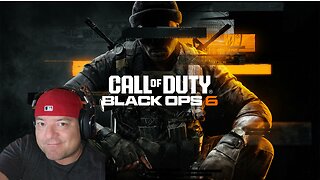 2:32:19
2:32:19
DemolitionDx
7 hours agoSunday night COD with friends.
79.8K3 -
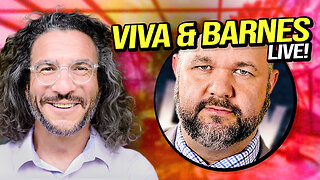 2:10:14
2:10:14
vivafrei
18 hours agoEp. 237: More Trump Cabinet Picks! MAHA or Slap in the Face? Canada on Fire! Go Woke Go Broke & MORE
213K269 -
 2:23:21
2:23:21
SOLTEKGG
8 hours ago $4.83 earned🟢 First Day on RUMBLE!
52.5K5 -
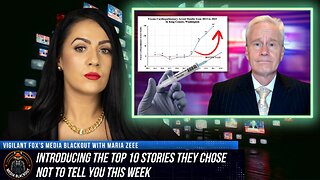 LIVE
LIVE
Vigilant News Network
12 hours agoCOVID-Vaccinated Hit With Grave New Reality | Media Blackout
1,820 watching -
 1:26:31
1:26:31
Josh Pate's College Football Show
11 hours ago $3.74 earnedSEC Disaster Saturday | Major CFP Earthquake Coming | Officiating Is A Disaster | New Studio Debut
35.4K2 -
 1:43:05
1:43:05
Adam Does Movies
15 hours ago $5.31 earnedGladiator II Spoiler Conversation With Hack The Movies
34.6K1 -
 24:10
24:10
Bwian
15 hours agoI Don't Know What I'm Doing in Fortnite, But I Still Won...
27.2K2 -
 19:30
19:30
DeVory Darkins
17 hours ago $44.53 earnedJoe Rogan MOCKS The View as Bill Maher HUMILIATES Woke Scientist
102K161 -
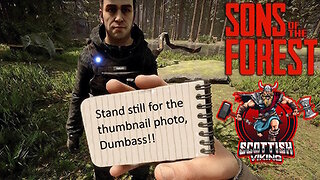 11:25:41
11:25:41
Scottish Viking Gaming
18 hours agoSUNDAY FUNDAY | Jump into my Sons of the Forest Game | DOO EET NOWWA!
98.5K1
